Intermec Technologies MC75 MC75 User Manual legal
Intermec Technologies Corporation MC75 legal
Contents
- 1. Users Manual
- 2. Compliance Insert
- 3. Final Users Manual part 1 of 2
- 4. Final Users Manual part 2 of 2
Final Users Manual part 2 of 2

Network Support—Chapter 4
101700 Series Color Mobile Computer User’s Manual
Properties
Select a COM Port from the Choose COM Port boxtoregisterforthis
device, then check Enable Wireless Printing to complete the COM port
registration. To change your COM port selection, clear (uncheck) the En-
able Wireless Printing box, select a new COM port, then check Enable
Wireless Printing again. Choose COM Port items already in use are
grayed out.
When you enable Wireless Printing, a status message is shown near the
bottom of the screen to confirm your action. To print a test page to your
printer, tap Print Test Page.
Check Default to set this printer to identify the assigned COM Port as the
WPPort in the registry. See the Bluetooth Resource Kit User’s Guide for
more details on WPPort.
Tap ok to return to the Wireless Printing page.
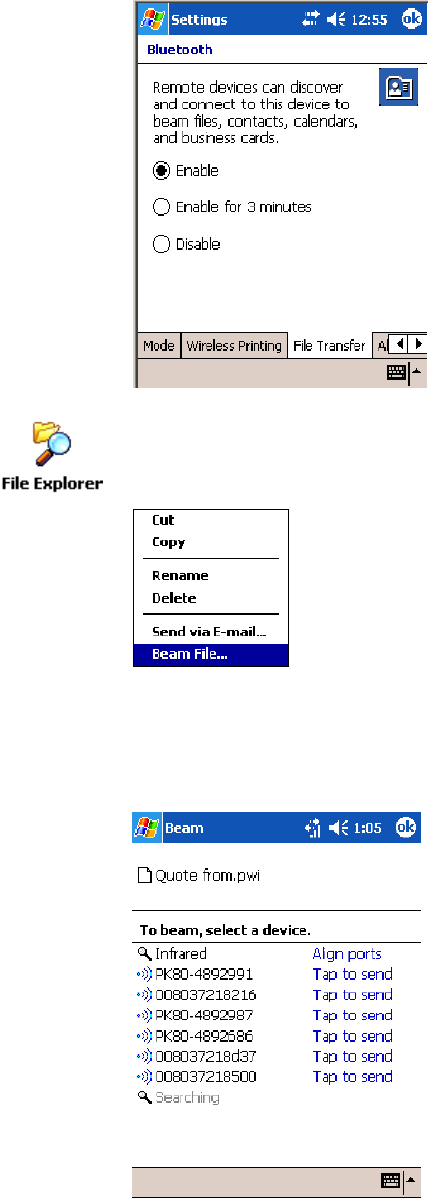
Network SupportChapter —4
102 700 Series Color Mobile Computer User’s Manual
File Transfer
Use this page to enable your unit to receive files from another Bluetooth
device, or from any device that supports this function.
This does not apply to the 730 Computer. From this point, this transfer is
similar to an IrDA file transfer. Tap Start >Programs >File Explorer,tap
to hold the file to transfer, then select Beam File from its pop-up menu.
The system searches for a list of Bluetooth devices that will accept a con-
nection from your unit. When the list is complete, tap on a device to
which to send the file. Note: in some cases, the user of the target device has to
“accept” the file before it is transmitted.
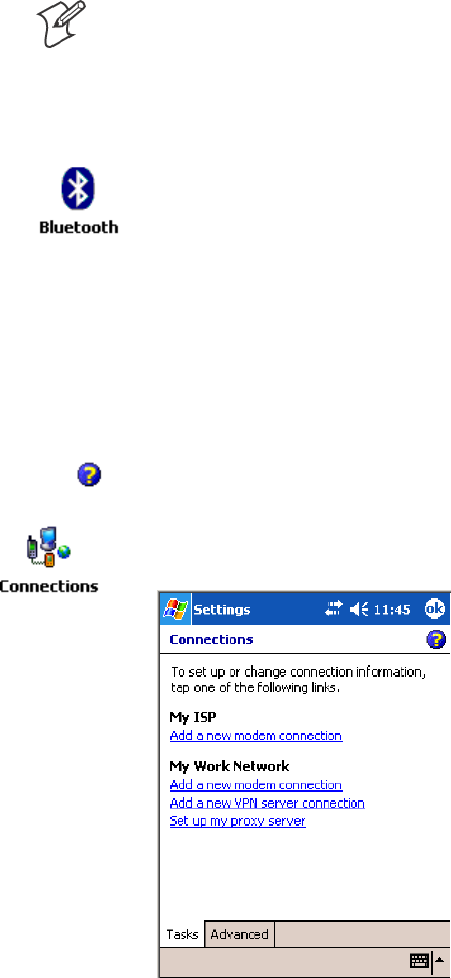
Network Support—Chapter 4
103700 Series Color Mobile Computer User’s Manual
Connecting with Bluetooth
Note: While these instructions apply to many Bluetooth devices, these in-
structions use the Nokia 3650 for example purposes.
Before you connect to the network, make sure Bluetooth is enabled on
your 700 Color Computer before discovering and connecting to remote
devices.
Tap Start >Settings >theConnections tab>theBluetooth icon. Tap On
to activate Bluetooth, then tap ok to exit the applet.
Also make sure Bluetooth is enabled on your mobile phone. For example,
with the Nokia 3650, go to its menu, select Connect >Bluetooth,thenset
My phone’s visibility to “Shown to all.”
Do the following to establish a Bluetooth connection between your 700
Color Computer and your mobile phone, then establishing a dial-up net-
working session with your wireless network. Once connected, you should
be able to browse Internet websites and use other online resources from
your 700 Color Computer.
To view additional information for any screen in the wizard or while
changing settings, tap the Help icon.
1Tap Start >Settings >theConnections tab>theConnections icon. In
My ISP,tapAdd a new modem connection.
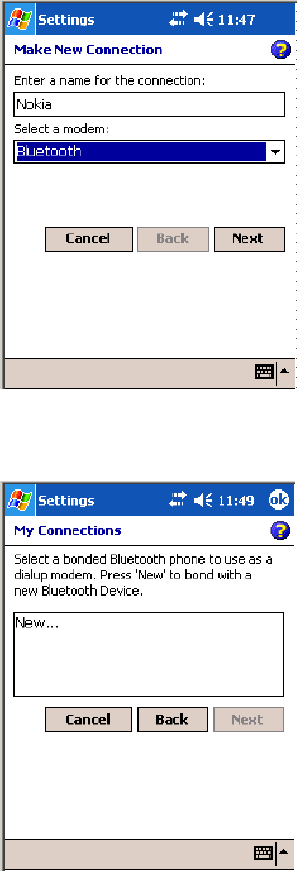
Network SupportChapter —4
104 700 Series Color Mobile Computer User’s Manual
2Enter a name for the connection, such as “Nokia.” In the Select a mo-
dem list, select “Bluetooth,” then tap Next to continue.
3Tap New... if the phone is not listed in the known devices. Make sure
your Bluetooth device is turned on before you start the search.
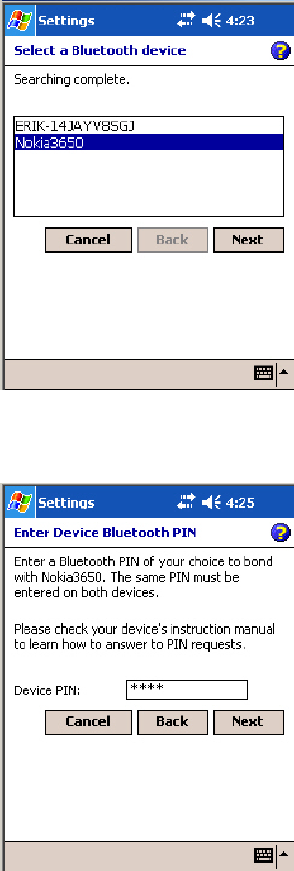
Network Support—Chapter 4
105700 Series Color Mobile Computer User’s Manual
4When the discovery of devices is complete, select your Bluetooth device,
then tap Next to continue.
5Enter the correct Device PIN on both the Bluetooth device and the 700
Color Computer, then tap Next to continue.
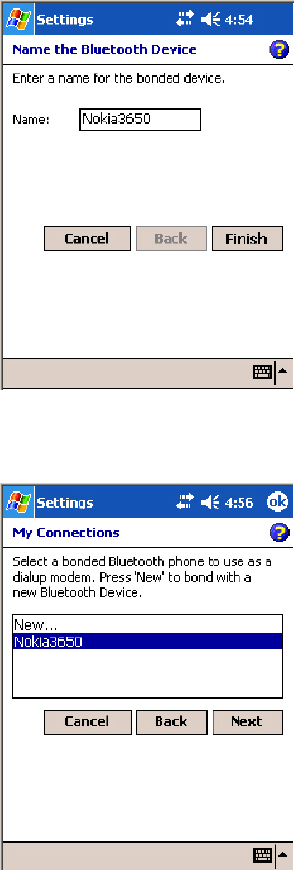
Network SupportChapter —4
106 700 Series Color Mobile Computer User’s Manual
6Enter a name for the device if needed, then tap Finish.
7After bonding completes, select your Bluetooth device from the list of
bonded devices, then tap Next.
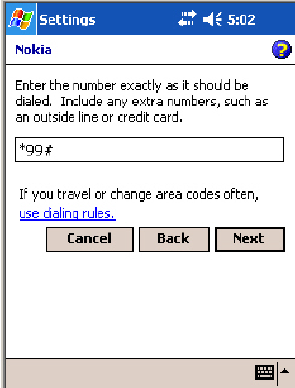
Network Support—Chapter 4
107700 Series Color Mobile Computer User’s Manual
8Enter the appropriate number as it should be dialed for your Bluetooth
connection, then tap Next to continue. Enter the user name, password,
and domain required for your Bluetooth device, then tap Finish.
Now you can establish a connection to your network via the Internet Ex-
plorer application. To disconnect, tap the Connectivity icon in the top
menu bar, then select Disconnect.
Local Area Networks
See the Developer’s Support web site for the latest information on network
adapters for your unit.
The 700 Color Computer is a versatile mobile computer that easily adds to
your wired or wireless data collection network. You can connect your 700
Color Computer to your network using either USB communications or
802.11b or 802.11b/g radio communications.
Configuring USB Communications
You can place the 700 Color Computer in a single dock, multidock, mo-
dem dock, or vehicle dock to transfer data to and receive data from anoth-
er device using USB communications. The USB cable, single dock, multi-
dock, modem dock, and vehicle dock are sold separately. For information
on accessories and how to order them, see “Accessories” on page 21.
To use USB communications with your 700 Color Computer
1Connect the dock to the USB port of the other device using an ap-
propriate USB cable.
2Make sure your USB device is configured for USB communications.
3Insert the 700 Color Computer into the dock.
4Turn on the 700 Color Computer.

Network SupportChapter —4
108 700 Series Color Mobile Computer User’s Manual
Configuring 802.11 Radio Communications
Caution: Make sure all components with antennas are at least 30 cm (1
ft) apart when power is applied. Failure to comply could result in
equipment damage.
The wireless 700 Color Computer has an internal 802.11b or 802.11b/g
radio to transfer data using wireless communications. This manual assumes
you already have set up your wireless communications network, including
your access points. If you are using a UDP Plus network, have your
Intermec Application Server communicate with a host computer. Your
700 Color Computer supports TCP/IP and UDP Plus.
Configuring the Network Parameters for a TCP/IP Network
In a TCP/IP network, the 700 Color Computer communicates with a host
computer directly using TCP/IP. The access point acts as a bridge to allow
communications between the wired and wireless networks.
1Configure the infrastructure mode, network name (SSID), host IP ad-
dress, and IP settings (if not using DHCP) on each 700 Color Comput-
er in the network.
2Configure security. Tap Start >Settings >theSystem tab>theWire-
less Network icon to access the Profile Wizard for the 802.11b or
802.11b/g radio module. Go to Appendix A, “Configurable Settings,”
for information.
Configuring the Network Parameters for a UDP Plus Network
In a UDP Plus network, the 700 Color Computer communicates with a
host computer through the Intermec Application Server. The Intermec
Application Server translates UDP Plus packets on the wireless network
into TCP/IP packets on the wired network and vice versa. The access
point acts as a bridge to allow communications between the wired and
wireless networks.
1Configure the network name (SSID), controller IP address, and IP set-
tings (if not using DHCP), and controller port (set to 5555) on each
700 Color Computer in the network.
2Configure security. Tap Start >Settings >theSystem tab>theWire-
less Network icon to access the Profile Wizard for the 802.11b or
802.11b/g radio module. Go to Appendix A, “Configurable Settings,”
for information.
The easiest way to configure the network parameters on the 700 Color
Computer is to use the Intermec Settings applet. Go to Appendix A,
“Configurable Settings.” for information.
Network Adapters
The 700 Color Computer can have up to three radios installed. The de-
fault network adapter or radio is dependent on what radios are installed in
your unit. The 700 Color Computer is capable of supporting 802.11i se-
curity requirements.
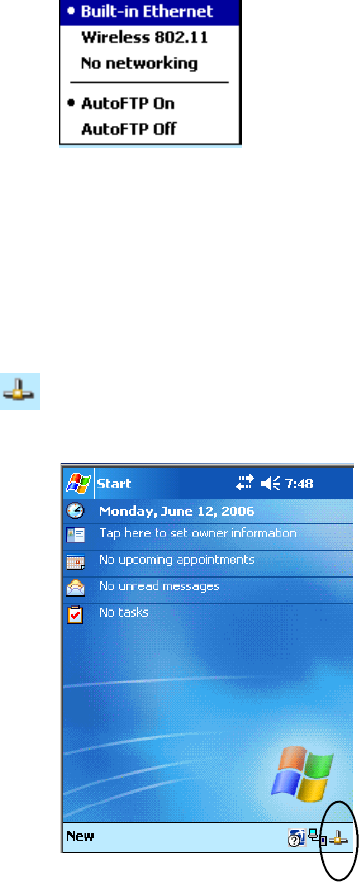
Network Support—Chapter 4
109700 Series Color Mobile Computer User’s Manual
With the NDISTRAY pop-up menu (the Network Driver Interface Speci-
fication tray application) from the System Tray, you can specify “802.11,”
“Ethernet,” or “No Networking” to load onto your 700 Color Computer
when a cold-boot is performed. When a warm boot is performed, the 700
Color Computer loads the network set just prior to the warm boot.
The 730 Computer only has the 802.11b radio and Bluetooth. It does not
have an external antenna. Other radios are not supported.
Ethernet Communications (740, 741, 750, 751, 760, 761 Computers)
Follow the steps below to start Ethernet communications on the 700 Color
Computer. If your system does not contain an 802.11b or 802.11b/g
radio, then Ethernet networking using DHCP is selected as the default.
When “Built-in Ethernet” is selected from the NDISTRAY pop-up menu,
then the Ethernet icon shown to the left appears in the System Tray as
circled in the following illustration.
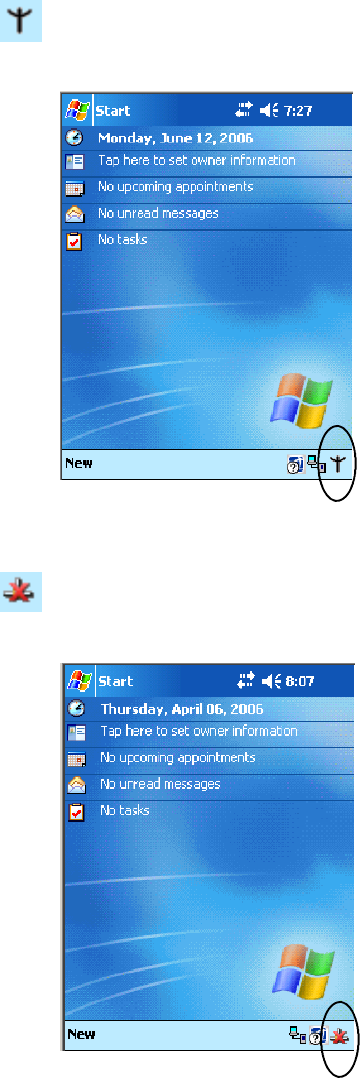
Network SupportChapter —4
110 700 Series Color Mobile Computer User’s Manual
Wireless 802.11 Communications
When “Wireless 802.11” is selected via the NDISTRAY pop-up menu,
the Wireless 802.11 antenna icon shown to the left appears in the system
tray as circled in the following illustration.
No Networking
When “No networking” is selected from the NDISTRAY pop-up menu,
the disconnected icon shown to the left appears in the system tray as
circled in the following illustration.
Network Selection APIs
The Network Selection APIs change the network adapter configuration
programmatically. Both drivers support the same IOCTL function num-
bers for loading and unloading the drivers. Go to Chapter 7, “Program-
ming,” to see the APIs.
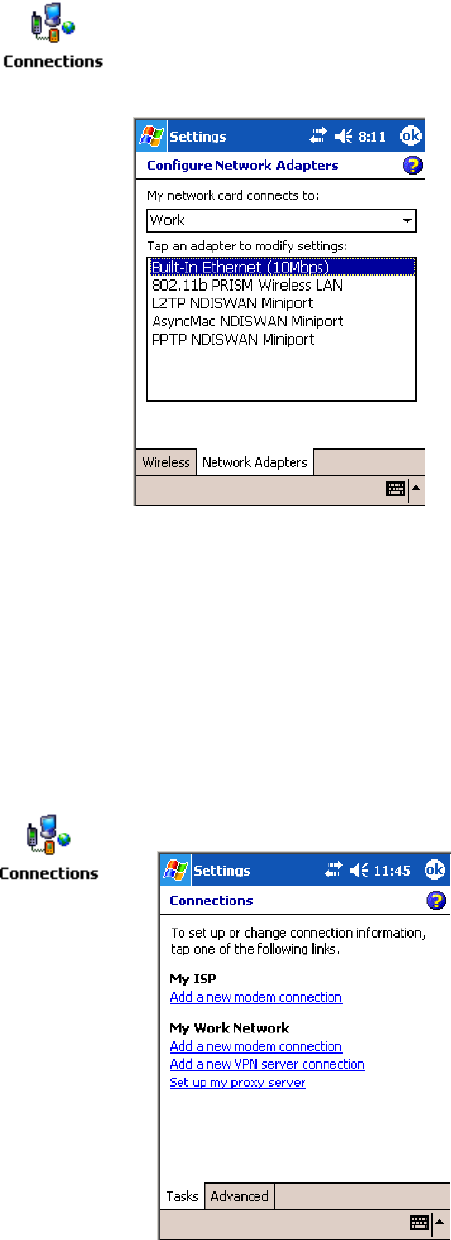
Network Support—Chapter 4
111700 Series Color Mobile Computer User’s Manual
Network Connections
From the 700 Color Computer, tap Start >Settings >theConnections
tab>theConnections icon > the Advanced tab > Network Card or the
Network Adapters tab to access the network connections for this unit.
Make the changes necessary for your network, then tap ok when finished.
Creating a Wireless Network Connection
Use the Wireless Network applet for more security choices and better
roaming behavior. See Appendix A for information.
Networks already configured are preferred networks and are listed in
Wireless networks. You can connect to only preferred networks or search
for and connect to any available network.
A wireless network can be added either when the network is detected, or
manually by entering settings information. To determine if authentication
information is needed, see your network administrator.
1Tap Start >Settings >theConnections tab>theConnections icon.

Network SupportChapter —4
112 700 Series Color Mobile Computer User’s Manual
2Tap the Advanced tab > Network Card >theWireless tab > Add New .
3Tap the General tab, then enter a network name. If the network was
detected, the network name is entered and cannot be changed.
From Connects to, select to what your network is to connect. If you
select “Work,” you can do a vpn connection or use proxy servers. If you
select “The Internet,” you can connect directly to the internet.
To connect to an ad-hoc connection, select This is a device-to-device
(ad-hoc) connection.
4Tap the Network Key tab, then do the following:
To Disable Authentication
aSet Authentication to either “Open” if WEP keys are not required;
or “Shared” when WEP keys are required for association.
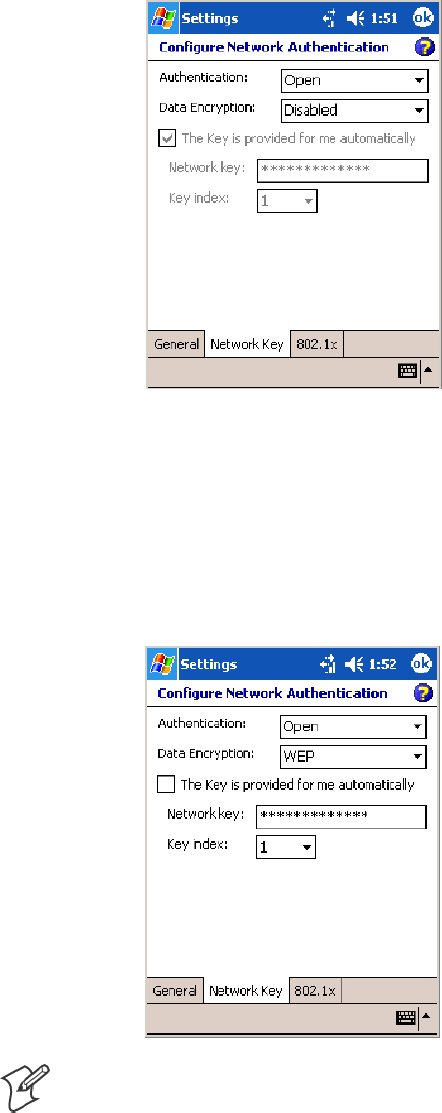
Network Support—Chapter 4
113700 Series Color Mobile Computer User’s Manual
bSet Data Encryption to “Disabled.”
To Enable WEP Encryption
aSet Authentication to either “Open” if WEP keys are not required;
or “Shared” when WEP keys are required for association.
bSet Data Encryption to “WEP.”
cTo change the network key, clear The Key is provided for me auto-
matically box, then enter the new Network key and select the ap-
propriate Key index.
Note: The following information applies when you have Enable Micro-
soft’s Wireless Zero Config checked via the Wireless Network applet (see
Appendix A, “Configurable Settings”).

Network SupportChapter —4
114 700 Series Color Mobile Computer User’s Manual
To Enable WPA Authentication (730, 751, 751, 761 Computers)
aSet Authentication to “WPA” (see page 236).
bSet Data Encryption to either “WEP” or “TKIP” (see page 236).
To Enable WPA Authentication Using a Preshared Key (730, 741, 751, 761 Computers)
aSet Authentication to “WPA-PSK” (see page 236).
bSet Data Encryption to either “WEP” or “TKIP” (see page 236).
cEnter the new Network key.
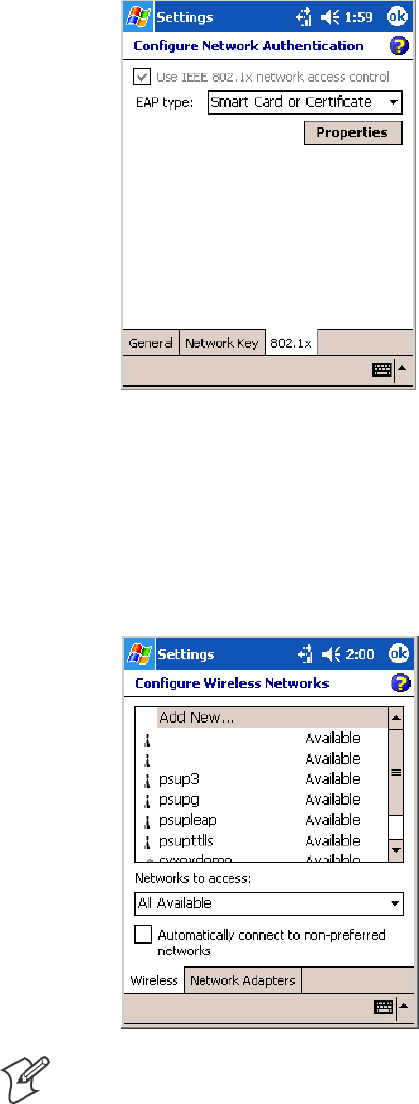
Network Support—Chapter 4
115700 Series Color Mobile Computer User’s Manual
5Tap the 802.1x tab, select either “PEAP” or “Smart Card or Certificate”
for the EAP type,thentapProperties to adjust its settings.
6Tap ok to return to the Configure Wireless Network screen.
7From the Networks to access drop-down list, select “All Available,”
“Only access points,” or “Only computer-to-computer” depending on
the type of networks to which you connect.
To connect only to networks you have already configured, clear Auto-
matically connect to non-preferred networks.Tapok to close this
screen.
Note: If you select to automatically connect to non-preferred networks,
your device detects any new networks and provide you the opportunity to
configure them.

Network SupportChapter —4
116 700 Series Color Mobile Computer User’s Manual
AutoIP/DHCP
Automatic Private IP Addressing (AutoIP) is enabled by default in
Windows Mobile 2003. To remain compatible with other versions of
Pocket PC, this setting needs to be enabled. You can configure the registry
settings in the following to set the required AutoIP/DHCP behavior:
SFor Ethernet: HKEY_LOCAL_MACHINE\Comm\LAN9001\TcpIp
SFot 802.11: HKEY_LOCAL_MACHINE\Comm\NETWLAN1\TcpIp
Other registry keys that can modify the behavior of AutoIP are as follows.
You can find the appropriate settings and behavior of each of these keys in
Microsoft Help.
SAutoInterval
SAutoMask
SAutoSubnet
SAutoIP
SAutoSeed
When a TCP/IP client cannot find a DHCP server, it generates an AutoIP
address from the 169.254.xxx.xxx block. The client then tries to check for
a DHCP server every 15 seconds and if a DHCP server is found, the client
drops the AutoIP address and uses the address from the DHCP server.
In the MSDN Windows CE documentation available out on the Micro-
soft Developer Network web site (www.msdn.com), see “Automatic Client
Configuration” for more information on AutoIP.
To disable AutoIP, set the AutoCfg registry entry to “0.” If a DHCP serv-
er cannot be found, instead of using AutoIP, the system will display the
“Unable to obtain a server assigned IP address” message.
Note: If you try to disable AutoIP using a CAB file to set the registry value
for AutoIP, remember to set the EnableDHCP value to “1” to keep
DHCP enabled
Note: To extend the number of attempts that a DHCP client makes to get
a DHCP address, use the DhcpRetryDialogue and DhcpMaxRetry registry
settings.
Note: Change the AutoInterval registry key value to make the client retry
more often to obtain a DHCP address.
Wide Area Networks
The 700 Color Computer does not support wide area networks.
Phone Applications
The following phone applications apply to certain configurations. See the
chart on page 98 to learn which applies to your 700 Color Computer.
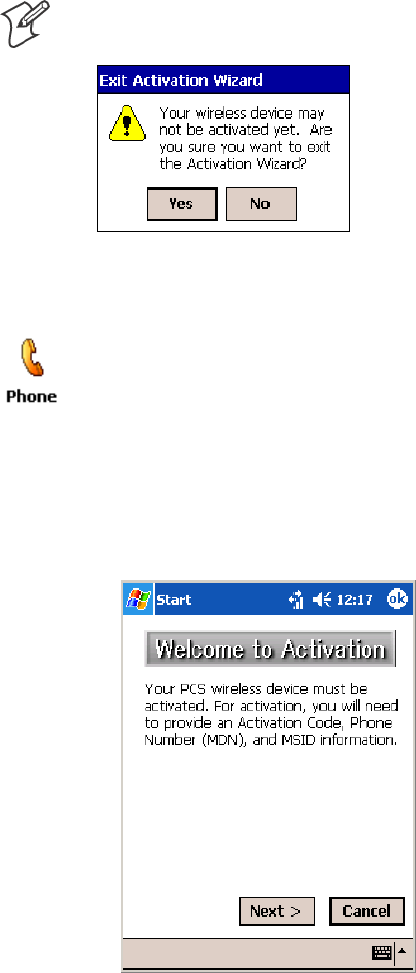
Network Support—Chapter 4
117700 Series Color Mobile Computer User’s Manual
Microsoft Phone Application (761 Computers with CDMA Radios)
With the WAN radio module installed in your 761 Computer, you can
send and receive telephone calls. Use the speaker on the back of the com-
puter as your earpiece and use the connector on the bottom of the com-
puter for your mouthpiece.
Data Provisioning (Sprint)
Note: If you wish to do this activation another time, tap Cancel to close
this wizard, then tap Yes.
It is necessary to initiate activation before using your Microsoft Phone ap-
plication. Below are the instructions:
1Tap Start >Programs >thePhone desktop icon or tap Start >Phone
from the Today screen to access the application which processes your
phone calls. Tap the Close button in the upper right corner of this ap-
plication to close.
2From the Phone application, tap Tools >Activation Wizard.
3Have your activation code, phone number (MDN), and MSID infor-
mation ready before you tap Next to continue. You can get this infor-
mation from your network provider.

Network SupportChapter —4
118 700 Series Color Mobile Computer User’s Manual
4Enter your 6-digit activation code, then tap Next to continue.
5Enter the phone number and MSID from Sprint, tap Next to continue.
6The application prompts whether the information entered is correct. If
so, tap Yes to continue, else tap No to return to the previous screen.
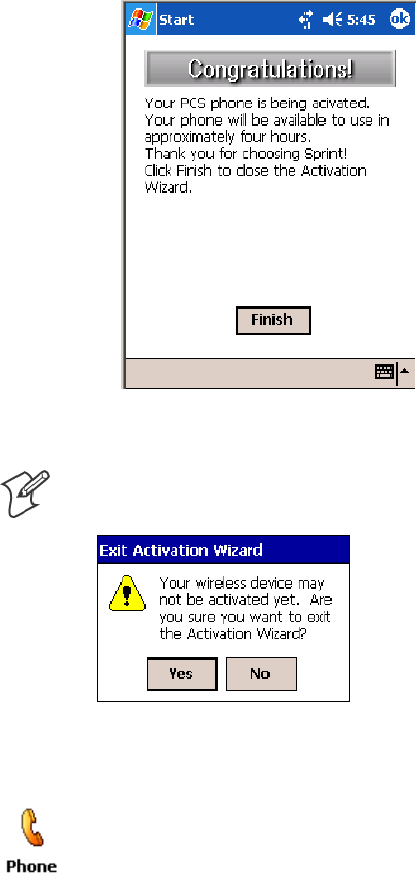
Network Support—Chapter 4
119700 Series Color Mobile Computer User’s Manual
7Note that voice service is available immediately. Data service take a
minimum of four hours of activation before you can use the service. If
after four hours, a data connection is not established, see “Data Provi-
sioning” on page 117 to manually launch data provisioning.
The application acknowledges that your phone will be in service in four
hours. Tap Finish to close the wizard.
Data Provisioning (Verizon)
Note: If you wish to do this activation another time, tap Cancel to close
this wizard, then tap Yes.
It is necessary to initiate activation before using your Microsoft Phone ap-
plication. Below are the instructions:
1Tap Start >Programs >thePhone desktop icon or tap Start >Phone
from the Today screen to access the application which processes your
phone calls. Tap the Close button in the upper right corner of this ap-
plication to close.
2From the Phone application, tap Tools >Activation Wizard.
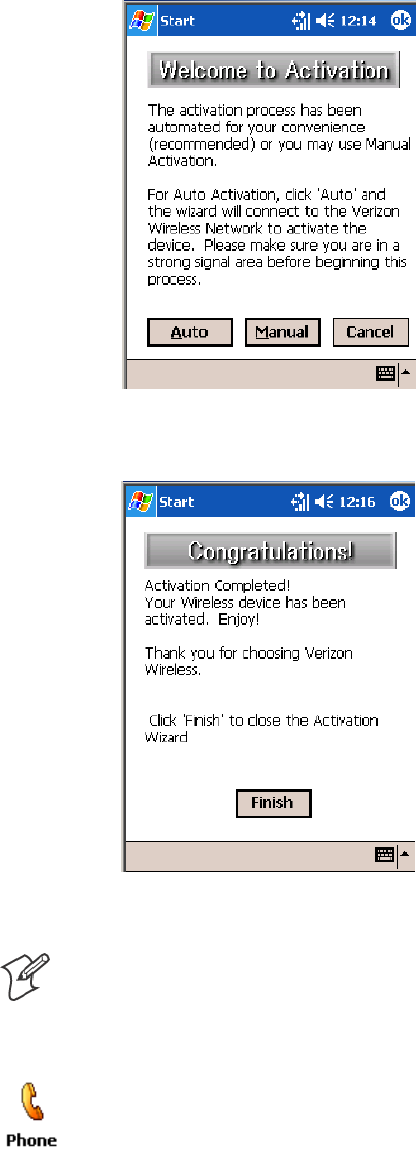
Network SupportChapter —4
120 700 Series Color Mobile Computer User’s Manual
3Tap Auto to initiate the activation.
4The application acknowledges that your phone is now in service. Tap
Finish to close the wizard.
Phone Application
Note: Wait at least four hours after Sprint activation is complete before
using this application. Data provisioning should occur automatically. Net-
work information about your 761 Computer needs to propagate through
the Sprint Network after the activation is complete.
If data provisioning does not occur automatically, tap Start >Settings >
the Personal tab>thePhone icon. Tap the Data tab, then tap Provision
to initiate a session.

Network Support—Chapter 4
121700 Series Color Mobile Computer User’s Manual
Tap the appropriate keys to enter a telephone number, then tap Talk to
dial the number. Tap End to “hang up” the phone.
Tap this to dial the phone number
shown above the keypad.
Tap this to backspace one digit.
Tap this to select a previously
dialed number.
Tap this to view your previous calls.
Tap this to “hang up” your current
call.
Tap this to access the Contacts application.
Tap this toggle the mute option.
Tap this to access the Notes application.
Speed Dial
Tap Speed Dial to select a telephone number with which the 761 Com-
puter is to dial automatically. To add to this list, use the Contacts applica-
tion. See Chapter 2, “Windows Mobile 2003,” for more information
about the Contacts application.
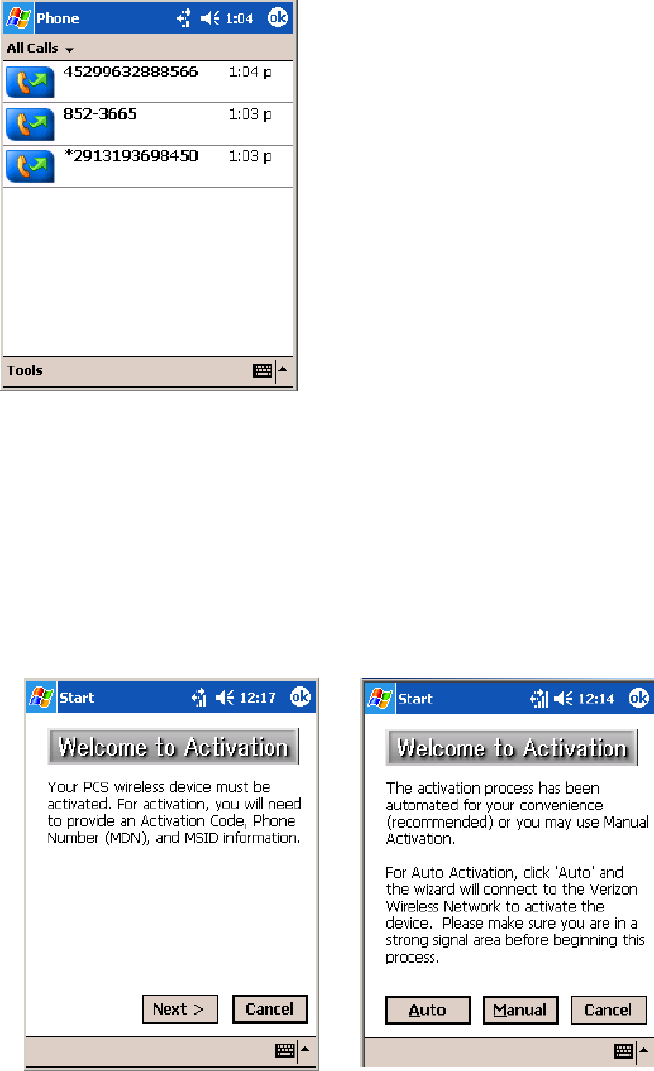
Network SupportChapter —4
122 700 Series Color Mobile Computer User’s Manual
Call History
Tap Call History to note the telephone numbers that were previously
dialed from this 761 Computer.
Tools
Use the Tools menu to send a voice mail, access the Activation Wizard,
send an SMS email message, or configure phone settings.
STap Tools >Voice Mail to call and leave a voice message.
STap Tools >Activation Wizard to access the wizard with which to acti-
vate your 761 Computer. Be sure to have an activation code, a phone
number, and MSID information ready. See page 117 for instructions on
using this wizard.
Sprint Networks Verizon Networks
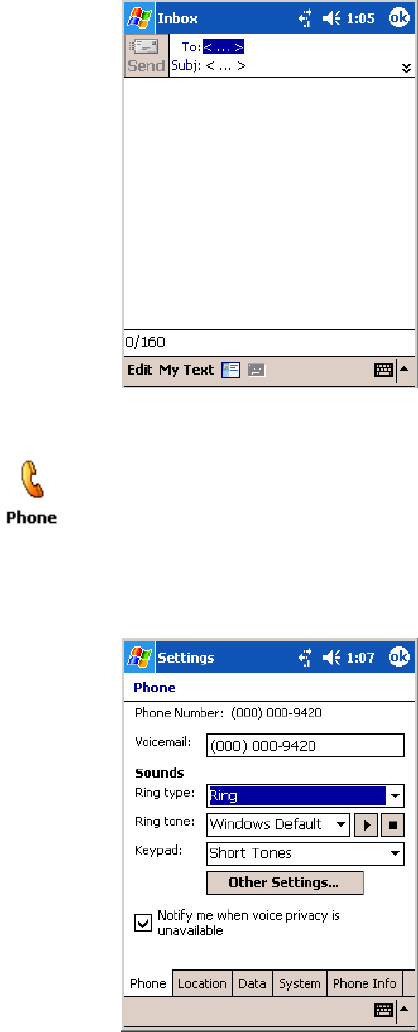
Network Support—Chapter 4
123700 Series Color Mobile Computer User’s Manual
STap Tools >Send SMS tab to access the Inbox application and send an
SMS (Short Messaging Service) message. Be sure to have an SMS num-
ber ready to send the message — this is usually the mobile phone num-
ber. See Chapter 2, “Windows Mobile 2003,” for Inbox information.
Phone Settings
Either select Tools >Options from the Phone application or select Start >
Settings >thePersonal tab>thePhone icon to access the applet.
STap the Phone tab to customize your phone settings such as the ring
type and ring tone to use for incoming calls, and the keypad tone to use
when entering phone numbers. Tap Other Settings to go to the Sounds
& Notifications applet. Select Start >Help for more information.
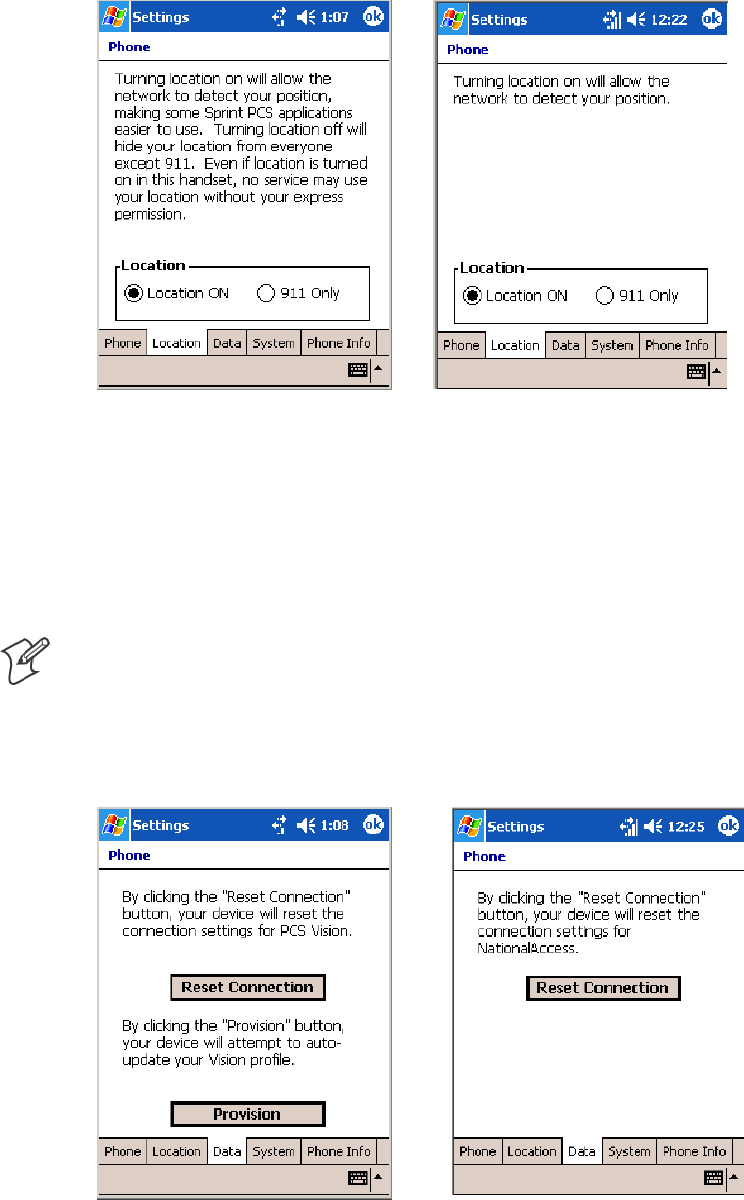
Network SupportChapter —4
124 700 Series Color Mobile Computer User’s Manual
STap the Location tab to toggle between your location being visible for
everyone to detect and hiding your location from everyone except 911.
Sprint Networks Verizon Networks
STap the Data tab to either reset your connection settings for PCS Vi-
sion or update your PCS Vision profile.
For Sprint Networks, if your 761 Computer is unable to make a data
connection and it has been more than four hours since activation, you
can launch data provisioning from this screen. Tap Provision,thenfol-
low the prompts. It takes a few minutes to set up the data connections.
Note: The data provisioning process can be automatically initiated by
the Sprint network, by attempting to make a cellular line connection to
the WAN before the 761 Computer is data provisioned, or by manually
starting the connections through this screen. Intermec recommends that
Sprint Network “push” the data provisioning to your unit. This should oc-
cur shortly after the voice activation is complete.
Sprint Networks Verizon Networks
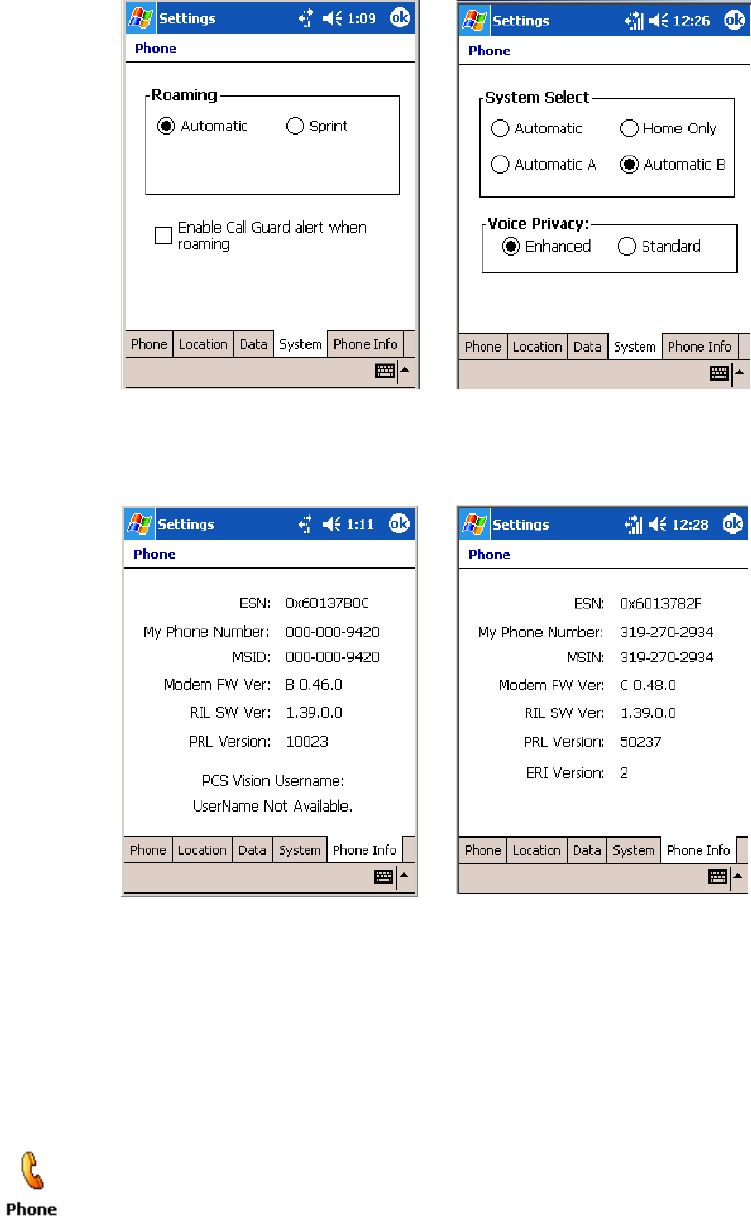
Network Support—Chapter 4
125700 Series Color Mobile Computer User’s Manual
STap the System tab to select the applicable function.
Sprint Networks Verizon Networks
STap the Phone Info tab to view the phone settings.
Sprint Networks Verizon Networks
Microsoft Phone Application (761 Computers with GSM Radios)
With the WAN radio module installed in your 761 Computer, you can
send and receive telephone calls. Use the speaker on the back of the com-
puter as your earpiece and use the connector on the bottom of the com-
puter for your mouthpiece.
Tap Start >Settings >thePhone desktopiconfromthePersonal tab or
tap Start >Phone from the Today screen to access the application which
processes your phone calls. Tap the Close button in the upper right corner
of this application to close.
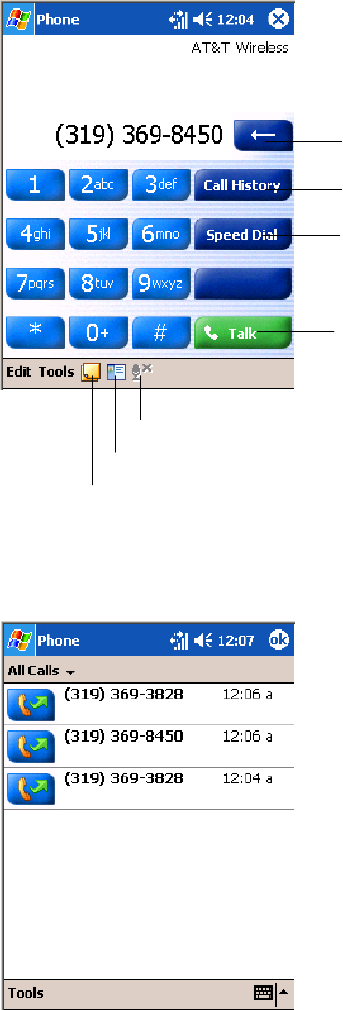
Network SupportChapter —4
126 700 Series Color Mobile Computer User’s Manual
Activation
The GSM phone is activated via a SIM card that you can purchase from
your network provider.
Phone Application
Tap the appropriate keys to enter a telephone number, then tap Talk to
dial the number.
Tap this to dial the phone number
shown above the keypad.
Tap this to backspace one digit.
Tap this to select a previously
dialed number.
Tap this to view your previous calls.
Tap this to access the Contacts application.
Tap this toggle the mute option.
Tap this to access the Notes application.
Call History
Tap Call History to note the telephone numbers that were previously
dialed from this 761 Computer.

Network Support—Chapter 4
127700 Series Color Mobile Computer User’s Manual
Speed Dial
Tap Speed Dial to select a telephone number with which the 761 Com-
puter is to dial automatically. To add to this list, use the Contacts applica-
tion. See Chapter 2, “Windows Mobile 2003,” for more information
about the Contacts application.
Tools
Tap Tools >Send SMS tab to access the Inbox application and send an
SMS (Short Messaging Service) message. Be sure to have an SMS number
ready to send the message — this is usually the mobile phone number. See
Chapter 2, “Windows Mobile 2003,” for information about Inbox.
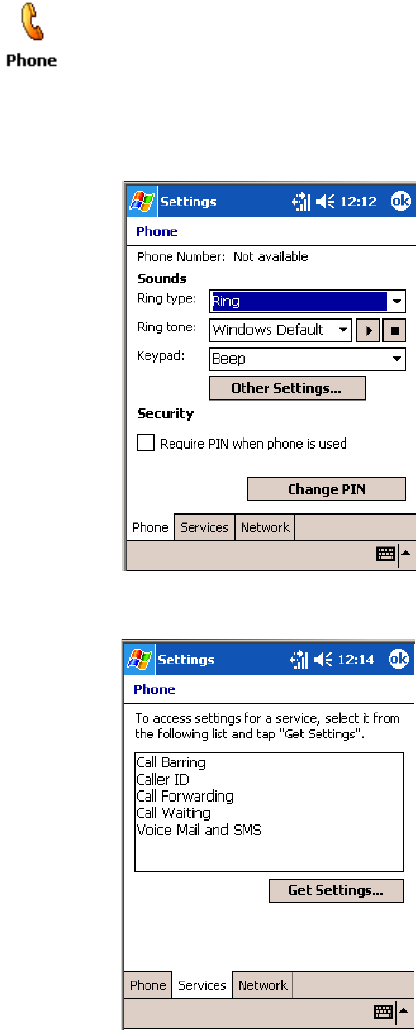
Network SupportChapter —4
128 700 Series Color Mobile Computer User’s Manual
Phone Settings
Either select Tools >Options from the Phone application or select Start >
Settings >thePersonal tab>thePhone icon to access the applet.
STap the Phone tab to customize your phone settings such as the ring
type and ring tone to use for incoming calls, and the keypad tone to use
when entering phone numbers. Tap Other Settings to go to the Sounds
& Notifications applet.
STap the Services tab to access settings for any of the provided services.
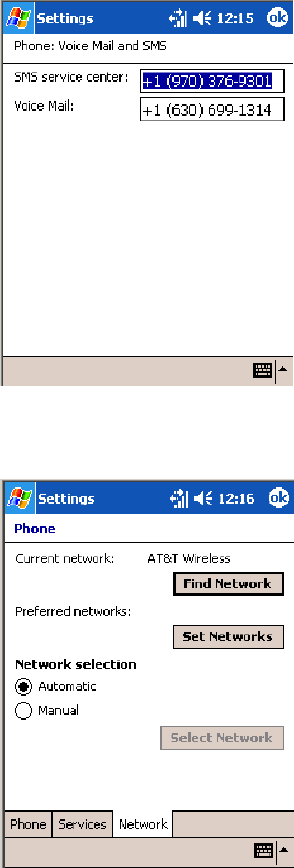
Network Support—Chapter 4
129700 Series Color Mobile Computer User’s Manual
Tap any of the settings, then tap Get Settings.Makeyourchanges,then
tap ok to return to the Settings screen. Below is a sample Settings
screen.
STap the Network tab to find, set, or select the type of network on
which this phone is to communicate.
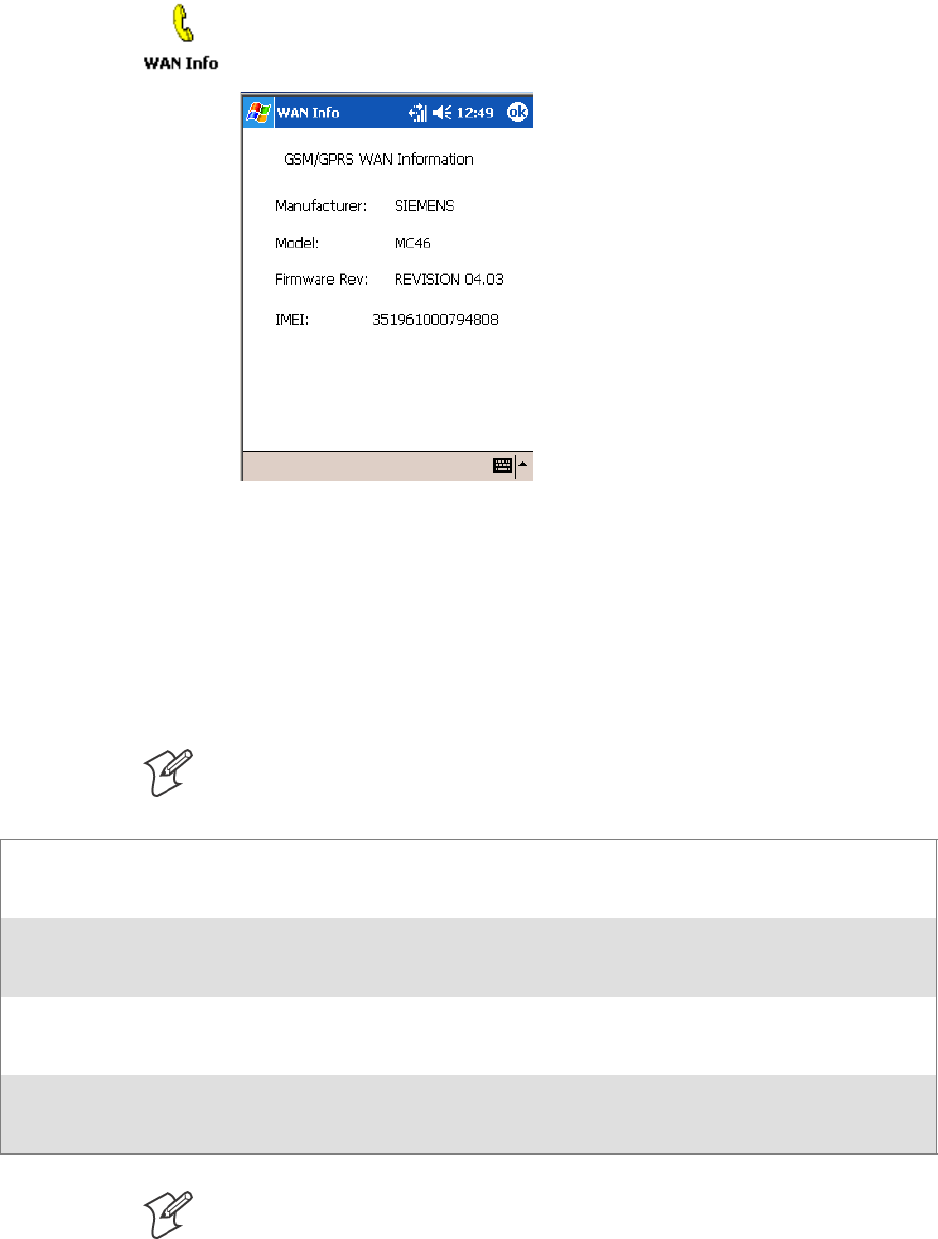
Network SupportChapter —4
130 700 Series Color Mobile Computer User’s Manual
Phone Information
To learn the latest phone settings, including the manufacturer, model,
firmware rev, and IMEI, select Start >Settings >theSystem tab, then tap
the WAN Info desktop icon. Tap ok when finished.
SB555 Watcher (760 Computers with CDMA Radios)
The SB555 Watcher program is used on the 760 Computer with CDMA
radios only. Use this primarily to activate the WAN radio. Once the WAN
radio is activated, you can remove the SB555 Watcher program from the
760 Computer.
This tells you how to set up your CDMA radio in your 760 Computer.
Below are terms to familiarize you with CDMA radio technology:
Note: Set up and provision information is also available in the 700 Color
CDMA Radio Setup Quick Start Guide P/N: 962-054-063.
Activation The process of programming the radio with the lock code (MSL) and phone number (MIN) to
allow it to communicate on the provider’s network. Once activation is complete you can make
voice calls (if enabled by the carrier) with the mobile computer.
Data Provisioning The process of activating the ability for the CDMA radio to establish data connections, such as
connecting to the Internet. The CDMA radio makes data connection only after it is activated
and data provisioned.
NID (Network ID) A numeric value programmed into the CDMA radio at the factory or during the activation
process. Your carrier may or may not use this value, but your carrier may provide this for ac-
tivation purposes.
SID (System ID) A numeric value programmed into the CDMA radio at the factory or during the activation
process. This number is used by your carrier to determine if the radio belongs to its CDMA
network. Your carrier may provide this number for activation purposes.
Note: Descriptions in this chapter are for Sprint PCS, Bell Mobility, Te-
lus, and Verizon Networks versions of the SB555 Watcher program. Oth-
er carriers may be added pending regulatory and carrier approval.
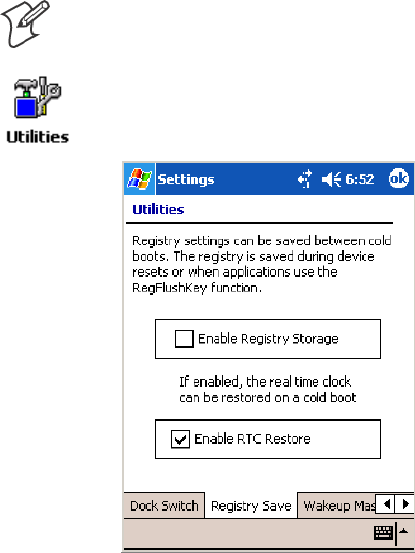
Network Support—Chapter 4
131700 Series Color Mobile Computer User’s Manual
Copying CDMA Radio Module CAB Files from Intermec Web Site
Copy CAB files from the Intermec web site at www.intermec.com onto
your desktop. Intermec recommends one of two methods with which to
load these CAB files onto your 760 Computer:
Svia the Microsoft ActiveSync application
Svia a CompactFlash or Secure Digital storage card. See Chapter 3,
“Installing Applications,” for information about these methods.
Via Microsoft ActiveSync
You can transfer files from your desktop to your 760 Computer via Micro-
soft ActiveSync. See Chapter 2,“Windows Mobile 2003” for more infor-
mation about ActiveSync.
1Obtain software from the Intermec web site as described earlier. Down-
load the software to any location on your 760 Computer, such as the
Temp folder via the My Device root location.
2Tap the carrier CAB file to install the application.
3Go to “Finishing the Installation” on page 132.
Via a CompactFlash or Secure Digital Storage Card
Note: These instructions are based on default locations. You can change
the location to which to copy your CAB files.
1Make sure the Registry Restore feature on your 760 Computer is dis-
abled. Select Start >Settings >theSystem tab. Tap the Utilities desk-
top icon, the Registry Save tab, then clear the Enable Registry Save box.
2Copy the CAB files for your carrier to your CompactFlash or Secure
Digital storage card after downloading it from the web site.
3Cold-boot your 760 Computer. Remove the AB10 battery pack and
press the reset button in the bottom of the battery compartment.
4Go through the normal getting started steps detailed in your 700 Color
CDMA Radio Setup Quick Start Guide.
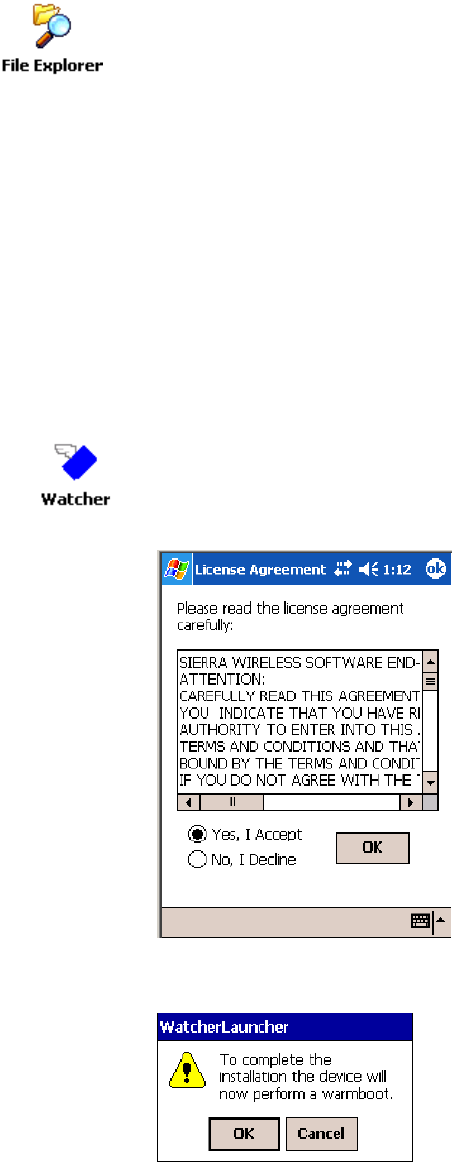
Network SupportChapter —4
132 700 Series Color Mobile Computer User’s Manual
5Install the CompactFlash or Secure Digital memory card into the card
slot in your 760 Computer. Note that if you do not want the CAB files
erased after installation, set the CAB file attributes to “read-only” after copy-
ing them to the storage card.
6Tap Start >Programs >theFile Explorer icon on the 760 Computer.
7Tap the pull-down menu for My Documents and tap the My Device
root location.
8If you are using a CompactFlash storage card,
tap Storage Card.
If you are using an Secure Digital storage card,
tap SDMMC Disk.
9Scroll down, tap the Sprint Watcher CAB file to install the application.
Finishing the Installation
Do the following to run the SB555 Watcher application. Be sure to do
step 1 as it is important to perform a warm-boot on your 760 Computer.
Upon restart, the Watcher application sets up on the 760 Computer for
activation.
1Tap Start >Programs >theWatcher icon.
2Tap Yes, I accept to accept the license agreement, tap OK to continue.
Note this license agreement does not appear again after this installation.
3Tap OK for the 760 Computer to perform a warm-boot.

Network Support—Chapter 4
133700 Series Color Mobile Computer User’s Manual
Activation
Note: Set the date and time before doing this activation.
SB555 Watcher is for activation and data provisioning. Once you enable
voice capability, data capability, or both depending on the carrier, remove
this program from the system by cold-booting your computer.
Do not use the SB555 Watcher to make data/voice calls on a daily basis:
SThe SB555 Watcher application is a third-party application unaware of
certain power management methods used in your 760 Computer. Therefore,
the application consumes more power than necessary.
SThe application size consumes memory better used for application data.
The process of setting up the account with your carrier and enabling the
CDMA WAN radio in your 760 Computer is called activation. To proper-
ly function, program the CDMA device with the necessary information
and set up the network carrier account. If either piece has errors, the de-
vice does not function on the CDMA network.
The CDMA radio is pre-programmed for a specific carrier, such as Sprint,
Telus, Bell Mobility, Verizon, etc.). Therefore, information about your
radio should already be in your carrier’s database.
You need to notify the carrier and set up mobile accounts for each unit
you are activating. The Electronic Serial Number (ESN hex 63xxxxxx)
that you need to supply to your carrier is located in two places:
SOn the outside of the 760 Computer shipping box.
SOn the inside of the 760 Computer battery compartment. The label
includes the term “ESN” and a bar code along with the serial number.
The ESN comes in both decimal and hexadecimal formats. Most carriers
accept either format, but with a preference for the decimal format. You
only need to provide one number to your carrier.
SThe decimal format consists of 11 digits, beginning with “099.”
SThe hexadecimal format is an 8-digit number, beginning with “63.”
Accounts for Verizon and Sprint carriers can be set up for data only. Cana-
dian carriers (Telus and Bell Mobility) can be set for data only, voice only,
or both voice and data. This is determined by your application and the
services your carrier offers.
After the all ESNs are provided to the carrier and the carrier has estab-
lished the accounts, you will be provided with the lock codes and tele-
phone numbers needed to complete the activation process. You use the
SB555 Watcher program to accomplish this task. Note this for future use.
Note: Ensure that you receive a spreadsheet with your order that calls out
all ESNs in both decimal and hexadecimal formats.
Note: Keep the activation information for your devices in a safe, accessible
place should you have any future issues.
Note: Not all of the elements listed are required by all service providers.
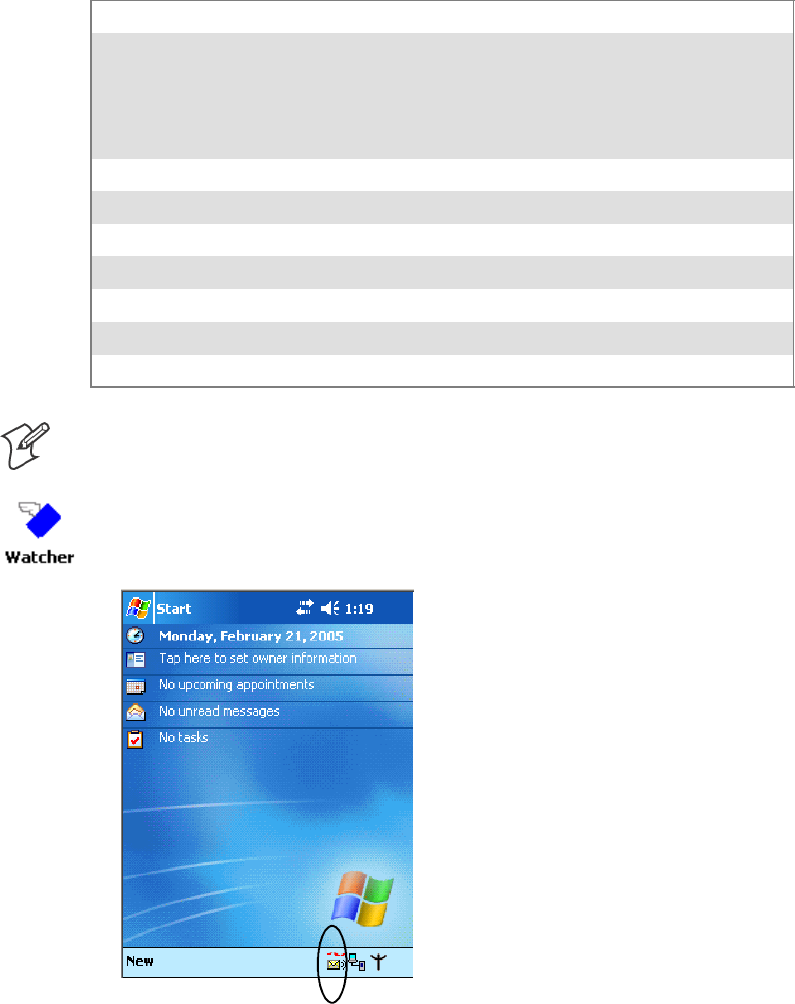
Network SupportChapter —4
134 700 Series Color Mobile Computer User’s Manual
ESN of the modem
Lock/ActivationCode(maybetermedoneofthefollowing):
SMSL — Master Subsidy Lock
SOTSL — OneTime Subsidy Lock
SSPC — Service Provisioning Code
SOTKSL — One Time Key Subsidy Lock
SID (System ID)
NID (Network ID)
User Name
Password
MIN
MSD
MDN
Note: The activation process for your Watcher version may vary from the
following steps. Thus, you may not have to do all of them.
1Tap Start >Programs >theWatcher icon or tap the Watcher icon from
the NDISTRAY via the Today screen (circled in the following illustra-
tion) to launch the SB555 Watcher program.
2The Activation Wizard should start automatically. If not, then tap
Admin >Activation Wizard from the bottom of the screen.
3Tap Next to move from one screen prompt to the next.
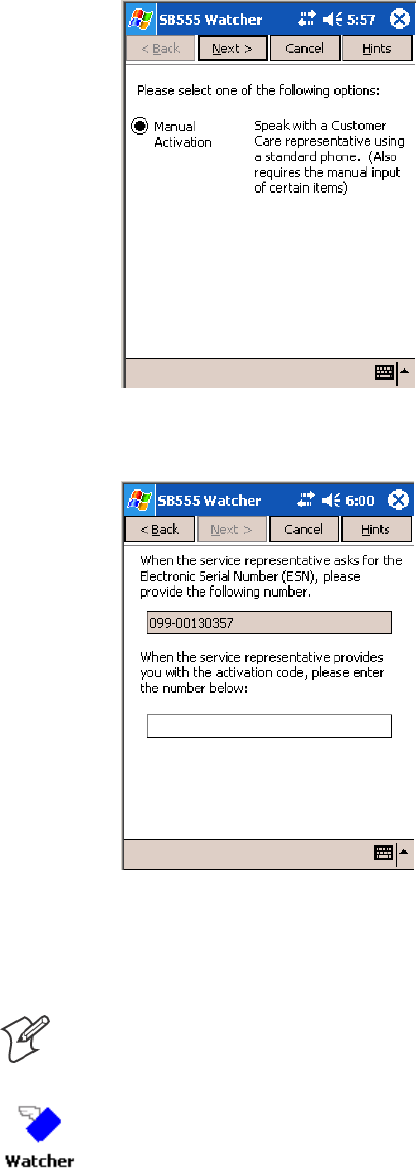
Network Support—Chapter 4
135700 Series Color Mobile Computer User’s Manual
4When you reach the Activation screen, select Manual Activation.
5At the appropriate screen, enter the Activation Code (OTSL, MSL,
OTKSL, or SPC) provided by your carrier and tap Next.
6Enter the phone number provided when your 760 Computer was acti-
vated and tap Next.
Verizon Automated Activation Process
Note: This process takes approximately 60 seconds.
Do the following to activate Verizon on your 760 Computer:
1Tap Start >Programs >theWatcher icon.
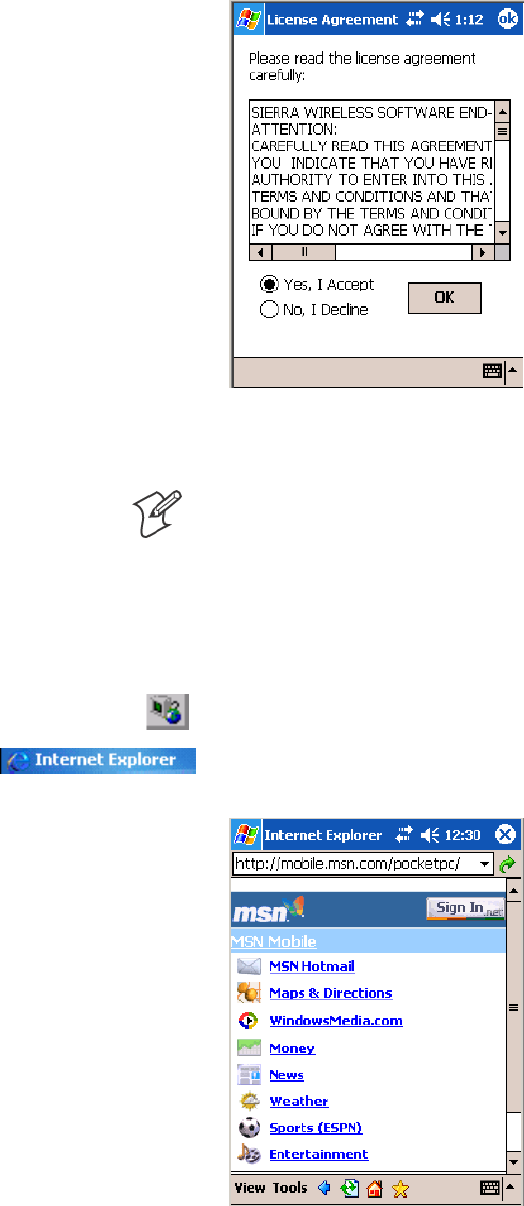
Network SupportChapter —4
136 700 Series Color Mobile Computer User’s Manual
2Tap Yes, I accept to accept the license agreement, tap OK to continue.
Note this license agreement does not appear again after this installation.
3Select OK to initiate the warm-boot, then after the warm-boot, start the
Watcher program again, select Automated Activation,thenclickNext.
Note: YoumustbeintheVerizoncoverageareatoactivateyour760
Computer and only in the location of intended use.
4Click Next,clickNext again to dial the number displayed on the screen.
5The activation process starts automatically.
6You will see a series of unlock codes on your screen.
7Click the Connect button to connect to the carrier’s network.
8Select Start >Internet Explorer, then choose a web site. Your unit is
now successfully activated.
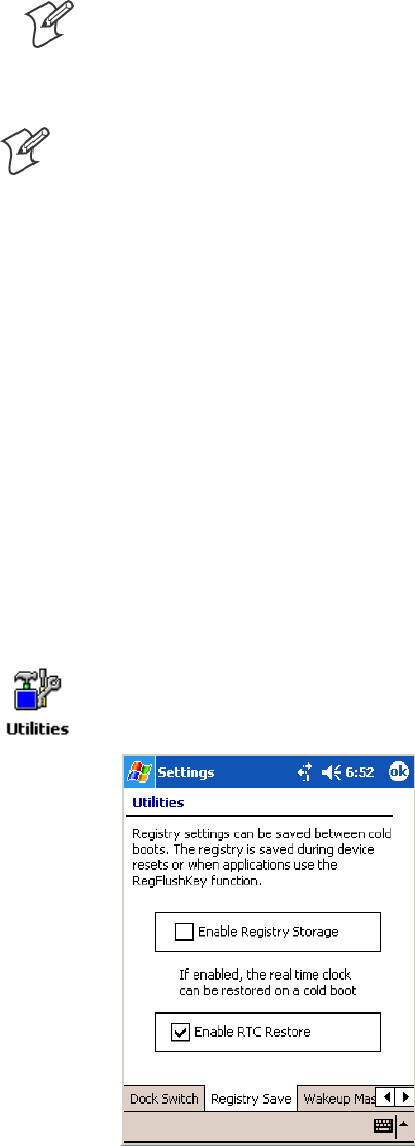
Network Support—Chapter 4
137700 Series Color Mobile Computer User’s Manual
9Perform a cold-boot on your 760 Computer to uninstall the Watcher
application, which is intended for activation purposes only. Use the fol-
lowing for establishing and maintaining connection to the WAN radio:
SCustom application using Intermec WWAN Toolkit API
SCustom customer application using Connection Manager Interface
Note: When connecting to the WAN radio via Pocket PC Connection
Manager, use the 10-digit phone number@vzw3g.com for the user
name (such as 1234567890@vzw3g.com) and “vzw” for the password.
Sprint Automated Activation Process
Note: Sprint PCS uses a data provisioning method termed IOTA (Internet
Over The Air) to complete its activation and data enablement. These steps
detail how to properly activate and data provision your 760 Computer.
1Give Sprint your ESN (either on the box or on a label inside the battery
compartment), rate plan, and account information. The label would in-
clude the term “ESN” and a bar code along with the serial number.
2Sprint provides you with the following for each ESN:
SMDN, such as 214-555-5555
SMSID, such as 214-555-5555
SMSL/OTKSL (Activation Code), such as 945614
SNAI (Network Access Identifier), such as the following:
CustomerName103@sprintpcs.com
Use a Secure Digital storage card with only the Sprint_Watcher_PPC_
2002-03xxx.CAB file in the “\SDMMC\Cabfiles” folder. Other CAB files
in the “\SDMMC\Cabfiles” folder may cause problems with testing, re-
move or uninstall these before proceeding. At least 80% (4 of 5 bars)
CDMA signal strength for a successful over-the-air activation.
Download and Activate Sprint Watcher
1Make sure the Registry Restore feature on your 760 Computer is dis-
abled. Select Start >Settings >theSystem tab. Tap the Utilities desk-
top icon, then the Registry Save tab. Clear Enable Registry Save.
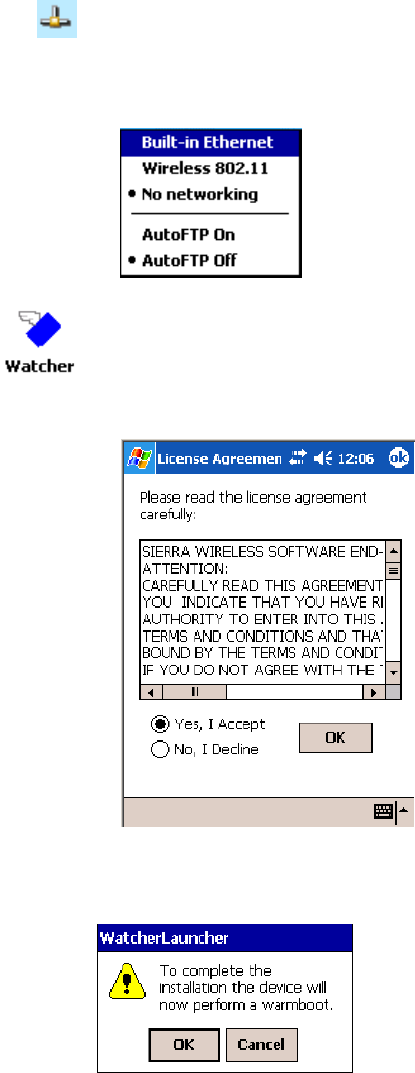
Network SupportChapter —4
138 700 Series Color Mobile Computer User’s Manual
2Perform a cold-boot on your 760 Computer, then go through the nor-
mal Pocket PC set-up (i.e. Align Screen etc.).
3Important! Set the Date and Time.
4Tap the Sprint_Watcher_PPC_2002-03xxx.CAB file to perform the
installation.
5Perform a warm-boot on your 760 Computer to load the CAB file.
6From the Today screen, tap the LAN Network icon in the System Tray.
7In the NDISTRAY pop-up menu (the Network Driver Interface Speci-
fication tray application), select No Networking and Auto FTP Off.
Tap anywhere on the screen to close the menu.
8Tap Start >Programs >theWatcher icon to launch the SB555 Watch-
er program.
9Tap Yes, I accept to accept the license agreement, then tap OK to con-
tinue. This license agreement does not appear again after this installation.
Tap OK for the 760 Computer to perform a warm-boot and complete the
installation.
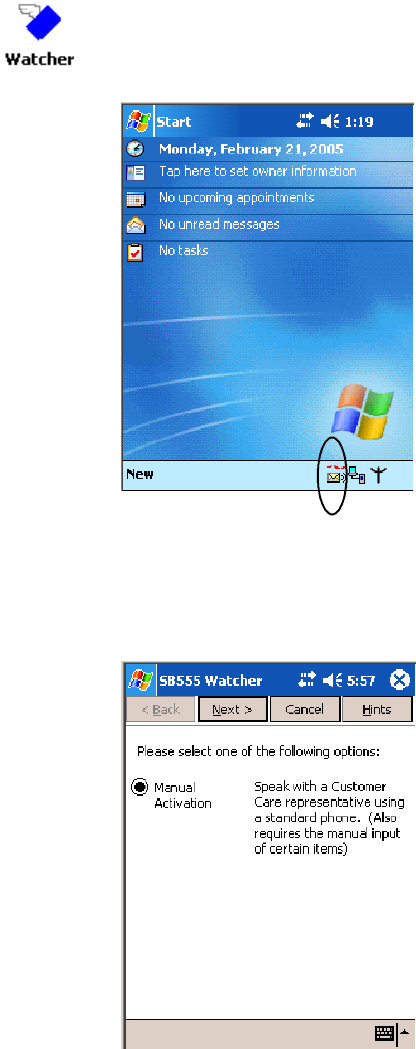
Network Support—Chapter 4
139700 Series Color Mobile Computer User’s Manual
Using Sprint Watcher
Before you start using the Sprint Watcher application, make sure you
match the correct ESN with each 760 Computer and that you have at least
80% CDMA signal strength.
TheESNthatyougivetoyourprovideriseitherontheboxoronalabel
inside the battery compartment. The label would include the “ESN” term
and a bar code along with the serial number.
1Tap Start >Programs >theWatcher icon or tap the Watcher icon from
the NDISTRAY via the Today screen (circled in the following illustra-
tion) to launch the SB555 Watcher program.
2If your 760 Computer was not previously activated, Watcher automati-
cally starts the Activation Wizard. Otherwise, select Manual Activation
to continue.
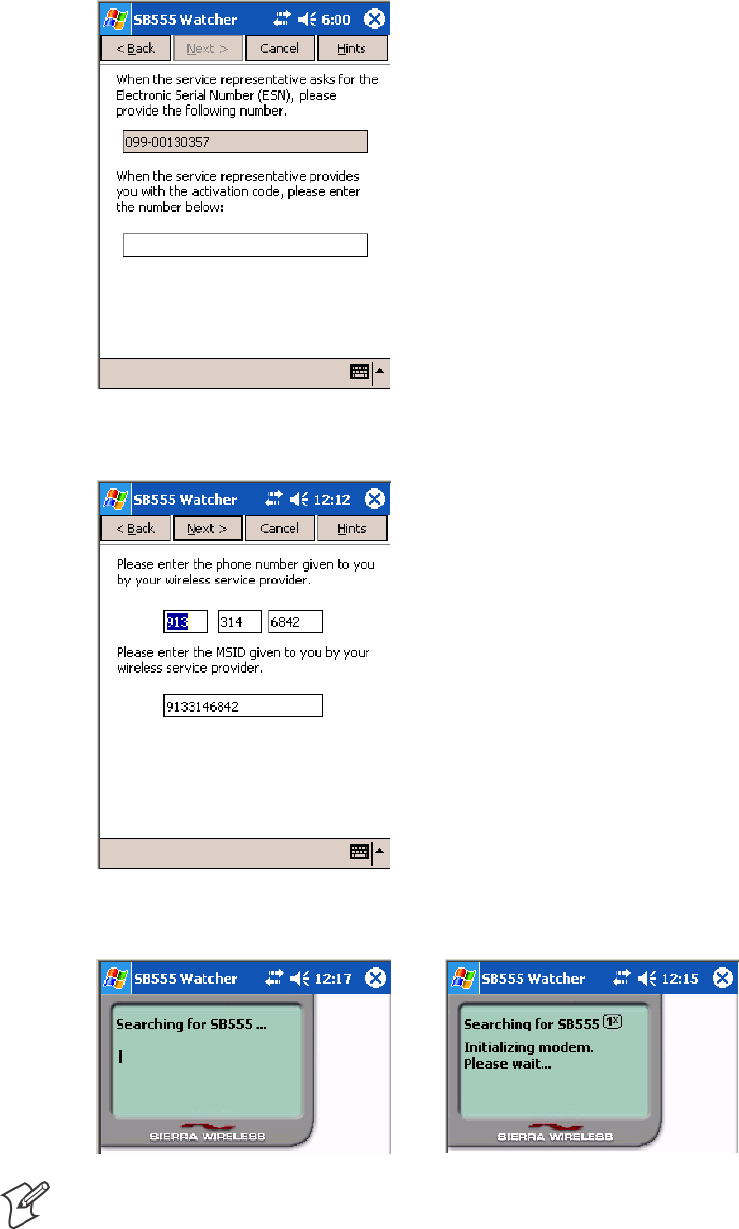
Network SupportChapter —4
140 700 Series Color Mobile Computer User’s Manual
3Enter the MSL or lock code received from Sprint.
4Enter the phone number (MIN) and MSID received from Sprint.
These numbers may be the same.
5After entering the phone number and MSID, the modem then resets
and the Watcher application displays the screens shown here:
Note: If the “searching for SB555” screen does not proceed to the next
screen after 30-40 seconds, perform a warm-boot on your 760 Comput-
er, then restart the Watcher program.
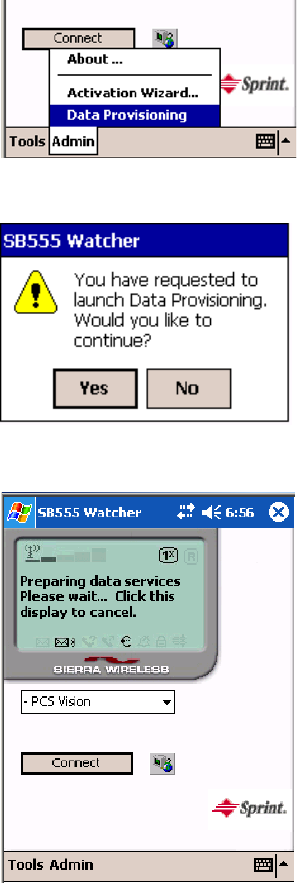
Network Support—Chapter 4
141700 Series Color Mobile Computer User’s Manual
Data Provisioning
At this point, the activation on the Sprint network is complete. It is rec-
ommended by Sprint to wait before you launch data provisioning to allow
time for the activation to propagate through your Sprint network.
Before you manually launch data provisioning, wait at least 30 minutes. In
some cases, you may have to wait up to two hours.
1If Data Provisioning does not start automatically, select Admin >Data
Provisioning from the bottom menu bar.
2Tap Yes to proceed with data provisioning.
3Activation over the air typically takes 1–20 minutes.
If data provisioning fails, do the following:
SIf Data Provisioning fails and the message “could not prepare data ser-
vices, please contact Sprint” displays, retry the Data Provisioning step by
tapping the “Admin” menu icon at the bottom of the Watcher screen.
Select “Data Provisioning...” and answer “yes” to the request.
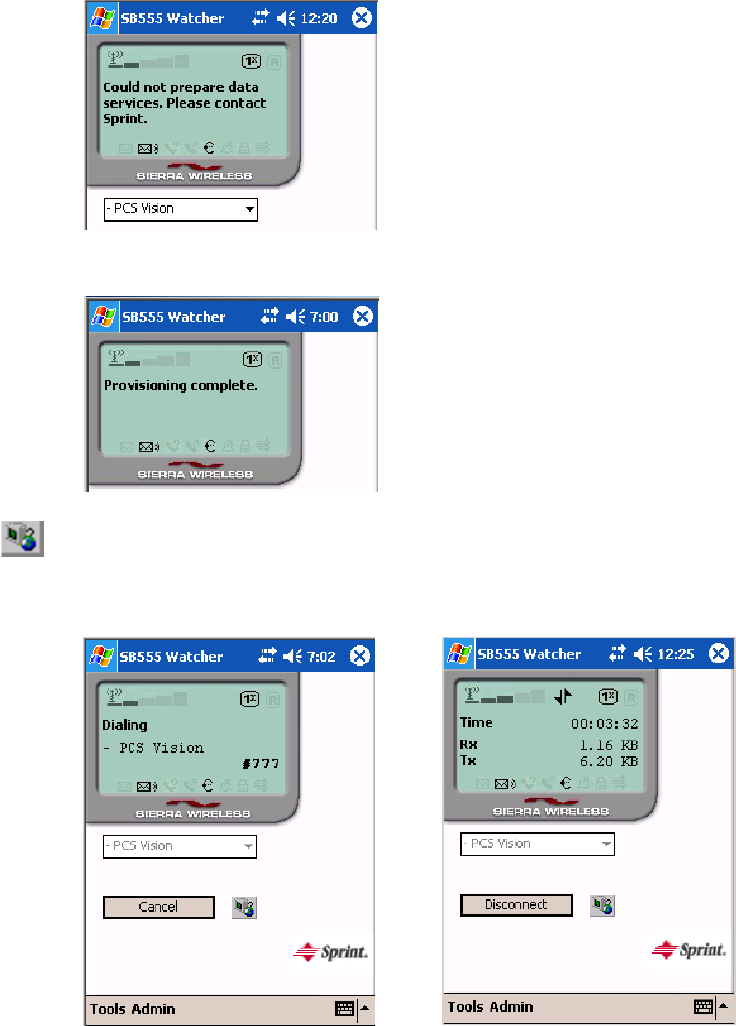
Network SupportChapter —4
142 700 Series Color Mobile Computer User’s Manual
SIf after several attempts to complete the Data Provisioning over the air,
it may be necessary to manually enter the data activation method.
SGo to Intermec Knowledge Central www.intermec.com, then select Ser-
vice & Support >Knowledge Central) to learn about manual activa-
tion. The article (number 5749) is titled How to Manually Activate a
Sprint CDMA WAN Radio in the 760 Device.
4The following screen appears once data provisioning is complete:
5Test the data connection by tapping on the “connect” button to make a
data connection to the network. Watcher progresses through the follow-
ing two screens. Once you see the second screen you know that your
mobile computer has successfully connected to the 1XRTT network.
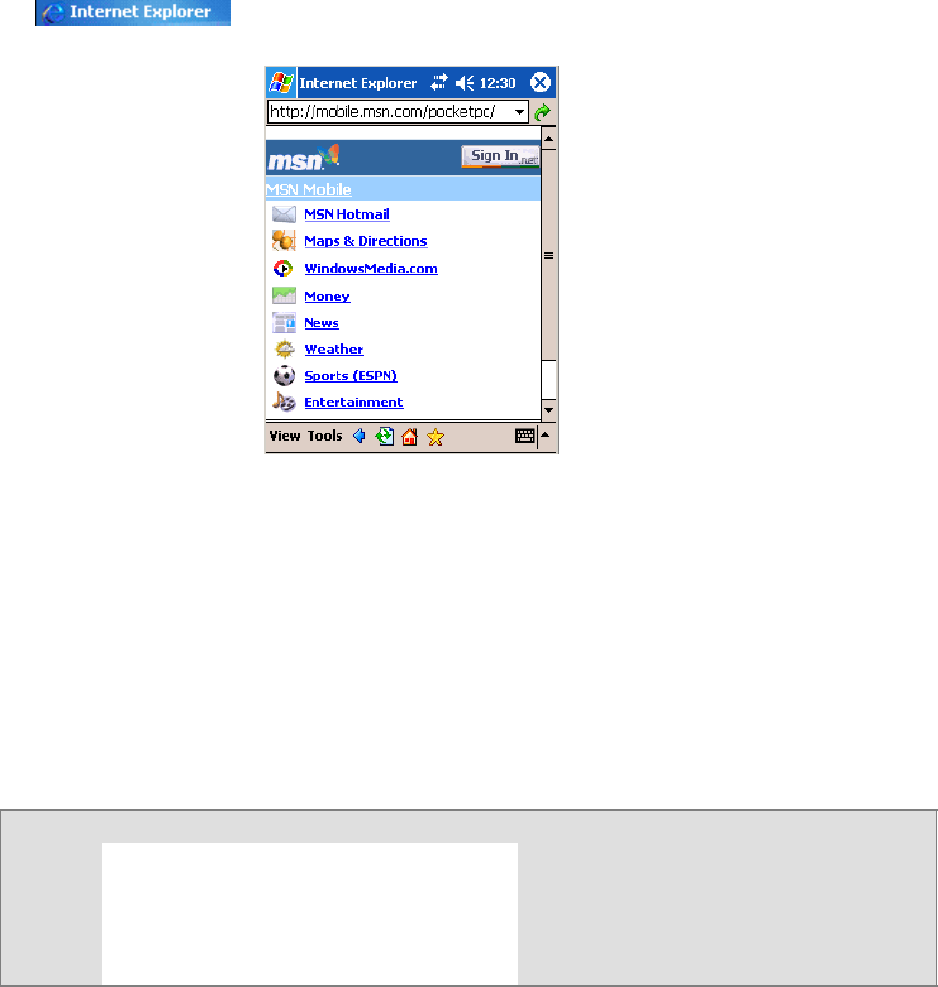
Network Support—Chapter 4
143700 Series Color Mobile Computer User’s Manual
6Select Start >Internet Explorer,thentapPocket Internet Explorer to
choose a web site. Your unit is now successfully activated.
Perform a cold-boot on your 760 Computer to uninstall the Watcher ap-
plication. Watcher is intended for activation purposes only. Use the fol-
lowing to establish and maintain connection to the WAN radio:
SCustom application using Intermec WWAN Toolkit API
SCustom customer application using Connection Manager Interface
Telus and Bell Mobility Activation
Activation of Bell Mobility and Telus are similar to the first portion of the
Sprint activation process. Follow the instructions for manual activation
using the Bell Mobility Watcher.CAB or Telus Watcher.CAB file to install
the applicable application. Enter the activation lock codes and phone num-
bers as requested.
Bell Mobility Telus
Username 10 digit phone
number@1xbell.ca
10-digit phone
number@1x.telusmobility.com
Password Original Voice Mail system password (usually a 4
digit #) available from activating organizations.
The 11-digit ESN printed inside the 760 Comput-
er battery compartment, begins with 099.
SID 16420 16422
AT Command Interface (760 Computers)
This interface specification is based on the following recommendation:
SETSI GSM 07.05:
European Digital Cellular Telecommunication System (phase 2)
Use of DTE-DCE interface for Short message and cell broadcast service.
SETSI GSM 07.07:
European Digital Cellular Telecommunication System (phase 2)
AT command set for GSM Mobile Equipment.
SITU-T Recommendation V.25 ter
Serial asynchronous automatic dialing and control.
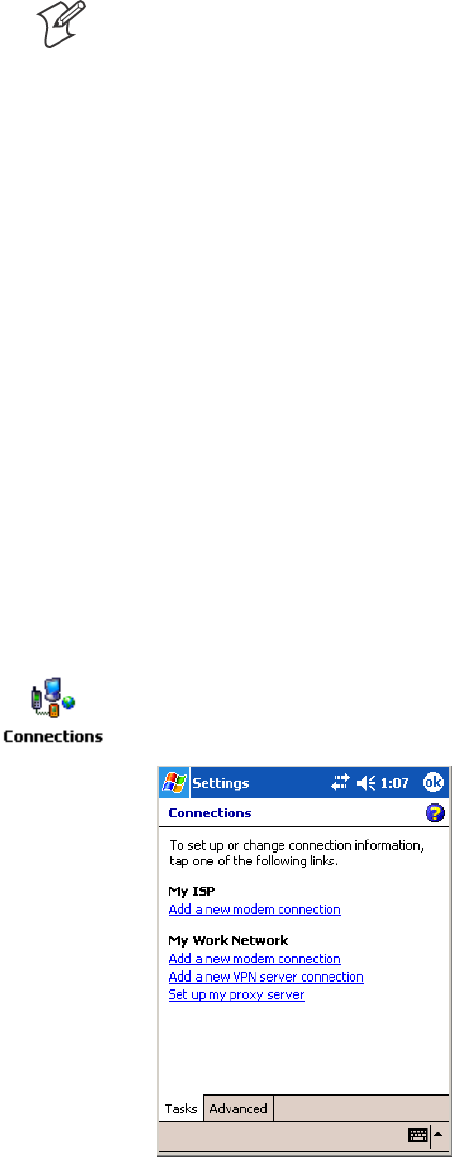
Network SupportChapter —4
144 700 Series Color Mobile Computer User’s Manual
Note: You need the Adobe Acrobat Reader application to view a PDF doc-
ument. Go to www.adobe.com/prodindex/acrobat/readstep.html to install
or download the latest Adobe Acrobat Reader.
Command Set for Sierra Wireless SB555
Use the AT command interface from Sierra Wireless to program the
CDMA/1xRTT SB555 radio module. Documentation for this interface is
available via the following URL. Click the “General AT command refer-
ence” link for a PDF document, which is 680 KB in size.
Command Set for Siemens MC45, MC46, or MC75
Use the MC45, MC46, or MC75 AT command interface from Siemens
AG to program the GPRS/GSM MC45, MC46, or MC75 radio module.
The following documentation is available either from Intermec or from
Siemens AG. Contact either your Intermec representative or the Siemens
AG support personnel for information.
SMC45 Siemens Cellular Engine AT Command Set
SMC46 Siemens Cellular Engine AT Command Set
SMC75 Siemens Cellular Engine AT Command Set
Testing the AT Commands (760, 761, 761B)
These commands can be sent to either WAN radio by setting up a dial-up
networking connection. Do the following to initiate this connection and
test these commands to your radio. These screens are from a 760 Computer.
1From the 760, 761, or 761B Computer, select Start >Settings >the
Connections tab > Connections.UnderMy ISP,tapAdd a new mo-
dem connection.

Network Support—Chapter 4
145700 Series Color Mobile Computer User’s Manual
2Enter a name for the connection, select the appropriate modem (as
listed here) from the Select a modem drop-down list, then tap Next to
continue.
S760 Computers “WANA on COM4”
S761 Computers “WANB on COM5”
S761B Computers “Virtual WANB”
3Enter a phone number as it should be dialed, then tap Next to continue.
Select Start >Help for more information or tap use dialing rules to
make modifications. Note that this screen may vary based on dialing rules.
Note that when you make a manual dial-up connection, a number is
not required. You may type in any number with at least one digit.

Network SupportChapter —4
146 700 Series Color Mobile Computer User’s Manual
4Tap Advanced to adjust the baud rate.
5Select the appropriate baud rate (as listed here) from the Baud rate
drop-down list.
S760 Computers 115200
S761 Computers 57600
S761B Computers 110

Network Support—Chapter 4
147700 Series Color Mobile Computer User’s Manual
6Tap the Port Settings tab, check Enter dialing commands manually,
tap ok,thentapFinish to return to the Connections screen.
7Tap Manage existing connections from the Connections page, press
and hold the new connection for a pop-up menu, then tap Connect to
initiate the connection.
8Wait about ten seconds for the Network Log On screen, then tap OK.
You do not need to enter information within the Network Log On screen.
Use either the onscreen keyboard, or press the keys to type any of the AT
commands provided. Press or tap Enter to send each command. The re-
sults of each command sent will print onscreen. Note that each “AT” com-
mand must start with the “at” characters.
STo see what you typed onscreen, type “ate1” to initiate the AT Echo
command, then press Enter.
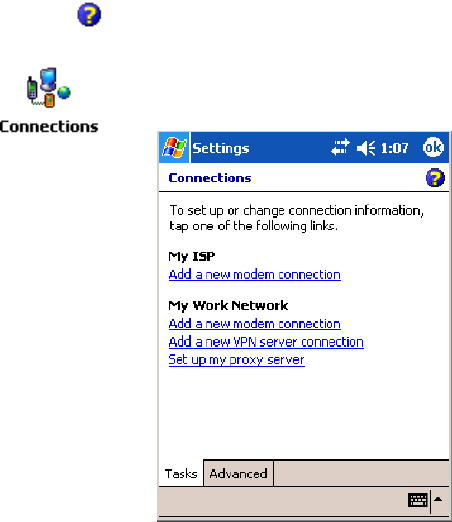
Network SupportChapter —4
148 700 Series Color Mobile Computer User’s Manual
Remote Access (Modems)
You can set up connections to the Internet and corporate network at work
to do such activities as browsing the Internet or intranet, sending and re-
ceiving e-mail and instant messages, and synchronizing information using
ActiveSync. Connections can be made using a wireless network.
Your 700 Series Computer has two groups of connection settings: My ISP
and My Work Network. Use My ISP settings to connect to the Internet.
Use My Work Network settings to connect to any private network.
SMy ISP: Once connected, you can send and receive e-mail messages by
using Inbox and view Web or WAP pages by using Pocket Internet Ex-
plorer. The communication software for creating an ISP connection is
already installed on your 700 Series Computer. Your service provider
provides the software needed to install other services, such as paging and
fax services. If this is the method you want to use, see “Connecting to
an Internet Service Provider” below.
SMy Work Network: Connect to the network at your company or orga-
nization where you work. Once connected, you can send and receive
e-mail messages by using Inbox, view Web or WAP pages by using
Pocket Internet Explorer, and synchronize with your desktop. If this is
the method you want to use, see “Connecting to Work” on page 151.
Connecting to an Internet Service Provider (ISP)
You can use your ISP connection to do e-mail and Web or WAP pages.
Get your dial-up access telephone number, user name, and password from
your ISP. Note some require additional information, such as MSN/username.
To see more information regarding any screen in the wizard or while
changing settings, tap the Help icon.
1Tap Start >Settings >theConnections tab>theConnections icon. In
My ISP,tapAdd a new modem connection.
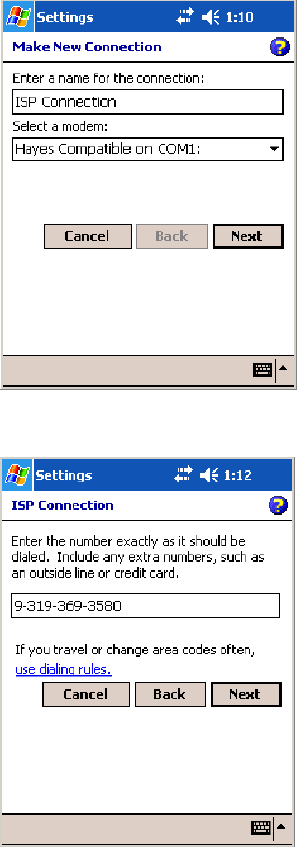
Network Support—Chapter 4
149700 Series Color Mobile Computer User’s Manual
2Enter a name for the connection, such as “ISP Connection.” If using an
external modem with a cable, select “Hayes Compatible on COM1”
from the Select a modem list. Tap Next to continue.
3Enter the access phone number, then tap Next.
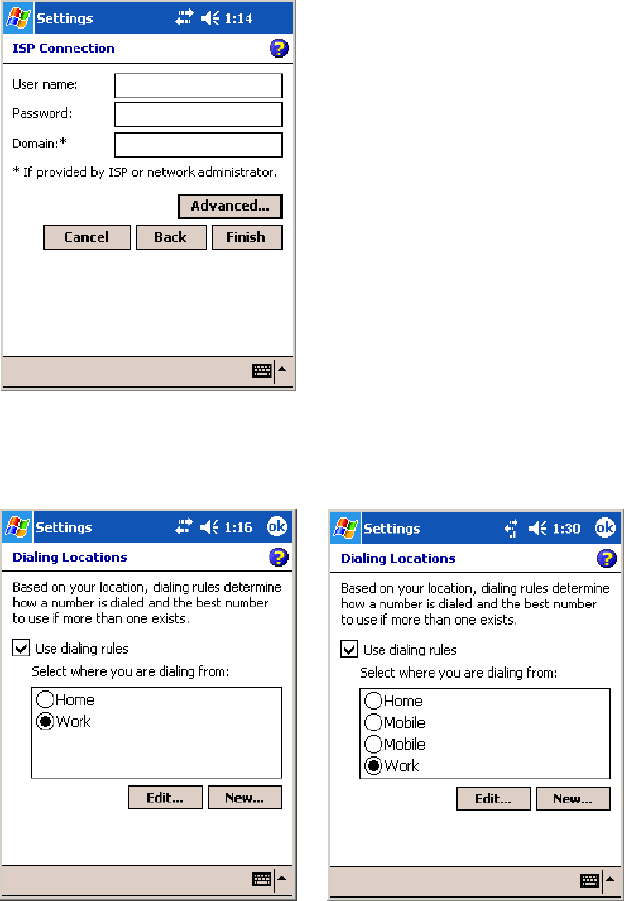
Network SupportChapter —4
150 700 Series Color Mobile Computer User’s Manual
4Enter the user name, password, and domain (if provided by an ISP or
your network administrator), then tap Finish.
5Tap the Advanced tab from the Connections screen, then tap Select
Location to specify your current location. These settings apply to all
connections. Tap Use dialing rules,tapOK,then tap Edit to continue.
730, 740, 750, 760 Screens 741, 751, 761 Screens
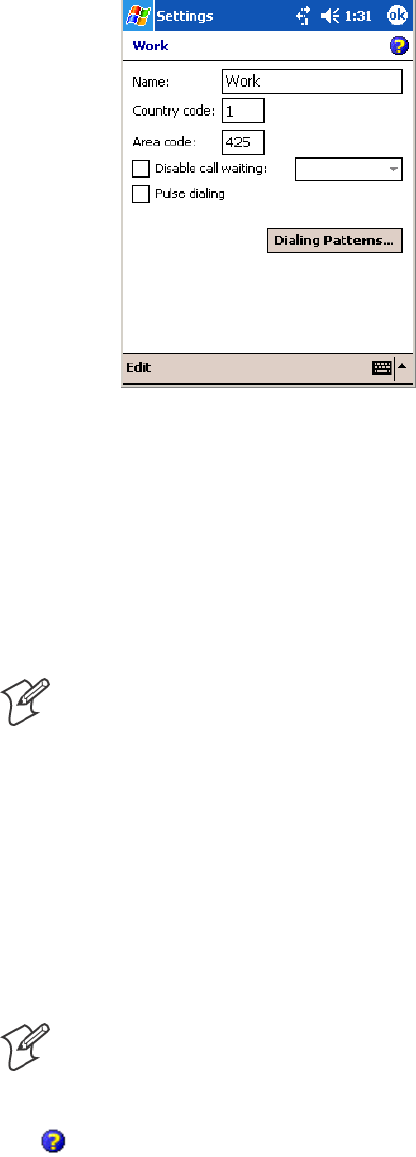
Network Support—Chapter 4
151700 Series Color Mobile Computer User’s Manual
6Specify your current phone type. If your phone type is pulse dialing,
check the Pulse dialing box. If your type is tone dialing (as most phone
lines are), then clear the Pulse dialing box. Continue to tap ok to close
each page and return to the Settings page.
To start the connection, use one of the following programs:
SSend and receive e-mail messages by using Inbox. Before you can use
Inbox, you need to provide the information it needs to communicate
with the e-mail server.
SVisit Web and WAP pages by using Pocket Internet Explorer. For more
information, see “Pocket Internet Explorer” on page 79.
SSend and receive instant messages with MSN Messenger. For more in-
formation, see “MSN Messenger” on page 73.
Note: To change modem connection settings in My ISP, tap Manage
existing connections. Select the desired modem connection, tap Settings,
and follow the instructions on the screen.
Connecting to Work
If you have access to a network at work, you can send e-mail messages,
view intranet pages, synchronize your 700 Color Computer, and possibly
access the Internet. You can connect to work by creating a modem connec-
tion via a RAS (Remote Access Server) account. Before you can create this
modem connection, your network administrator needs to set up a RAS
account for you. Your network administrator may also give you Virtual
Private Network (VPN) settings.
Note: To change modem connection settings in My Work Network, tap
Manage existing connections. Select the desired modem connection, tap
Edit, and follow the instructions on the screen.
To view additional information for any screen in the wizard or while
changing settings, tap the Help icon.
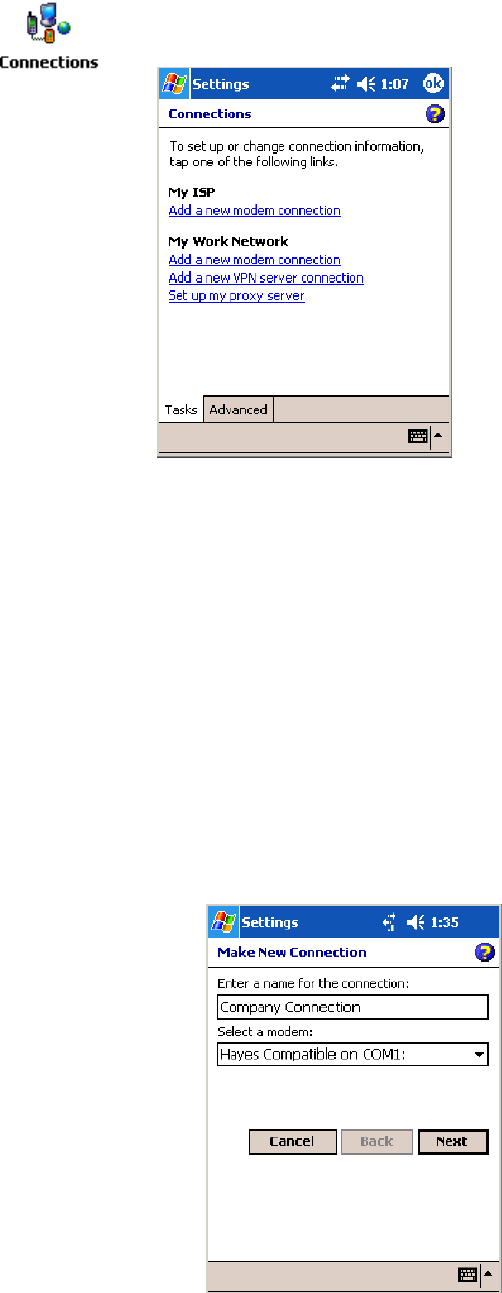
Network SupportChapter —4
152 700 Series Color Mobile Computer User’s Manual
1Tap Start >Settings >theConnections tab>theConnections icon. In
My ISP, tap Add a new modem connection.
2Enter a name for the connection, such as “Company Connection.” In
the Select a modem list, select your modem type, then tap Next to con-
tinue. If your modem type does not appear, try reinserting your 700
Color Computer into your modem dock.
SIf using an external modem connected to your 700 Computer with a
cable, select “Hayes Compatible on COM1.”
SIf using any type of external modem, select the modem by name. If a
listing does not exist for your external modem, select “Hayes Com-
patible on COM1.”
SWireless connections can be made via a mobile phone network:
SIf making a circuit-switched data connection, select “Cellular
Line.”
SIf using GPRS/EDGE, tap “Cellular Line (GPRS).”
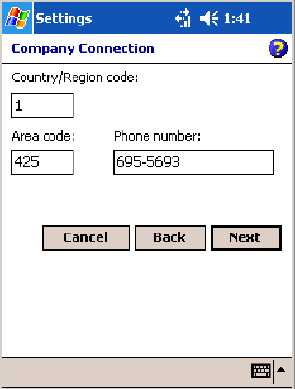
Network Support—Chapter 4
153700 Series Color Mobile Computer User’s Manual
3Enter the access phone number, using some of the following guidelines.
If you know part of the phone number changes frequently as you travel,
create dialing rules to avoid creating numerous modem connections for
the same phone number. For more information, tap Use Dialing Rules.
SEnter the phone number exactly as you want it dialed. For example,
if you call from a business complex or hotel that requires a nine be-
fore dialing out, enter “9” in front of the phone number.
SEnter the APN provided by your mobile phone service provider.
SWhen using dialing rules, phone numbers are entered differently. To
use additional numbers, such as a “9” to dial from an office complex
or hotel, you must use additional dialing rules or change dialing pat-
terns. See “Create Dialing Rules” via your online help for information.
aIn the Country/Region box, enter the appropriate code when dial-
ing internationally. For more information, contact an operator at
your local phone company.
bIn the Area code box, enter the area code. Area codes are not need-
ed in all countries.
cEnter the main phone number, then tap Next to continue.
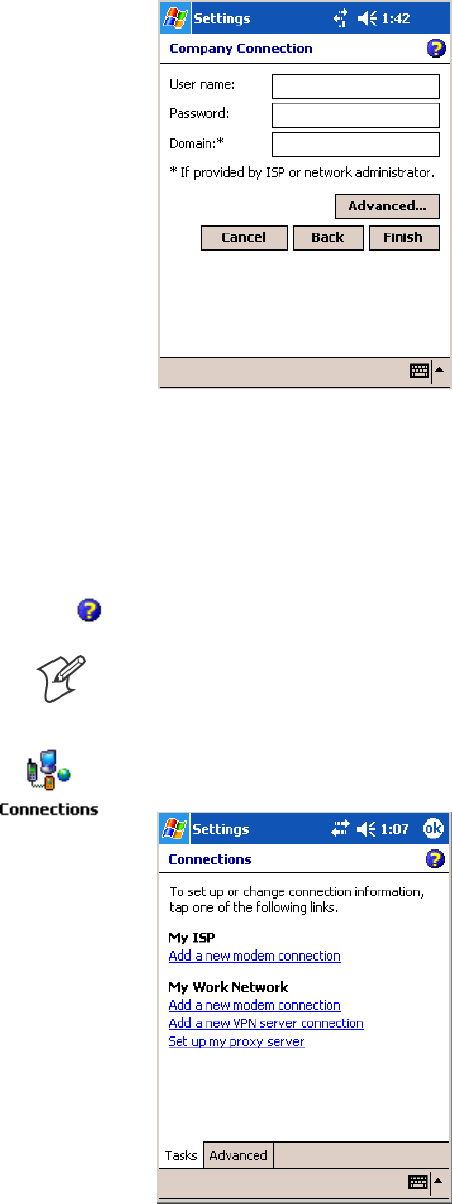
Network SupportChapter —4
154 700 Series Color Mobile Computer User’s Manual
4If necessary, enter the user name, password, and domain (provided by
an ISP or network administrator). If a domain name was not provided,
try the connection without entering a domain name, then tap Finish.
Creating a VPN Server Connection to Work
A VPN connection connects securely to servers via the Internet. Ask your
network administrator for the user name, password, domain name,
TCP/IP settings, and host name or IP address of the VPN server. The fol-
lowing information applies when you have “Wireless 802.11” selected via
the NDISTRAY pop-up menu (see page 108).
To view additional information for any screen in the wizard or while
changing settings, tap the Help icon.
Note: To change existing settings in My Work Network, tap Manage
existing connections >theVPN tab. Select the desired VPN connection,
tap Settings, and follow the instructions on the screen.
1Tap Start >Settings >theConnections tab>theConnections icon.
Tap Add a new VPN server connection beneath My Work Network.
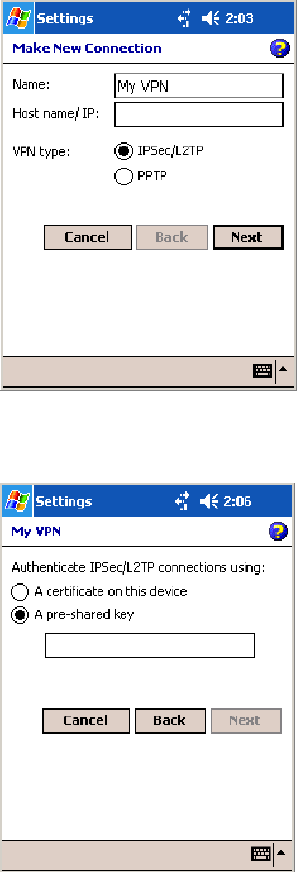
Network Support—Chapter 4
155700 Series Color Mobile Computer User’s Manual
2In Name, enter a name for the connection, such as a company’s name.
In Host name/ IP, enter the VPN server name or IP address.
Next to VPN type, select the type of authentication to use with your
device: “IPSec/L2TP” or “PPTP.” If you are not sure which option to
choose, ask your network administrator. Tap Next to continue.
3Select the type of authentication. If you select A pre-shared key,enter
the key provided by your network administrator.
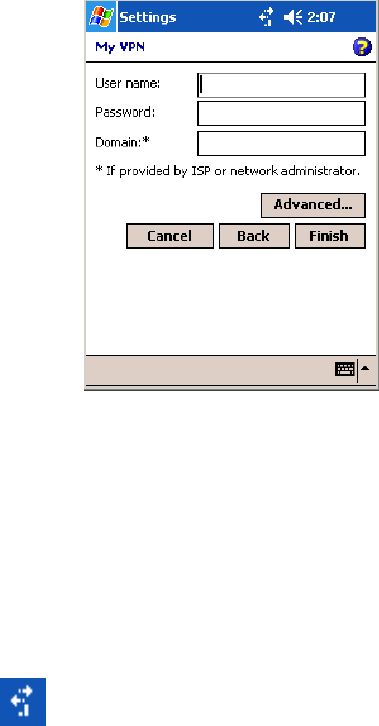
Network SupportChapter —4
156 700 Series Color Mobile Computer User’s Manual
4Enter your user name, password, and domain name as provided by your
ISP or network administrator. If a domain name was not provided, try
the connection without entering a domain name.
5You should not need to change any Advanced settings. Instances where
to change advanced settings include the server to which you are con-
necting does not use dynamically-assigned addresses, and you need to
enter your TCP/IP settings; or to change server DNS or WINS settings.
To change advanced settings, tap Advanced.Otherwise,tapFinish.In-
sert necessary equipment, such as a network (Ethernet) card, into the
device, and use a desired program to automatically begin connecting.
Ending a Connection
When connected via modem or VPN, tap the Connectivity icon on the
navigation bar, and then select Disconnect. When connected via cable or
cradle, detach your device. When connected via Infrared, move the device
away from the other computer or device. When connected via a wireless
network, switch off the connection.
Management
Use the following tool and information to configure and manage your net-
work. You can also contact your Intermec representative for support.
SmartSystemstFoundation Console (www.intermec.com/SmartSystems)
This tool, available as a free download from Intermec, includes a manage-
ment console that provides a default method to configure and manage In-
termec devices “out-of-the-box,” without the purchase of additional soft-
ware licenses. This is for anyone who must configure and deploy multiple
devices or manage multiple licenses.
Use the Intermec Settings applet to gather, view, and update device config-
uration settings within the SmartSystems Foundation. Information about
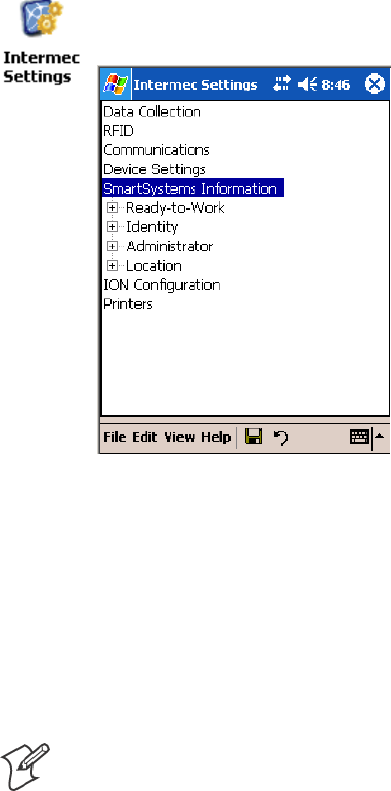
Network Support—Chapter 4
157700 Series Color Mobile Computer User’s Manual
the settings you can configure with the Intermec Settings applet is in the
Intermec Computer Command Reference Manual (P/N: 073529) available
online at www.intermec.com.
Information about the SmartSystems Foundation is available as an online
help within the SmartSystems Console application. Select SmartSystems >
Help in the console to access the manual.
See the Data Collection Resource Kit in the IDL for information about
data collection functions. The IDL is available as a download from the In-
termec web site at www.intermec.com/idl. Contact your Intermec repre-
sentative for more information.
Tap Start >Settings >theSystem tab>theIntermec Settings icon to ac-
cess the applet, then tap to expand the SmartSystems Information option.
SNMP Configuration on the Mobile Computer
In short, SNMP is an application-layer protocol that facilitates the ex-
change of management information between network devices. The 700
Color Computer is such an SNMP-enabled device. Use SNMP to control
and configure the 700 Color anywhere on an SNMP-enabled network.
The 700 Color supports four proprietary Management Information Bases
(MIBs) and Intermec provides SNMP support for MIB-II through seven
read-only MIB-II (RFC1213-MIB) Object Identifiers (OIDs).
Note: You can only query these seven OIDs through an SNMP manage-
ment station.
Management Information Base
The Management Information Base is a database that contains information
about the elements to be managed. The information identifies the manage-
ment element and specifies its type and access mode (Read-Only, Read-
Write). MIBs are written in ASN.1 (Abstract Syntax Notation.1) — a ma-
chine independent data definition language. Note: Elements to be managed
are represented by objects. The MIB is a structured collection of such objects.

Network SupportChapter —4
158 700 Series Color Mobile Computer User’s Manual
You will find the following MIB files either in the 700 Color Management
Tools or on the web via www.intermec.com:
SINTERMEC.MIB
Defines the root of the Intermec MIB tree.
SITCADC.MIB
Defines objects for Automated Data Collection (ADC), such as bar
code symbologies.
SITCSNMP.MIB
Defines objects for Intermec SNMP parameters and security methods,
such as an SNMP security IP address.
SITCTERMINAL.MIB
Defines objects for 700 Color parameters, such as key clicks.
Object Identifiers
Each object has a unique identifier called an OID, which consist of a se-
quence of integer values represented in dot notation. Objects are stored in
a tree structure and OIDs are assigned based on the position of the object
in the tree. For example, the internet OID is equal to 1.3.6.1. Seven MIB
OIDs are shown in the following table:
MIB-II Item OID Group or Table Description
ifNumber 1.3.6.1.2.1.2.1.0 Interfaces Group Indicates the number of adapters
present in the system. For the 700
Color Computer, if one adapter is
present in the system, then ifNum-
ber =1andifIndex=1.
ifIndex 1.3.6.1.2.1.2.2.1.1.ifIndex Interfaces Table (ifTable) A unique value for each interface.
The value ranges between 1 and the
value of ifNumber.
ifDescr 1.3.6.1.2.1.2.2.1.2.ifIndex Interfaces Table (ifTable) A textual string containing informa-
tion about the interface.
ifType 1.3.6.1.2.1.2.2.1.3.ifIndex Interfaces Table (ifTable) An integer containing information
about the type of the interface. It is
equal to 1 for Other.
ipAdEntAddr 1.3.6.1.2.1.4.20.1.1.IpAddress IP address Table
(ipAddrTable)
The IP address to which this entry’s
addressing information pertains
(same as 700 IP address), where IP
Address is the valid non-zero IP ad-
dress of the 700 Color Computer.
ipAdEntIfIndex 1.3.6.1.2.1.4.20.1.2.IpAddress IP address Table
(ipAddrTable)
The index value that uniquely iden-
tifies the interface to which this
entry is applicable (same as ifIndex).
ipAdEntNetMask 1.3.6.1.2.1.4.20.1.3.IpAddress IP address Table
(ipAddrTable)
Subnet mask associated with the IP
address of this entry (Subnet Mask).
Network Support—Chapter 4
159700 Series Color Mobile Computer User’s Manual
Configuring with SNMP
The community string allows an SNMP manager to manage the 700 Col-
or Computer with a specified privilege level. The default read-only com-
munity string is “public” and “private” is the default read/write communi-
ty string. See the specific configuration parameter to find its OID.
To configure using SNMP, configure 700 Color Computers for RF or
Ethernet communications. Determine the OID (Object Identifier) for the
parameter to be changed. The Intermec base OID is 1.3.6.1.4.1.1963.
Use your SNMP management station to get and set variables that are de-
fined in the Intermec MIBs. You can set the traps, identification, or secu-
rity configuration parameters for SNMP.
Network SupportChapter —4
160 700 Series Color Mobile Computer User’s Manual

161700 Series Color Mobile Computer User’s Manual
Printer Support
5
The 700 Series Color Mobile Computer works with the following printers
from Intermec. Contact an Intermec representative for information about
these printers.
S6808
A 4-inch belt-mount printer.
S6820
A full-page, 80-column printer.
S782T
A 2-inch workboard printer.
SPB20
A 2-inch belt-mount printer with a Bluetooth compatible module from
Socket Communications.
SPB42
A 4-inch wireless portable receipt printer with a Bluetooth compatible
module from Socket Communications.
Note: “700 Color” pertains to 740, 741, 750, 751, 760, and 761 Com-
puters unless otherwise noted.
Printer SupportChapter —5
162 700 Series Color Mobile Computer User’s Manual
Printing ASCII
These methods for printing using Pocket PC at this time is as follows:
SAdd port drivers to print ASCII directly to the port.
SUse LinePrinter ActiveX Control from the Printing Resource Kit via the
Intermec Developer Library (IDL) available as a download from the In-
termec webs site at www.intermec.com/idl.Contact your Intermec rep-
resentative for more information.
SVia wireless printing - see the Bluetooth Resource Kit User’s Guide for more
information.
Directly to a Port
Printing directly to the port sends RAW data to the printer. The format of
this data depends upon your application and the printer capabilities.
You must understand the printer commands available for your specific
printer. Generally, applications just send raw ASCII text to the printer.
Since you are sending data to the printer from your application directly to
the port you are in complete control of the printers operations. This allows
youtodolineprinting(print one line at a time) rather than the page for-
mat printing offered by the GDI approach. It is also much faster since data
does not have to be converted from one graphics format to the other (dis-
play to printer). Most Intermec®printers use Epson Escape Sequences to
control print format operations.
These commands are available in documentation you receive with your
printers or from technical support. Win32 APIs are required to print di-
rectly to the port.
Directly to a Generic Serial Port
To print directly to a generic serial port printer (non-Intermec printers):
SUse CreateFile() to open ports — COM1 can open on most devices.
SUse WriteFile() to send data directly to the printer.
SUse CloseHandle() when you are finished printing to close the port.
IrDA Printer Driver
IrDA printing is only available on the certain devices and is supported di-
rectly by the Windows CE load via the IrSock API provided by the Micro-
soft Win32 API without need for additional drivers. Intermec 6804, 6805,
6806, 6808 and 6820 and other IrDA printers are supported.
Printer Support—Chapter 5
163700 Series Color Mobile Computer User’s Manual
NPCP Printer Driver
The NPCP printer communications driver (NPCPPORT.DLL) is a
Stream Device Driver built into the operating system. The driver supports
only NPCP communications to and from the 6820 and 4820 printers over
a selected serial port.
All applications use WIN32 API functions to access drivers. Applications
easily implement basic operations through the CreateFile(), WriteFile(),
ReadFile(), DeviceIOControl(), and CloseHandle() Win32 APIs.
DeviceIOControl() functions are used to do most upgrade printer mod-
ules, printer diagnostics, and get printer configurations.
About NPCP
NPCP (Norand®Portable Communications Protocol) is a proprietary
protocol that provides session, network, and datalink services for Intermec
mobile computers in the Intermec LAN environment used with printers
and data communications.
NPCP Driver Installation and Removal
Use LPT9: for the NPCP printer device and COM1 for the last parame-
ter. COM1 is the connection available via the 700 Color Computer.
Applications use the RegisterDevice() function to install the driver.
DeregisterDevice() uninstalls the device driver and frees memory space
when the driver is not required. Use the HANDLE returned by
RegisterDevice() as the parameter to DeregisterDevice().
Use the RegisterDevice() function call as demonstrated below. Specify the
full path name to the driver starting at the root for the RegisterDevice()
function to work properly. The last parameter to RegisterDevice() is a
DWORD that represents the name of the port for the NPCP stream
driver to use. Build this parameter on the stack if it is not to be paged out
during the call. The first parameter “LPT” (Device Name) and the second
parameter “9’ (index), indicate the name of the registered device, such as
LPT9. This is used in the CreateFile() function call.
Install()
{HANDLE hDevice;
TCHAR port[6];
port[0] = TCHAR(‘C’);
port[1] = TCHAR(‘O’);
port[2] = TCHAR(‘M’);
port[3] = TCHAR(‘1’);
port[4] = TCHAR(‘:’);
port[5] = TCHAR(0);
hDevice = RegisterDevice ( (TEXT(”LPT”), 9,
TEXT(“\\STORAGE CARD\\WINDOWS\\NPCPPORT.dll”), (DWORD)port);
}
Printer SupportChapter —5
164 700 Series Color Mobile Computer User’s Manual
Opening the NPCP Driver
The application opens the NPCP driver by using the CreateFile()
function. The call can be implemented as follows. The first parameter
“LPT9:”mustreflectthedevicenameandindexusedinthe
RegisterDevice() function call and will fail for any of the following reasons:
hFile = CreateFile(_T(”LPT9:”), GENERIC_WRITE |
GENERIC_READ, 0, NULL, OPEN_ALWAYS, FILE_ATTRIBUTE_NORMAL,
NULL);
SThe port associated with the device during RegisterDevice() is in use.
SThe NPCP device is already open.
SThe share mode is not set to zero. The device cannot be shared.
SAccess permissions are not set to GENERIC_WRITE |
GENERIC_READ. Both modes must be specified.
Closing the NPCP Driver
Using the CloseHandle() (hFile) function closes the NPCP driver. Where
hFile is the handle returned by the CreateFile() function call.
STRUE = the device is successfully closed.
SFALSE = an attempt to close NULL HANDLE or already closed device.
Reading from the NPCP Driver
Reading of the NPCP printers is not supported since all responses from
the printer are the result of commands sent to the printer.
DeviceIoControl() functions are provided where data is to be received
from the printer.
Writing to the NPCP Driver
All Print data can be sent to the printer using the WriteFile() function.
The print data written to the driver must contain the proper printer
commands for formatting. If the function returns FALSE, the NPCP error
may be retrieved using IOCTL_NPCP_ERROR. See the description on
the next page.
NPCP Driver I/O Controls
An application uses the DeviceIoControl() function to specify an printer
operation to be performed. Certain I/O controls are required to bind and
close communication sessions with the printer, and must be completed
before any other commands to the driver can execute properly.
The function returns TRUE to indicate the device successfully completed
its specified I/O control operation, otherwise it returns FALSE. The
following I/O control codes are defined:
Printer Support—Chapter 5
165700 Series Color Mobile Computer User’s Manual
#define IOCTL_NPCP_CANCEL
CTL_CODE(FILE_DEVICE_SERIAL_PORT,0x400,METHOD_BUFFERED,FILE_ANY_ACCESS)
#define IOCTL_NPCP_BIND
CTL_CODE(FILE_DEVICE_SERIAL_PORT,0x401,METHOD_BUFFERED,FILE_ANY_ACCESS)
#define IOCTL_NPCP_CLOSE
CTL_CODE(FILE_DEVICE_SERIAL_PORT,0x402,METHOD_BUFFERED,FILE_ANY_ACCESS)
#define IOCTL_NPCP_ERROR
CTL_CODE(FILE_DEVICE_SERIAL_PORT,0x403,METHOD_BUFFERED,FILE_ANY_ACCESS)
#define IOCTL_NPCP_FLUSH
CTL_CODE(FILE_DEVICE_SERIAL_PORT,0x404,METHOD_BUFFERED,FILE_ANY_ACCESS)
#define IOCTL_NPCP_IOCTL
CTL_CODE(FILE_DEVICE_SERIAL_PORT,0x405,METHOD_BUFFERED,FILE_ANY_ACCESS)
#define IOCTL_NPCP_PRTVER
CTL_CODE(FILE_DEVICE_SERIAL_PORT,0x406,METHOD_BUFFERED,FILE_ANY_ACCESS)
SIOCTL_NPCP_CANCEL
This cancels all printing at the printer. It flushes the printer buffers and
reinitializes the printer to its default state. No parameters are required.
SIOCTL_NPCP_BIND
This command is required before any data is sent or received by the
printer. Once the driver is opened, the application must bind the com-
munications session with the printer before any data can be sent or re-
ceived by the printer. If an error occurs during the bind, the application
may use IOCTL_NPCP_ERROR to get the current extended error
code. No parameters are required.
SIOCTL_NPCP_CLOSE
This command closes the current session with the printer. This function
always returns TRUE. No parameters are required.
SIOCTL_NPCP_ERROR
This command returns the extended NPCP error code in PL/N format.
The word returned will contain the PL/N compatible error code in the
low byte and completion flags in the high byte. If the frame that re-
turned an error was not received correctly by the printer the
FRAME_NOT_ACKED bit will be set in the high byte. This operation
always returns TRUE. An output buffer of at least 2 bytes is required.
See “NPCP Error Codes” on page 166.
SIOCTL_NPCP_FLUSH
This command allows the application to poll the printer for errors while
the report is completing the print process at the printer. If an error oc-
curs during the polling process, the operation will return FALSE and
the application can get the extended error code by using
IOCTL_NPCP_ERROR. No parameters are required.
NPCP Printer Communications
All NPCP printer communications should be based on the following flow:
1Use CreateFile(); to open the printer driver.
2Use IOCTL_NPCP_BIND to bind a session with the printer;
IOCTL_NPCP_ERROR to check for errors on the bind to ensure suc-
cess; and IOCTL_NPCP_CANCEL to cancel outstanding print jobs.
Printer SupportChapter —5
166 700 Series Color Mobile Computer User’s Manual
3Use IOCTL_NPCP_FLUSH to poll the printer to free up printer buff-
er resources. Use IOCTL_NPCP_FLUSH to poll the printer’s status. If
an error is reported by the IOCTL, then use IOCTL_NPCP_ERROR
to get the error and determine the correct recovery procedure.
4Use WriteFile(); to write data to the printer. Check for errors and that
alldatawerewritten.UseIOCTL_NPCP_ERRORtogettheextended
error. If the error is critical in nature, use IOCTL_NPCP_CLOSE, fol-
lowed by CloseFile(), to end the communications session. Start a new
session, beginning with step 1 to ensure proper printing. For noncritical
errors display the error and retry the operation.
5After all data is sent to the printer, ensure that the printer continues to
print the report properly by polling the printer’s status. Use
IOCTL_NPCP_FLUSH to poll the printer’s status. If an error is re-
ported by the IOCTL, then use IOCTL_NPCP_ERROR to get the
error and determine the correct recovery procedure.
Sample Code
See sample code in the “\700C Dev Tools\Installable Drivers\Port
Drivers\Npcp\NPCPPrint\” directory for more details on printing, printer
communications and error code handling.
NPCP Error Codes
Call the IOCTL_NPCP_ERROR I/O control to receive PL/N compatible
error codes. Applications must decide how to act on the data returned.
// Definition of NPCP communications Errors and Printer Errors
#define PNRDY (BYTE)102 // link not ready error
#define RXTMO (BYTE)104 // link no receive error
#define TXTMO (BYTE)106 // link no transmit error
#define BADADR (BYTE)111 // frame address error
#define GAPERR (BYTE)112 // link gap error (timeout) in receive data
#define LSRPE (BYTE)113 // frame parity error on length field
#define IFTS (BYTE)120 // session layer - invalid frame this state
#define NS_NE_VR (BYTE)121 // session layer sequence error
#define NR_NE_VS (BYTE)122 // session layer sequence error
#define MAC_CRCERR (BYTE)124 // MAC CRC error
#define RLENERR (BYTE)123 // MAC too much data received
#define FRMERR (BYTE)200 // Frame Reject
#define FRMERR_IF (BYTE)201 // Frame Reject - Invalid Frame
#define FRMERR_NR (BYTE)202 // Frame Reject - NR Mismatch
#define FRMERR_NS (BYTE)203 // Frame Reject - NS Mismatch
#define NDMERR (BYTE)204 // Normal Disconnect mode error
#define BINDERR (BYTE)210 // bind error
#define IPLDUR (BYTE)221 // invalid presentation layer response
#define HEADJAM (BYTE)222 // printer head jam
#define PAPEROUT (BYTE)223 // printer paper out
#define LOWVOLTS (BYTE)224 // printer low voltage
#define HIVOLTS (BYTE)225 // printer over voltage
#define LOWBAT (BYTE)226 // printer low battery
#define COVEROFF (BYTE)227 // printer cover off error
#define HEADFAULT (BYTE)228 // printer head short or driver short error
#define PFFAULT (BYTE)229 // paper feed motor fault.
#define FRAME_NOT_ACKED 0x8000 // frame was not received by printer and need
to be resent.
Printer Support—Chapter 5
167700 Series Color Mobile Computer User’s Manual
O’Neil Printer Driver
The DTR printer communications driver is a Stream Device Driver
named ONEIL.DLL.
All applications use WIN32 API functions to access drivers. Applications
easily implement basic operations using the CreateFile(), WriteFile(),
DeviceIOControl() and CloseHandle() Win32 APIs.
The driver supports communications to 6804DM, 6804T, 6805A, 6806,
6808, 681T, PB20, and PB42 printers over a selected serial port.
DTR Driver Installation and Removal
Your application must use the RegisterDevice() function to install the
ONEIL.DDL device driver. Use “DTR” for the Device Name parameter,
“1” for the Device Driver index parameter, and any of these strings for the
last parameter:
SNULL (==0) Defaults to COM1 @ 9600
S“COM1” only COM port specified defaults to 9600
S“COM1:9600” sets to COM port and specified bit rate
S“COM1:19200” sets to COM port and specified bit rate
Use the HANDLE returned by RegisterDevice() as the parameter to
DeregisterDevice(). The correct usage of the RegisterDevice() function call
is shown below. You may use DeregisterDevice() to uninstall the driver.
Install()
{
HANDLE hDevice;
TCHAR port[6];
port[0] = TCHAR(‘C’);
port[1] = TCHAR(‘O’);
port[2] = TCHAR(‘M’);
port[3] = TCHAR(‘1’);
port[4] = TCHAR(‘:’);
port[5] = TCHAR(0);
hDevice = RegisterDevice ( (TEXT(”DTR”), 1, TEXT(”\\WINDOWS\\ONEIL.DLL”),
(DWORD)port);
}
Opening the DTR Driver
The application opens the DTR driver by using the CreateFile() function.
The call can be implemented as follows:
hFile = CreateFile(_T(”DTR1:”), GENERIC_WRITE, 0, NULL,
OPEN_ALWAYS, FILE_ATTRIBUTE_NORMAL, NULL);
The first parameter “DTR1:” must reflect the device name and index used
in the RegisterDevice() function call.
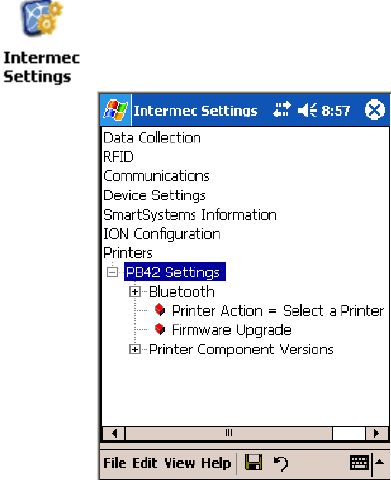
Printer SupportChapter —5
168 700 Series Color Mobile Computer User’s Manual
The function call will fail for any of the following reasons:
SPort associated with device during RegisterDevice() is currently in use.
SThe DTR device is already open.
SThe share mode is not set to zero. The device cannot be shared.
SAccess permissions are not set to GENERIC_WRITE.
Closing the DTR Driver
Using the CloseHandle() (hFile) function closes the DTR driver. Where
hFile is the handle returned by the CreateFile() function call.
STRUE indicates the device is successfully closed.
SFALSE indicates an attempt to close a NULL HANDLE or an already
closed device.
Writing to the DTR Driver
Use the WriteFile() function to send all print data to the printer. The data
must contain the proper formatting printer commands.
DTR Printer Communications
All DTR printer communications should be based on the following flow:
1Use CreateFile() to open the printer driver.
2Use WriteFile() to write your data to the printer. Check for errors and
that all data were written.
3Use CloseHandle() to close the driver.
Configuring PB42 Printers Via Intermec Settings
Tap Start >Settings >theSystem tab>theIntermec Settings icon to ac-
cess the applet. Tap (+) to expand the Printers option, then tap (+) to ex-
pand the PB42 Settings option and make your adjustments.

169700 Series Color Mobile Computer User’s Manual
Scanner Support
6
The 700 Series Color Mobile Computer is available with imaging or laser
scanning technologies, including the following:
APS Linear Imager:(standard for 730 Computers)
— includes the EV10 Scan Engine
Reads 1D symbologies and PDF417 bar codes. Linear imag-
ing using Vista Scanning technology reads low-contrast bar
codes, laminated bar codes, and bar codes displayed on CRT
or TRT displays. This imaging uses harmless LEDs for illu-
mination and does not require any warning labels. Vista Scan-
ning is more reliable than lasers as it is a completely solid state
with no moving parts or oscillating mirrors.
2D Imager:(not supported on 730 Computers)
— includes the IT4000 Scan Engine
This decodes several stacked 1D and 2D symbologies, includ-
ing PDF417, Data Matrix, and MaxiCode without “paint-
ing.” It can also read 1D codes from any orientation, for ex-
ample the scan beam does not need to align perpendicular to
the symbol to read it. Photography is a secondary application;
the lens in the device favors bar code reading. Photos are
640x480, 256 gray-scale.
1D Laser Scanner:(not supported on 730 Computers)
— includes the SE900, SE900HS, SE900-S6, and
SE900HS-S6 scan engines
Traditional laser scanner that decodes 1D bar codes.
PDF417 Laser Scanner:(not supported on
730 Computers)
Higher speed laser scanner that can read PDF417 labels by
“painting” the label.
EL10 Laser Scanner An EXCELeratetbar code laser scan engine, based on the
Micro Electro Mechanical System (MEMS) technology, that
is significantly faster, lighter, and more efficient than tradi-
tional laser scanners.

Scanner SupportChapter —6
170 700 Series Color Mobile Computer User’s Manual
A 700 Color ImageDemo application demonstrates the more common fea-
tures of the 700 Color Computer imager. See the ImageDemo User’s Guide
for information.
Note: “700 Color” pertains to 740, 741, 750, 751, 760, and 761 Com-
puters unless otherwise noted.
Scanner Control and Data Transfer
Note: To use the methods described below, enable Data Collection func-
tionality on the 700 Computer using the bootloader configuration menu.
The Data Server and associated software provide several ways to manipu-
late scanner control and data transfer between the scanner subsystem and
user applications:
SAutomatic Data Collection COM Interfaces:
These COM interfaces allow user applications to receive bar code data,
and configure and control the bar code reader engine.
SITCAxBarCodeReaderControl functions:
These ActiveX controls allow user applications to collect bar code data
from the scanner, to configure the scanner, and to configure audio and
visual notification when data arrives.
SITCAxReaderCommand functions:
Use these ActiveX controls to modify and retrieve configuration infor-
mation using the reader interface commands.
SScanning EasySet bar code labels:
You can use the EasySetRbar code creation software from Intermec to
print configuration labels. Scan the labels to change the scanner configu-
ration and data transfer settings.
Use the Intermec EasySet software to print configuration labels you can
scan to change your configuration settings. For more information, see
the EasySet online help. EasySet is available from the Intermec Data
Capture web site.
For more information, see the Data Collection Resource Kit in the Inter-
mec Developer Library (IDL), which is available as a download from the
Intermec web site at www.intermec.com/idl. Contact your Intermec repre-
sentative for more information.
Data Collection Configuration
You can configure scanner and reader settings for the 700 Color Comput-
er via the Intermec Settings applet. From the 700 Color Computer, tap
Start >Settings >theSystem tab>theIntermec Settings icon. See the
Intermec Computer Command Reference Manual (P/N: 073529) for infor-
mation about the settings you can configure with this applet. This online
manual is available from the Intermec web site at www.intermec.com.
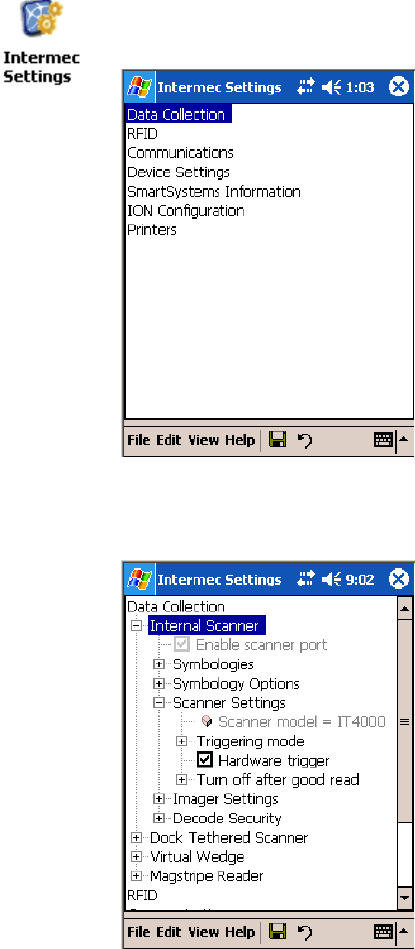
6 Scanner Support—Chapter
171700 Series Color Mobile Computer User’s Manual
Internal Scanners
The Intermec Internal Scanner feature allows Automatic Data Collection
(ADC) by accepting data from the COM1 port and wedging it into the
keyboard interface. You can enable or disable this feature from the Today
screen on the 700 Color Computer.
Before you configure your internal scanner, adjust its settings using the
Intermec Settings applet. Information about the settings you can configure
with this applet is described in the Intermec Computer Command Reference
Manual. The online manual is available from the Intermec web site at
www.intermec.com.
1From the 700 Color Computer, tap Start >Settings >theSystem tab >
the Intermec Settings icon.
2Tap the Data Collection option, then tap (+) to expand Internal
Scanner.This sample screen is for the IT4000 scan engine.
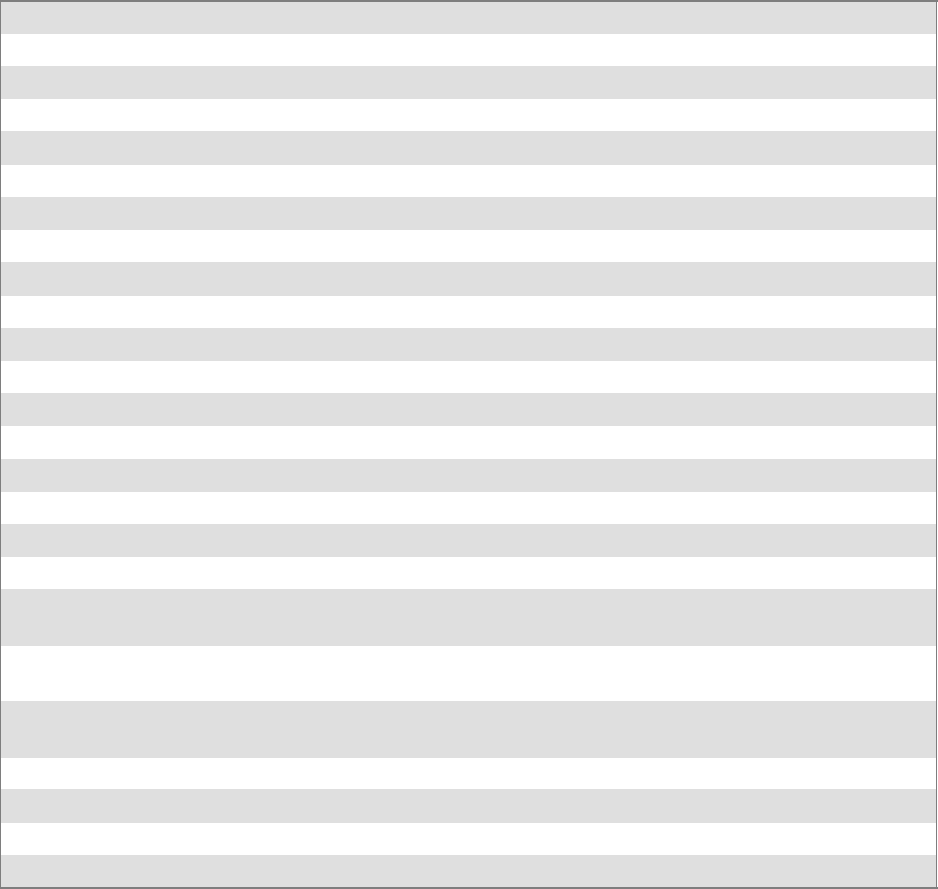
Scanner SupportChapter —6
172 700 Series Color Mobile Computer User’s Manual
Scanner and Imager Settings
Depending on what is selected as the scanner model, image settings, de-
code security, scanner settings, and virtual wedge are configured from the
Intermec Settings applet. See the the Intermec Computer Command Refer-
ence Manual, available from the Intermec web site at www.intermec.com,
for more information about each enabled option.
Internal Scanner Supported Symbologies
Symbologies EL10 EV10 IT4000 SE900 SE900HS SE900-S6 SE900HS-S6
Code39 XXXXX X X
UPC/EAN XXXXX X X
Code 128 XXXXX X X
Interleaved 2 of 5 XXXXX X X
Code 93 XXXXX X X
Codabar XXXXX X X
Code 2 of 5 XXXXX X X
MSI XXXXX X X
Plessey XXXXX X X
Code 11 XXXXX X X
Matrix 2 of 5 XXXXX X X
Telepen XXXXX X X
PDF417 XXXXX X X
Micro PDF417 XXXXX X X
MaxiCode X
Data Matrix X
QR Code X
RSS 14 XXXXXAvailable in
f/w Sxxp304
Available in
f/w Sxxp304
RSS Limited XXXXXAvailablein
f/w Sxxp304
Available in
f/w Sxxp304
RSS Expanded XXXXXAvailable in
f/w Sxxp304
Available in
f/w Sxxp304
Codablock A XXXXX X X
Codablock F XXXXX X X
UCC Composite X
TLC 39 XXXXX X X
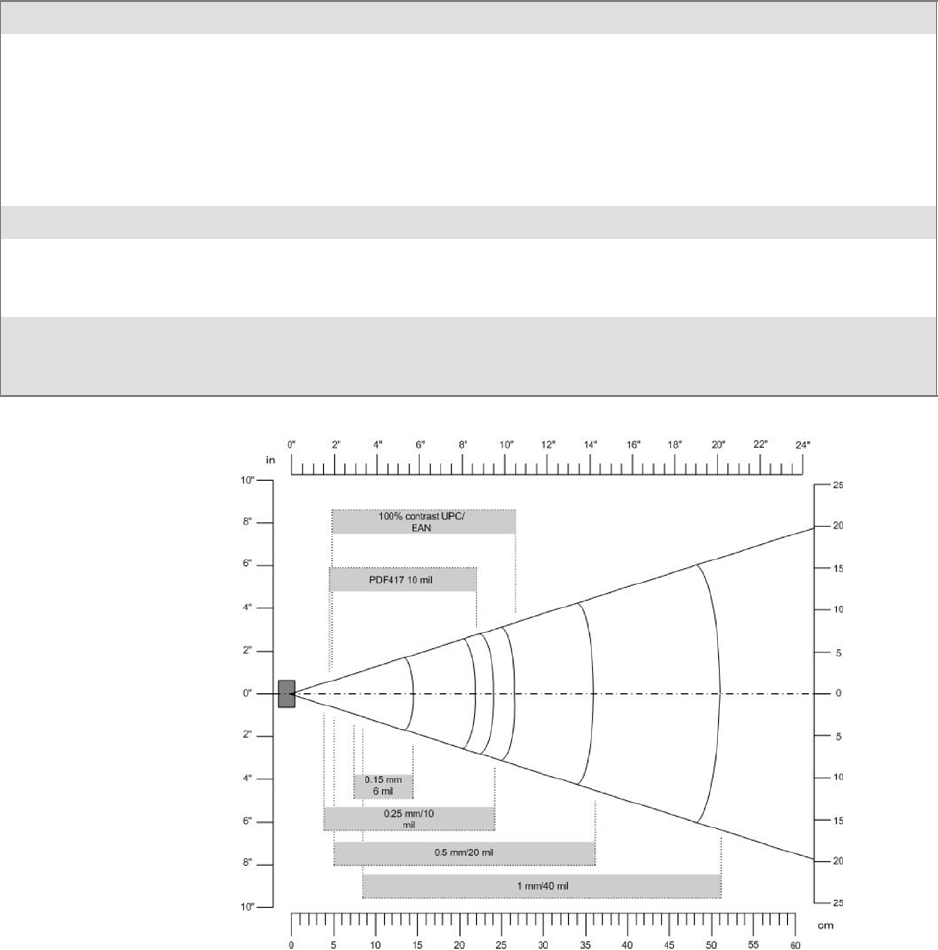
6 Scanner Support—Chapter
173700 Series Color Mobile Computer User’s Manual
Reading Distances
Typical reading distances are done in an office environment using office
lights (4 lux). Minimum distances are measured in the dark (0 lux). Both
reading distances are provided in respective scan engine integration guides.
Contact your Intermec representative for more information.
Below are minimum standard reading distances for 700 Color Computers
built with integrated scan engines. When correctly mounted, an exit win-
dow reduces reading distances by about 4% for all scan engines, with the
exception of the EL10 with its reading distances reduced by about 25%.
EA10 Minimum Reading Distances with 0.04” Setbacks
Symbology Density Minimum Distance Maximum Distance
Code 39 0.125 mm/ 5 mil
0.15 mm/ 6 mil
0.20 mm/ 8 mil
0.25 mm/ 10 mil
0.30 mm/ 12 mil
0.5 mm/ 20 mil
1.0 mm/ 40 mil
8.03 cm/ 3.16”
7.39 cm/ 2.91”
5.49 cm/ 2.16”
3.96 cm/ 1.56”
3.71 cm/ 1.46”
4.98 cm/ 1.96”
3.71 cm/ 1.46”
11.84 cm/ 4.66”
14.38 cm/ 5.66”
19.46 cm/ 7.66”
24.03 cm/ 9.46”
25.81 cm/ 10.16”
35.97 cm/ 14.26”
50.95 cm/ 20.06”
UPC/EAN 4.98 cm/ 1.96” 29.87 cm/ 11.76”
PDF417 0.168 mm/ 6.6 mil
0.254 mm/ 10 mil
0.381 mm/ 15 mil
7.26 cm/ 2.86”
4.47 cm/ 1.76”
10.06 cm/ 3.96”
12.85 cm/ 5.06”
20.98 cm/ 8.26”
28.35 cm/ 11.16”
Data Matrix 0.254 mm/ 10 mil
0.381 mm/ 15 mil
0.508 mm/ 20 mil
6.50 cm/ 2.56”
5.99 cm/ 2.36”
4.98 cm/ 1.96”
17.93 cm/ 7.06”
27.84 cm/ 10.96”
32.92 cm/ 12.96”
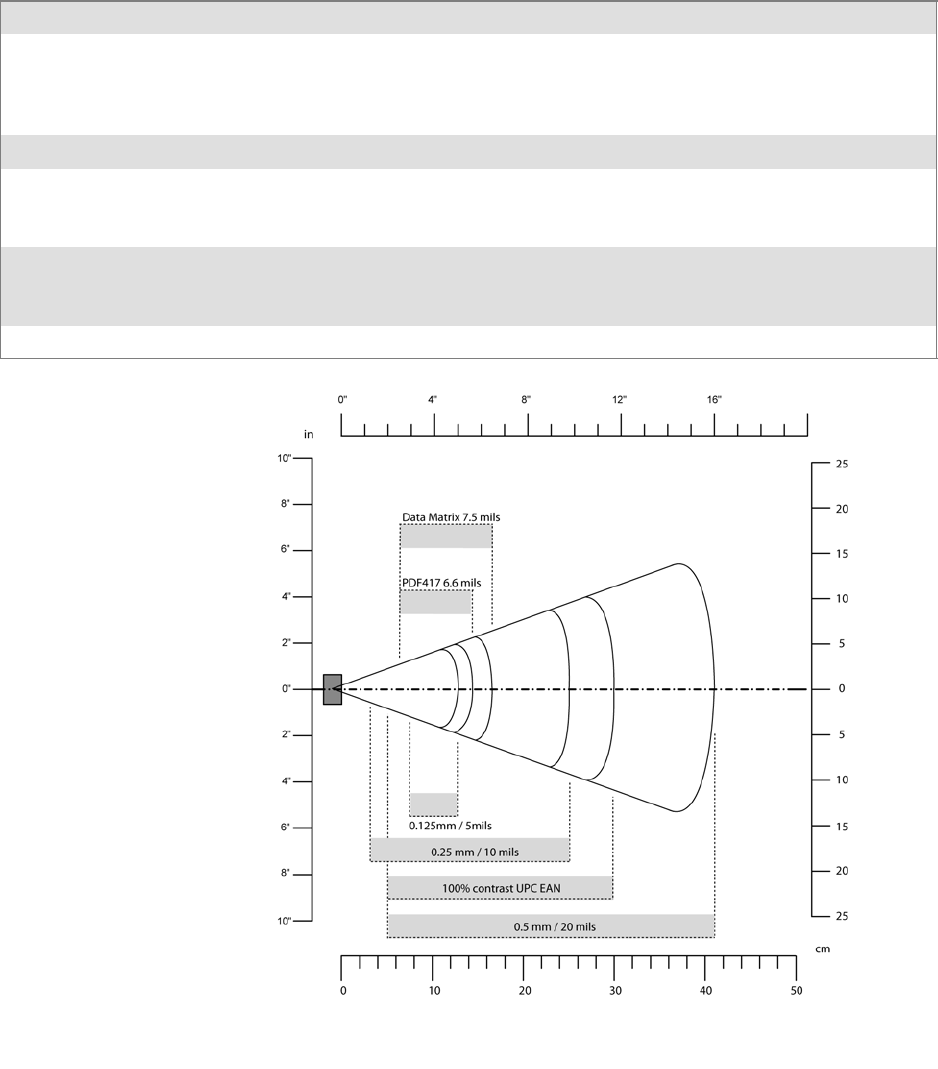
Scanner SupportChapter —6
174 700 Series Color Mobile Computer User’s Manual
EA11 Standard Minimum Reading Distances with 0.04” Setbacks
Symbology Density Minimum Distance Maximum Distance
Code 39 0.125 mm/ 5 mil
0.20 mm/ 8 mil
0.25 mm/ 10 mil
0.5 mm/ 20 mil
7.26 cm/ 2.86”
3.96 cm/ 1.56”
3.45 cm/ 1.36”
4.98 cm/ 1.96”
12.09 cm/ 4.76”
20.98 cm/ 8.26”
25.04 cm/ 9.86”
40.28 cm/ 15.86”
UPC/EAN 0.33 mm/ 13 mil 4.98 cm/ 1.96” 29.62 cm/ 11.66”
Data Matrix 0.191 mm/ 7.5 mil
0.254 mm/ 10 mil
0.381 mm/ 15 mil
3.71 cm/ 2.46”
5.98 cm/ 1.96”
*
16.41 cm/ 6.46”
20.73 cm/ 8.16”
27.58 cm/ 10.86”
PDF417 0.168 mm/ 6.6 mil
0.254 mm/ 10 mil
0.381 mm/ 15 mil
6.25 cm/ 2.46”
4.47 cm/ 1.76”
4.98 cm/ 1.96”
13.87 cm/ 5.46”
21.74 cm/ 8.56”
33.43 cm/ 13.16”
* Minimum distance depends on symbology length and scan angle.

6 Scanner Support—Chapter
175700 Series Color Mobile Computer User’s Manual
EL10 Minimum Guaranteed Reading Distances with 0.25” Setbacks
Symbology Density Minimum Distance Maximum Distance
Code 39 0.1 mm/ 4 mil
0.125 mm/ 5 mil
0.25 mm/ 10 mil
0.5 mm/ 20 mil
1 mm/ 40 mil
8.51 cm/ 3.35”
7.75 cm/ 3.05”
6.99 cm/ 2.75”
6.48 cm/ 2.55”
7.75 cm/ 3.05”
12.30 cm/ 4.45”
14.35 cm/ 5.65”
29.34 cm/ 11.55”
50.17 cm/ 19.75”
63.37 cm/ 24.95”
UPC/EAN 0.33 mm/ 13 mil 5.46 cm/ 2.15” 34.42 cm/ 13.55”
PDF417 0.17 mm/ 6.6 mil 7.75 cm/ 3.05” 19.43 cm/ 7.65”
EL11 Minimum Reading Distances with 0.04” Setbacks
Symbology Density Minimum Distance Maximum Distance
0.1 mm/ 4 mil
0.125 mm/ 5 mil
0.33 mm/ 13 mil (EAN)
1 mm/ 40 mil
8.79 cm/ 3.46”
8.28 cm/ 3.26”
5.49 cm/ 2.16”
9.55 cm/ 3.86”
11.84 cm/ 4.66”
14.48 cm/ 5.86”
34.95 cm/ 13.76”
63.91 cm/ 25.16”
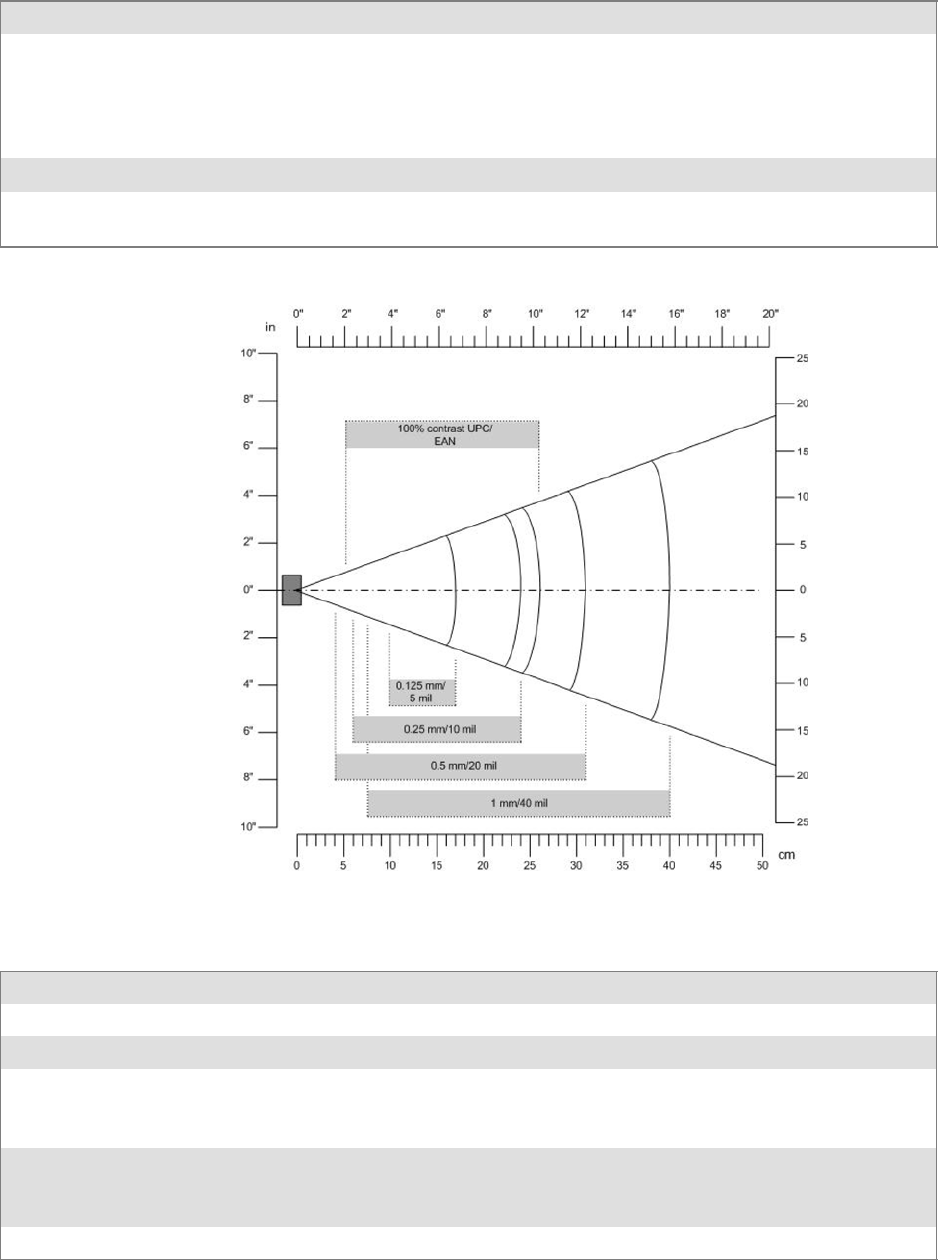
Scanner SupportChapter —6
176 700 Series Color Mobile Computer User’s Manual
EV10 Minimum Reading Distances with 0.04” Setbacks
Symbology Bar Code Content Density Minimum Distance Maximum Distance
Code 39 RESO 0.100 MM
R 0.125 MM
0.25
0.5
R1MM
0.1 mm/ 4 mil
0.125 mm/ 5 mil
0.25 mm/ 10 mil
0.5 mm/ 20 mil
1 mm/ 40 mil
10.8 cm/ 4.26”
9.80 cm/ 3.86”
5.99 cm/ 2.36”
3.96 cm/ 1.56”
7.53 cm/ 2.96”
13.87 cm/ 5.46”
16.92 cm/ 6.66”
23.77 cm/ 9.36”
30.89 cm/ 12.16”
39.78 cm/ 15.66”
UPC/EAN 120010010100 0.33 mm/ 13 mil 4.98 cm/ 1.96” 25.81 cm/ 10.16”
PDF417 10 mil
15 mil
0.254 mm/ 10 mil
0.381 mm/ 15 mil
9.80 cm/ 3.86”
7.77 cm/ 3.06”
16.92 cm/ 6.66”
18.95 cm/ 7.46”
2D Area Imager Reading Distances with 0.04” Setbacks
Symbology Density Near Distance Far Distance
MaxiCode 35 mil 4.98 cm/ 1.96” 33.92 cm/ 12.96”
Data Matrix 15 mil 9.30 cm/ 3.66” 16.41 cm/ 6.46”
PDF417 10 mil
8mil
6.6 mil
7.77 cm/ 3.06”
8.28 cm/ 3.26”
11.33 cm/ 4.46”
22.76 cm/ 8.96”
20.22 cm/ 7.96”
15.77 cm/ 6.21”
Code 39 15 mil
10 mil
8mil
5.23 cm/ 2.06”
8.03 cm/ 3.16”
8.79 cm/ 3.46”
29.87 cm/ 11.76”
23.27 cm/ 9.16”
19.20 cm/ 7.56”
UPC 13 mil 6.25 cm/ 2.46” 31.65 cm/ 12.46”
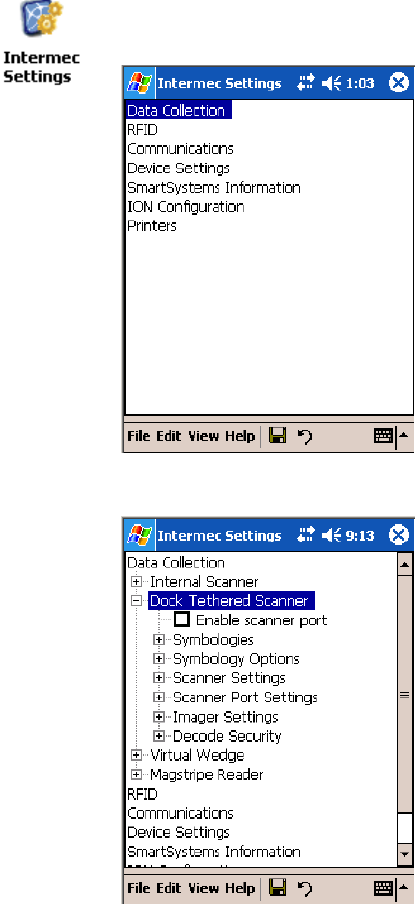
6 Scanner Support—Chapter
177700 Series Color Mobile Computer User’s Manual
Tethered Scanners
The Intermec Tethered Scanner feature allows Automatic Data Collection
(ADC) by accepting data from the COM1 port and wedging it into the
keyboard interface. You can enable or disable this feature from the Today
screen on the 700 Color Computer.
Configuring the Tethered Scanner
Before you configure your tethered scanner, adjust its settings using the
Intermec Settings applet. Information about the settings you can configure
with this applet is described in the Intermec Computer Command Reference
Manual. The online manual is available from the Intermec web site at
www.intermec.com.
1Connect your tethered scanner to the tethered scanner port.
2From the 700 Color Computer, tap Start >Settings >theSystem tab >
the Intermec Settings icon.
3Tap Data Collection, then tap (+) to expand Dock Tethered Scanner.

Scanner SupportChapter —6
178 700 Series Color Mobile Computer User’s Manual
4Tap (+) to expand Scanner Settings,tapScanner model,thenenterthe
applicable scanner, such as “1551E” or “1553.”
5Make sure a scanner is properly connected to your 700 Computer, tap
to check Enable scanner port,thentapFile >Save Settings from the
bottom of the screen. These changes take several moments to reset.
1551E or 1553 Selected for Scanner Model
When “1551E” or “1553” is selected from the Scanner model option (see
step 4 above), and the port state is already enabled (see step 5),theprocess
will take several moments to reset. When 1551E or 1553 is successfully
connected during this step, the unit will emit some beeps. Here, the termi-
nal is initializing the scanner at 9600 for the baud rate, 7 data bits, even
parity, and 2 stop bits and synchronizing the terminal’s configuration with
the attached scanner.
With “1551E” or “1553” selected, Symbologies, Symbology Options,
Hardware Trigger, and Scanner Port settings are configured from the In-
termec Settings applet. See the the Intermec Computer Command Reference

6 Scanner Support—Chapter
179700 Series Color Mobile Computer User’s Manual
Manual, available from the Intermec web site at www.intermec.com, for
more information about each enabled option.
ASCII Selected for Scanner Model
To send data coming into the 700 Color Computer through the COM1
port from an external input device, as keyboard data to an application on
the desktop, do the following:
1Enter “ASCII” as the Scanner model option.
2Tap to check Enable scanner port.
3Tap File >Save Settings from the bottom of the screen, or tap Yes
when prompted to refresh the scanner settings.
With “ASCII” selected, Symbology Options, Hardware Trigger, and Scan-
ner Port settings are configured from the Intermec Settings applet. See the
the Intermec Computer Command Reference Manual, available from the In-
termec web site at www.intermec.com, for more information about each
enabled option.
Note: When selecting either the 1551E or the 1553 Scanner or enabling
the scanner port for these scanners, the 700 Computer tries to communi-
cate with the attached scanner. If the scanner is not powered, if the cable is
not connected properly, the wrong cable is used, or if the scanner firmware
is older than 2.0, and the “Failed to save one or more settings” message
appears, then this step failed.
This process can take time as the terminal is going through a group of
RS-232 settings to communicate with the scanner. After successful com-
municated with the scanner (about eight beeps are generated), it initializes
the scanner with the 700 Computer’s current settings. This process might
generate a series of beeps pending on the firmware version installed in the
scanner. These beeps are suppressed in firmware versions 2.08 or greater.
Troubleshooting the 1551E/1553 Tethered Scanner
Do the following to troubleshoot your 1551E/1553 Tethered Scanner:
1Ensure the correct cable is used for the scanner on the tethered scanner
port. Note the 700 Computer cannot supply power to the scanner.
2Perform a quick test to determine whether the connection is good.
Temporary select the scanner model as “ASCII,” then enable the scan-
ner port state. Go to a command prompt or a notepad and scan a data
label. If a label is wedged into the command prompt or notepad, then
the connection is good.
3If step 2 passes, reset the scanner configurations to their defaults (scan
the Reset Factory Defaults label on the next page) to prevent miscom-
munication, then reenable the scanner port state.
4If step 2 fails, then the firmware installed in the tethered scanner may be
older than version 2.0. Upgrade your scanner firmware.

Scanner SupportChapter —6
180 700 Series Color Mobile Computer User’s Manual
Reset Factory Defaults
Scan the EasySet software bar code label “Reset Factory Default” to restore
all of your scanner’s configurations to their factory defaults. When this
command label is scanned, reinitialize the tethered scanner (such as disable
the scanner port state, then enable it) on the 700 Computer. Otherwise,
the online configuration and scanning on the 700 Computer are not func-
tional. In general, scan this label only to initially reset the scanner.
Do not scan EasySet command labels to change the following settings:
SSymbologies code mark SCode 128, EAN29 Identifier
SPreamble and Postamble SEnable/Disable symbologies
SSymbology ID transmit option
In some cases, scanning EasySet Command labels cause the current setting
on the user interface to be out of sync with the scanner settings. However,
in some cases, scanning these labels does corrupt scanned data.
The “Open COMx error: 0x00000037” message appears if the COM port
cannot open due to another application using the port. Disable that ap-
plication to free up the COM1 port before you can enable the scanner. “x”
is the COM port number, such as 1, 2, or 3.
Tethered Scanner Supported Symbologies
The user interface may allow configuration of PDF417, Micro PDF417,
RSS, and Codablock bar code symbologies. However, these symbologies
are dependant on what scanner models and firmware versions are in use.
See the following table for a guideline on each supported symbology:
You can use a generic ASCII scanner with the 700 Color Computer.
Pending on the scanner, linear symbologies such as Code39, should de-
code correctly. However, 2D symbologies such as PDF417 may not de-
code correctly.
Symbologies 1551E 1553
Code39 XX
UPC/EAN X X
Code 128 XX
Interleaved 2 of 5 X X
Code 93 XX
Codabar X X
Code 2 of 5 XX
MSI X X
Plessey XX
Code 11 X X
Matrix 2 of 5 XX
Telepen X X

6 Scanner Support—Chapter
181700 Series Color Mobile Computer User’s Manual
15531551ESymbologies
PDF417 Available in 1551 0808 PDF
Micro PDF417 Available in 1551 0808 PDF, Sxxp217_ or later
MaxiCode
Data Matrix
QR Code
RSS 14 F/w version 2.15 or later F/w version 2.15 or later
RSS Limited F/w version 2.15 or later F/w version 2.15 or later
RSS Expanded F/w version 2.15 or later F/w version 2.15 or later
Codablock A Available in 1551 0808 PDF
Codablock F Available in 1551 0808 PDF
UCC Composite
Attached RFID Readers
Note: The 700 Color Computer currently supports only the IP4 Intellitag
Portable RFID Reader, a trigger handle accessory that lets you hold your
700 Color Computer like a reader or scanner. Contact your Intermec rep-
resentative for more information.
Radio frequency identification (RFID) systems evolved as a way to provide
all the benefits of visual scanning systems, while overcoming many of their
limitations. Radio frequency (RF) describes electromagnetic waves in the
10 kHz to 10 GHz range. Electronic identification (ID) systems transfer
data messages from an object to be identified to a data management sys-
tem. RFID systems use radio frequency to transfer data between an item
being tracked and a reader/writer. It is a fast, automatic identification
technology.
More information about RFID and the IP4 Reader are in the following
Intermec publications. PDFs of these publications are available from the
Intermec web site at www.intermec.com.
SBasic Reader Interface Programmer’s Reference Manual
(P/N: 937-000-001)
SIntermec RFID System Manual (P/N: 936-000-001)
SIP4 Handheld Reader Instructions (P/N: 943-002-002)
SIP4 Handheld Reader Manual Supplement (P/N: 933-000-001)
Reading RFID Tags with the Virtual Wedge
The virtual wedge is a Data Collection services feature that enters bar code
and RFID tag data into a software application as if it were typed at the
keypad. This section explains how to configure the 700 Color Computer
to read RFID tags through the virtual wedge. Contact your Intermec rep-
resentative for more information about the virtual wedge.
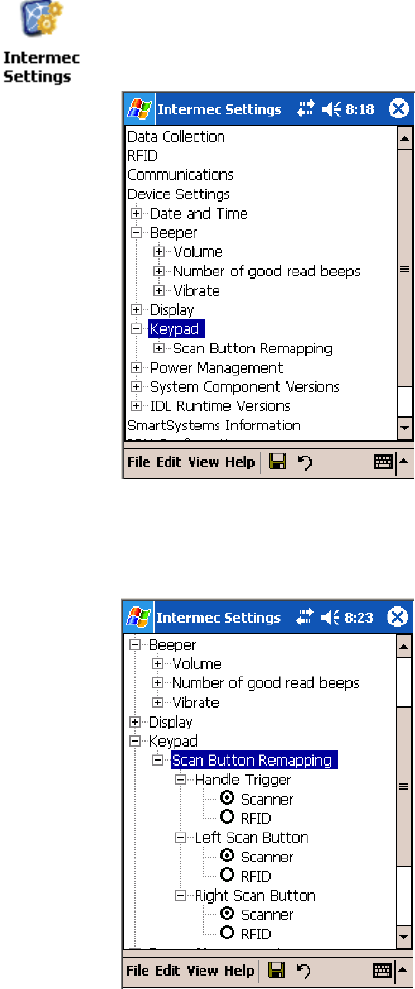
Scanner SupportChapter —6
182 700 Series Color Mobile Computer User’s Manual
Do the following to configure your virtual wedge to do RFID tags.
SConfigure at least one scan button on the 700 Color Computer to trig-
ger RFID (gotothenextparagraph).
SDisable power to Bluetooth (go to page 183 for instructions).
SEnable the IP4 Reader (go to page 184 for instructions).
Use the Intermec Settings applet to configure at least one scan button. In-
formation about the settings you can configure with this applet is de-
scribed in the Intermec Computer Command Reference Manual.Theonline
manual is available from the Intermec web site at www.intermec.com.
1From the 700 Color Computer, tap Start >Settings >theSystem tab >
the Intermec Settings icon > the Device Settings option, then tap (+) to
expand the Keypad option.
2Tap (+) to expand Scan Button Remapping, then tap (+) to expand any
of the Handle Trigger,theLeft Scan Button,ortheRight Scan Button
options. Note that the Handle Trigger option is for the IP4 Reader.
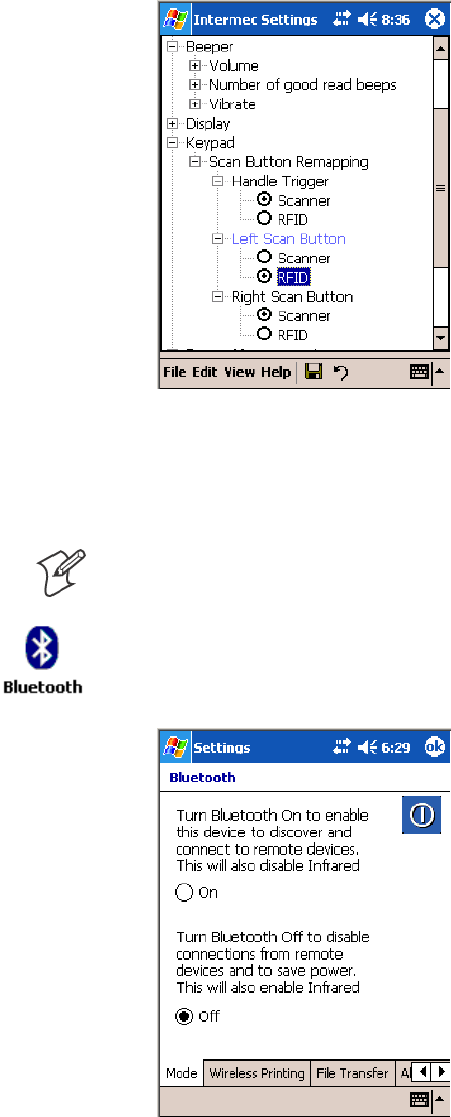
6 Scanner Support—Chapter
183700 Series Color Mobile Computer User’s Manual
3Select RFID to change the trigger from the scanner to RFID, then select
File >Save Settings.
4Go to the next paragraph to disable power to Bluetooth.
5Go to page 184 to enable the IP4 Reader.
Disable Power to Bluetooth
Note: Before you configure your attached IP4 Reader, make sure Blue-
tooth is disabled on your 700 Color Computer.
1Tap Start >Settings >theConnections tab>theBluetooth icon.
2Check whether Off isselected.Ifnot,thencheckOff.Waitmomentari-
ly for Bluetooth to turn off, then click ok to close the Bluetooth applet.
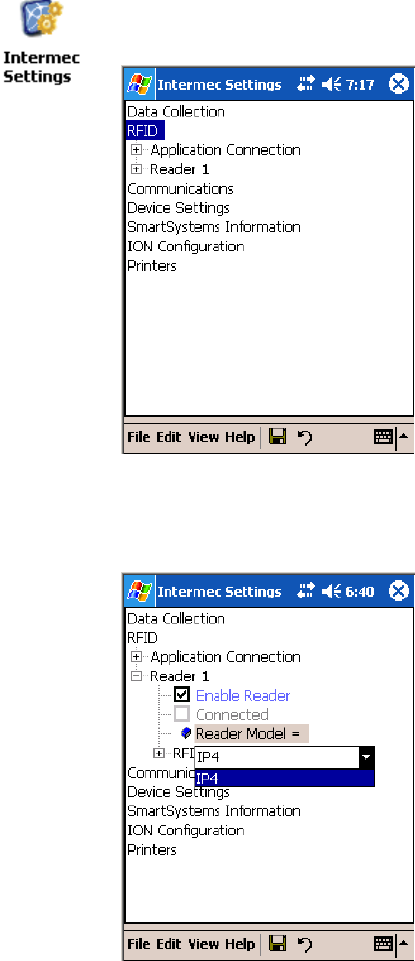
Scanner SupportChapter —6
184 700 Series Color Mobile Computer User’s Manual
Configure the Reader Using Intermec Settings
You should also adjust its settings using the Intermec Settings applet. In-
formation about the settings you can configure with this applet is de-
scribed in the Intermec Computer Command Reference Manual.Theonline
manual is available from the Intermec web site at www.intermec.com.
1Connect your reader to the reader port.
1From the 700 Color Computer, tap Start >Settings >theSystem tab >
the Intermec Settings icon > the RFID option.
2Tap (+) to expand Reader 1 and ensure Reader Model shows “IP4” as
the model of choice. If not, then tap Reader Model, tap its drop-down,
then select “IP4.”
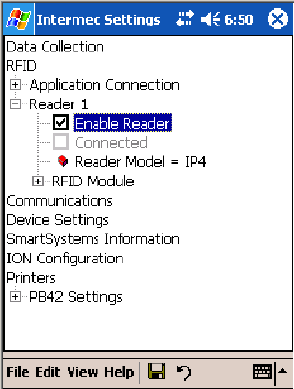
6 Scanner Support—Chapter
185700 Series Color Mobile Computer User’s Manual
3Under the Reader option, check Enable Reader to enable the attached
reader.
Once the IP4 reader is configured using the Intermec Settings applet, ap-
plications can access the IP4 Reader using the Basic Reader Interface (BRI)
protocol on the 700 Color TCP port “2189.”
Scanner SupportChapter —6
186 700 Series Color Mobile Computer User’s Manual

187700 Series Color Mobile Computer User’s Manual
Programming
7
The following programming information pertains to the 700 Series Color
Mobile Computer:
SCreating CAB Files (page 188)
SCustomization and Lockdown (page 202)
SFTP Server (page 203)
SKernel I/O Control Functions (page 210)
SNetwork Selection APIs (page 221)
SNotifications (page 221)
SReboot Functions (page 222)
SRemapping the Keypad (page 223)
Note: “700 Color” pertains to 730, 740, 741, 750, 751, 760, and 761
Computers unless otherwise noted.
ProgrammingChapter —7
188 700 Series Color Mobile Computer User’s Manual
Creating CAB Files
The Windows CE operating system uses a .CAB file to install an applica-
tion on a Windows CE-based device. A .CAB file is composed of multiple
files that are compressed into one file. Compressing multiple files into one
file provides the following benefits:
SAll application files are present.
SA partial installation is prevented.
SThe application can be installed from several sources, such as a desktop
computer or a Web site.
Use the CAB Wizard application (CABWIZ.EXE) to generate a .CAB file
for your application.
Creating Device-Specific CAB Files
Do the following to create a device-specific .CAB file for an application, in
the order provided:
1Create an .INF file with Windows CE-specific modifications (page
188).
2Optional Create a SETUP.DLL file to provide custom control of the
installation process (page 197).
3Use the CAB Wizard to create the .CAB file, using the .INF file, the
optional SETUP.DLL file, and the device-specific application files as
parameters (page 201).
Creating an .INF File
An .INF file specifies information about an application for the CAB Wi-
zard. Below are the sections of an .INF file:
[Version]
This specifies the creator of the file, version, and other relevant informa-
tion.
Required? Yes
SSignature:“signature_name”
“$Windows NT$”
SProvider:“INF_creator”
The company name of the application, such as “Microsoft.”
SCESignature
“$Windows CE$”
Example
[Version]
Signature = “$Windows NT$”
Provider = “Intermec”
CESignature = “$Windows CE$”
Programming—Chapter 7
189700 Series Color Mobile Computer User’s Manual
[CEStrings]
This specifies string substitutions for the application name and the default
installation directory.
Required? Yes
SAppName:app_name
Name of the application. Other instances of %AppName% in the .INF
file are replaced with this string value, such as RP32.
SInstallDir:default_install_dir
Default installation directory on the device. Other instances of %Install-
Dir% in the .INF file are replaced with this string value. Example:
\SDMMC_Disk\%AppName%
Example
[CEStrings]
AppName=“Game Pack”
InstallDir=%CE1%\%AppName%
[Strings]
This section is optional and defines one or more string keys. A string key
represents a string of printable characters.
Required? No
Sstring_key:value
String consisting of letters, digits, or other printable characters. Enclose
value in double quotation marks ““”” if corresponding string key is used
in an item requiring double quotation marks. No string_keys is okay.
Example
[Strings]
reg_path = Software\Intermec\My Test App
[CEDevice]
Describes the platform for the targeted application. All keys are optional.
If a key is nonexistent or has no data, Windows CE does not perform any
checking except the UnsupportedPlatforms.IftheUnsupportedPlatforms key
exists but no data, the previous value is not overridden.
Required? Yes
SProcessorType :processor_type
The value that is returned by SYSTEMINFO.dwProcessorType.For
example, the value for the ARM CPU is 2577
SUnsupportedPlatforms:platform_family_name
This lists known unsupported platform family names. If the name
specified in the [CEDevice.xxx] section is different from that in the
[CEDevice] section, both platform_family_name values are unsupported
for the microprocessor specified by xxx. That is, the list of unsupported
platform family names is appended to the previous list of unsupported
names. Application Manager will not display the application for an
unsupported platform. Also, a user will be warned during the setup
process if the .CAB file is copied to an unsupported device.

ProgrammingChapter —7
190 700 Series Color Mobile Computer User’s Manual
Example
[CEDevice]
UnsupportedPlatforms = pltfrm1 ; pltfrm1 is unsupported
[CEDevice.SH3]
UnsupportedPlatforms = ; pltfrm1 is still unsupported
SVersionMin:minor_version
Numeric value returned by OSVERSIONINFO.dwVersionMinor. The
.CAB file is valid for the currently connected device if the version of
this device is greater than or equal to VersionMin.
SVersionMax:major_version
Numeric value returned by OSVERSIONINFO.dwVersionMajor. The
.CAB file is valid for the currently connected device if the version of
this device is less than or equal to VersionMax.
SBuildMin:build_number
Numeric value returned by OSVERSIONINFO.dwBuildNumber. The
.CAB file is valid for the currently connected device if the version of
this device is greater than or equal to BuildMin.
SBuildMax:build_number
Numeric value returned by OSVERSIONINFO.dwBuildNumber. The
.CAB file is valid for the currently connected device if the version of
this device is less than or equal to BuildMax.
Example
The following code example shows three [CEDevice] sections: one that
gives basic information for any CPU and two that are specific to the SH3
and the MIPS microprocessors.
[CEDevice] ; A “template” for all platforms
UnsupportedPlatforms = pltfrm1 ; Does not support pltfrm1
; The following specifies version 1.0 devices only.
VersionMin = 1.0
VersionMax = 1.0
[CEDevice.ARM] ; Inherits all [CEDevice] settings
; This will create a .CAB file specific to ARM devices.
ProcessorType = 2577 ; ARM .cab file is valid for ARM microprocessors.
UnsupportedPlatforms = ; pltfrm1 is still unsupported
; The following overrides the version settings so that no version checking is
performed.
VersionMin =
VersionMax =
[CEDevice.MIPS] ; Inherits all [CEDevice] settings
; This will create a .CAB file specific to “MIPS” devices.
ProcessorType = 4000 ; MIPS .CAB file is valid for MIPS
microprocessor.
UnsupportedPlatforms =pltfrm2 ; pltfrm1,pltfrm2 unsupported for MIPs .CAB
file.
Note: To create the two CPU-specific .CAB files for the SETUP.INF file
in the previous example, run the CAB Wizard with the “/cpu arm mips”
parameter.
Programming—Chapter 7
191700 Series Color Mobile Computer User’s Manual
[DefaultInstall]
This describes the default installation of your application. Note that under
this section, you will list items expanded upon later in this description.
Required? Yes
SCopyfiles:copyfile_list_section
Maps to files defined later in the .INF file, such as Files.App, Files.Font,
and Files.Bitmaps.
SAddReg:add_registry_section
Example: RegSettings.All
SCEShortcuts:shortcut_list_section
String that identifies one more section that defines shortcuts to a file, as
defined in the [CEShortcuts] section.
SCESetupDLL:setup_DLL
Optimal string that specifies a SETUP.DLL file. It is written by the In-
dependent Software Vendor (ISV) and contains customized functions
for operations during installation and removal of the application. The
file must be specified in the [SourceDisksFiles] section.
SCESelfRegister:self_reg_DLL_filename
String that identifies files that self-register by exporting the DllRegister-
Server and DllUnregisterServer Component Object Model (COM)
functions. Specify these files in the [SourceDiskFiles] section. During
installation, if installation on the device fails to call the file’s exported
DllRegisterServer function, the file’s exported DllUnregisterServer
function will not be called during removal.
Example
[DefaultInstall]
AddReg = RegSettings.All
CEShortcuts = Shortcuts.All
[SourceDiskNames]
This section describes the name and path of the disk on which your ap-
plication resides.
Required? Yes
Sdisk_ordinal:disk_label,,path
1=,“App files” , C:\Appsoft\RP32\...
2=,“Font files”,,C:\RpTools\...
3=,“CE Tools” ,,C:\windows ce tools...
SCESignature: “$Windows CE$”
Example
[SourceDisksNames] ; Required section
1 = ,“Common files”,,C:\app\common ; Using an absolute path
[SourceDisksNames.SH3]
2 = ,“SH3 files”,,sh3 ; Using a relative path
[SourceDisksNames.MIPS]
2 = ,“MIPS files”,,mips ; Using a relative path

ProgrammingChapter —7
192 700 Series Color Mobile Computer User’s Manual
[SourceDiskFiles]
This describes the name and path of the files in which your application
resides.
Required? Yes
Sfilename:disk_number[,subdir]
RPM.EXE = 1,c:\appsoft\...
WCESTART.INI = 1
RPMCE212.INI = 1
TAHOMA.TTF = 2
Note:[,subdir] is relative to the location of the INF file.
Example
[SourceDisksFiles] ; Required section
begin.wav = 1
end.wav = 1
sample.hlp = 1
[SourceDisksFiles.SH3]
sample.exe = 2 ; Uses the SourceDisksNames.SH3 identification of 2.
[SourceDisksFiles.MIPS]
sample.exe = 2 ; Uses the SourceDisksNames.MIPS identification of 2.
[DestinationDirs]
This describes the names and paths of the destination directories for the
application on the target device. Note Windows CE does not support directo-
ry identifiers.
Required? Yes
Sfile_list_section:0,subdir
String that identifies the destination directory. The following list shows
the string substitutions supported by Windows CE. Use these only for
the beginning of the path. \
%CE1% \Program Files
%CE2% \Windows
%CE3% \My Documents
%CE4% \Windows\Startup
%CE5% \My Documents
%CE6% \Program Files\Accessories
%CE7% \Program Files\Communication
%CE8% \Program Files\Games
%CE9% \Program Files\Pocket Outlook
%CE10% \Program Files\Office
%CE11% \Windows\Start Menu\Programs
%CE12% \Windows\Start Menu\Programs\Accessories
%CE13% \Windows\Start Menu\Programs\Communications
%CE14% \Windows\Start Menu\Programs\Games
%CE15% \Windows\Fonts
%CE16% \Windows\Recent
%CE17% \Windows\Start Menu
%InstallDir%

Programming—Chapter 7
193700 Series Color Mobile Computer User’s Manual
Contains the path to the target directory selected during installation. It
is declared in the [CEStrings] section
%AppName%
Contains the application name defined in the [CEStrings] section.
Example
[DestinationDirs]
Files.Common = 0,%CE1%\My Subdir ; \Program Files\My Subdir
Files.Shared = 0,%CE2% ; \Windows
[CopyFiles]
This section, under the [DefaultInstall] section, describes the default files
to copy to the target device. Within the [DefaultInstall] section, files were
listed that must be defined elsewhere in the INF file. This section identi-
fies that mapping and may contain flags.
Required? Yes
Scopyfile_list_section:destination_filename,[source_filename]
The source_filename parameter is optional if it is the same as destina-
tion_filename.
Scopyfile_list_section:flags
The numeric value that specifies an action to be done while copying fi-
les. The following table shows values supported by Windows CE.
Flag Value Description
COPYFLG_WARN_IF_SKIP 0x00000001 Warn user if skipping a file is attempted after error.
COPYFLG_NOSKIP 0x00000002 Do not allow a user to skip copying a file.
COPYFLG_NO_OVERWRITE 0x00000010 Do not overwrite files in destination directory.
COPYFLG_REPLACEONLY 0x00000400 Copy the source file to the destination directory only if the
file is already in the destination directory.
CE_COPYFLG_NO_DATE_DIALOG 0x20000000 Do not copy files if the target file is newer.
CE_COPYFLG_NODATECHECK 0x40000000 Ignore date while overwriting the target file.
CE_COPYFLG_SHARED 0x80000000 Create a reference when a shared DLL is counted.
Example
[DefaultInstall.SH3]
CopyFiles = Files.Common, Files.SH3
[DefaultInstall.MIPS]
CopyFiles = Files.Common, Files.MIPS
[AddReg]
This section, under the [DefaultInstall] section, is optional and describes
the keys and values that the .CAB file adds to the device registry. Within
the [DefaultInstall] section, a reference may have been made to this
section, such as “AddReg=RegSettings.All”. This section defines the
options for that setting.
Required? No

ProgrammingChapter —7
194 700 Series Color Mobile Computer User’s Manual
Sadd_registry_section:registry_root_string
String that specifies the registry root location. The following list shows
the values supported by Windows CE.
SHKCR Same as HKEY_CLASSES_ROOT
SHKCU Same as HKEY_CURRENT_USER
SHKLM Same as HKEY_LOCAL_MACHINE
Sadd_registry_section:value_name
Registry value name. If empty, the “default” registry value name is used.
Sadd_registry_section:flags
Numeric value that specifies information about the registry key. The
following table shows the values that are supported by Window CE.
Flag Value Description
FLG_ADDREG_NOCLOBBER 0x00000002 If the registry key exists, do not overwrite it. Can be used
with any of the other flags in this table.
FLG_ADDREG_TYPE_SZ 0x00000000 REG_SZ registry data type.
FLG_ADDREG_TYPE_MULTI_SZ 0x00010000 REG_MULTI_SZ registry data type. Value field that follows
can be a list of strings separated by commas.
FLG_ADDREG_TYPE_BINARY 0x00000001 REG_BINARY registry data type. Value field that follows
must be a list of numeric values separated by commas, one
byte per field, and must not use the 0x hexadecimal prefix.
FLG_ADDREG_TYPE_DWORD 0x00010001 REG_DWORD data type. The noncompatible format in the
Win32 Setup .INF documentation is supported.
Example
AddReg = RegSettings.All
[RegSettings.All]
HKLM,%reg_path%,,0x00000000,alpha ; <default> = “alpha”
HKLM,%reg_path%,test,0x00010001,3 ; Test = 3
HKLM,%reg_path%\new,another,0x00010001,6 ; New\another = 6
[CEShortCuts]
This section, a Windows CE-specific section under the [DefaultInstall]
section, is optional and describes the shortcuts that the installation applica-
tion creates on the device. Within the [DefaultInstall] section, a reference
may have been made to this section, such as “ShortCuts.All”. This section
defines the options for that setting.
Required? No
Sshortcut_list_section:shortcut_filename
String that identifies the shortcut name. It does not require the .LNK
extension.
Sshortcut_list_section:shortcut_type_flag
Numeric value. Zero or empty represents a shortcut to a file; any non-
zero numeric value represents a shortcut to a folder.
Programming—Chapter 7
195700 Series Color Mobile Computer User’s Manual
Sshortcut_list_section:target_file_path
String value that specifies the destination location. Use the target file
name for a file, such as MyApp.exe, that must be defined in a file copy
list. For a path, use a file_list_section name defined in the [Destination-
Dirs] section, such as DefaultDestDir,orthe%InstallDir% string.
Sshortcut_list_section:standard_destination_path
Optional string value. A standard %CEx% path or %InstallDir%.Ifno
value is specified, the shortcut_list_section name of the current section or
the DefaultDestDir value from the [DestinationDirs] section is used.
Example
CEShortcuts = Shortcuts.All
[Shortcuts.All]
Sample App,0,sample.exe ; Uses the path in DestinationDirs. Sample
App,0,sample.exe,%InstallDir% ; The path is explicitly specified.
Sample .INF File
[Version] ; Required section
Signature = “$Windows NT$”
Provider = “Intermec Technologies Corporation”
CESignature = “$Windows CE$”
;[CEDevice]
;ProcessorType =
[DefaultInstall] ; Required section
CopyFiles = Files.App, Files.Fonts, Files.BitMaps, Files.Intl,
Files.TelecomNcsCE, Files.Windows, Files.Import, Files.Export, Files.Work,
Files.Database, Files.WinCE AddReg = RegSettings.All ;CEShortcuts =
Shortcuts.All
[SourceDisksNames] ; Required section
1 = ,“App files” ,,c:\appsoft\...
2 = ,”Font files” ,,c:\WinNT\Fonts
3 = ,”CE Tools” ,,c:\windows ce tools\wce400\700ie\mfc\lib\x86
[SourceDisksFiles] ; Required section
rpm.exe = 1,C:\Appsoft\program\wce400\WCEX86Rel700
wcestart.ini = 1
rpmce212.ini = 1
intermec.bmp = 1
rpmlogo.bmp = 1
rpmname.bmp = 1
import.bmp = 1
export.bmp = 1
clock.bmp = 1
printer.bmp = 1
filecopy.bmp = 1
readme.txt = 1
lang_eng.bin = 1
rpmdata.dbd = 1,database\wce1
tahoma.ttf = 2
mfcce212.dll = 3
olece212.dll = 3
olece211.dll = 1,c:\windows ce tools\wce400\NMSD61102.11\mfc\lib\x86
rdm45wce.dll = 1,c:\rptools\rdm45wce\4_50\lib\wce400\wcex86rel
picfmt.dll = 1,c:\rptools\picfmt\1_00\wce400\wcex86rel6110
ProgrammingChapter —7
196 700 Series Color Mobile Computer User’s Manual
fmtctrl.dll = 1,c:\rptools\fmtctrl\1_00\wce400\wcex86rel6110
ugrid.dll = 1,c:\rptools\ugrid\1_00\wce400\wcex86rel6110
simple.dll = 1,c:\rptools\pspbm0c\1_00\wce400\wcex86rel
psink.dll = 1,c:\rptools\psink\1_00\wce400\WCEX86RelMinDependency
pslpwce.dll =1,c:\rptools\pslpm0c\1_00\wce400\WCEX86RelMinDependency
npcpport.dll = 1,c:\rptools\cedk\212_03\installable drivers\printer\npcp
;dexcom.dll = 1,c:\rptools\psdxm0c\1_00\x86
ncsce.exe = 1,c:\rptools\ncsce\1_04
nrinet.dll = 1,c:\rptools\ncsce\1_04
[DestinationDirs] ; Required section
;Shortcuts.All = 0,%CE3% ; \Windows\Desktop
Files.App = 0,%InstallDir%
Files.DataBase = 0,%InstallDir%\DataBase
Files.BitMaps = 0,%InstallDir%\Bitmaps
Files.Fonts = 0,%InstallDir%\Fonts
Files.Intl = 0,%InstallDir%\Intl
Files.TelecomNcsCE = 0,%InstallDir%\Telecom\NcsCE
Files.Windows = 0,%InstallDir%\Windows
Files.Import = 0,%InstallDir%\Import
Files.Export = 0,%InstallDir%\Export
Files.Work = 0,%InstallDir%\Work
Files.WinCE = 0,\storage_card\wince
[CEStrings] ; Required section
AppName = Rp32
InstallDir = \storage_card\%AppName%
[Strings] ; Optional section
;[Shortcuts.All]
;Sample App,0,sample.exe ; Uses the path in DestinationDirs.
;Sample App,0,sample.exe,%InstallDir% ; The path is explicitly specified.
[Files.App]
rpm.exe,,,0
rpm.ini,rpmce212.ini,,0
mfcce212.dll,,,0
olece212.dll,,,0
olece211.dll,,,0
rdm45wce.dll,,,0
picfmt.dll,,,0
fmtctrl.dll,,,0
ugrid.dll,,,0
simple.dll,,,0
psink.dll,,,0
pslpwce.dll,,,0
npcpport.dll,,,0
;dexcom.dll,,,0
[Files.DataBase]
rpmdata.dbd,,,0
[Files.Fonts]
tahoma.ttf,,,0
[Files.BitMaps]
intermec.bmp,,,0
rpmlogo.bmp,,,0
rpmname.bmp,,,0
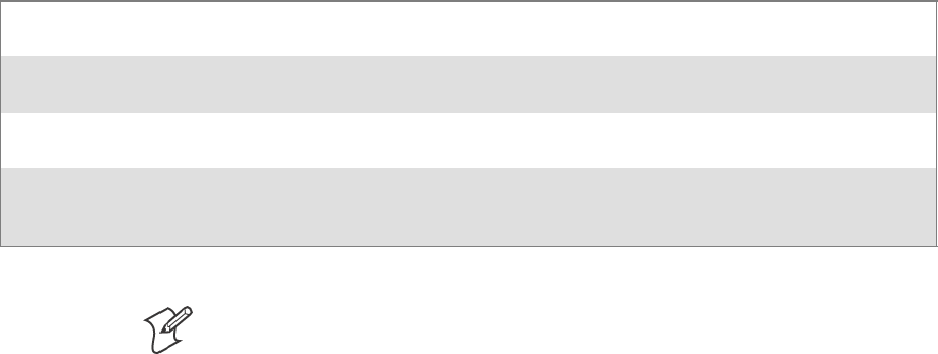
Programming—Chapter 7
197700 Series Color Mobile Computer User’s Manual
import.bmp,,,0
export.bmp,,,0
clock.bmp,,,0
printer.bmp,,,0
filecopy.bmp,,,0
[Files.Intl]
lang_eng.bin,,,0
[Files.TelecomNcsCE]
ncsce.exe,,,0
nrinet.dll,,,0
[Files.Windows]
readme.txt,,,0
[Files.Import]
readme.txt,,,0
[Files.Export]
readme.txt,,,0
[Files.Work]
readme.txt,,,0
[Files.WinCE]
wcestart.ini,,,0
[RegSettings.All]
HKLM,”SOFTWARE\Microsoft\Shell\AutoHide”,,0x00010001,1
; Autohide the taskbar HKLM,”SOFTWARE\Microsoft\Shell\OnTop”,,0x00010001,0
; Shell is not on top
HKLM,”SOFTWARE\Microsoft\Clock”,SHOW_CLOCK,0x00010001,0
; Clock is not on taskbar
Using Installation Functions in SETUP.DLL
SETUP.DLL is an optional file that enables you to perform custom opera-
tions during installation and removal of your application. The following
list shows the functions that are exported by SETUP.DLL.
Install_Init Called before installation begins. Use this function to check the application version when reinstal-
ling an application and to determine if a dependent application is present.
Install_Exit Called after installation is complete. Use this function to handle errors that occur during applica-
tion installation.
Uninstall_Init Called before the removal process begins. Use this function to close the application, if the applica-
tion is running.
Uninstall_Exit Called after the removal process is complete. Use this function to save database information to a
file and delete the database and to tell the user where the user data files are stored and how to rein-
stall the application.
Note;Use[DefaultInstall] >CESelfRegister (page 191) in the .INF file to
point to SETUP.DLL.
ProgrammingChapter —7
198 700 Series Color Mobile Computer User’s Manual
After the CAB File Extraction
Cab files that need to cause a warm reset after cab extraction will need to
create the __RESETMEPLEASE__.TXT file in the “\Windows” directory.
The preferred method to create this file is within the DllMain portion of
the SETUP.DLL file. It looks like this:
#include <windows.h>
#include <Tlhelp32.h>
#include <winioctl.h>
#include <ce_setup.h> // in the public SDK dir
#define IOCTL_TERMINAL_RESET CTL_CODE (FILE_DEVICE_UNKNOWN,FILE_ANY_ACCESS,
2050, METHOD_NEITHER)
BOOL APIENTRY DllMain( HANDLE h, DWORD reason, LPVOID lpReserved )
{
return TRUE;
} // DllMain
//************************************************************************
// $DOCBEGIN$
// BOOL IsProcessRunning( TCHAR * pname );
//
// Description: Get process table snapshot, look for pname running.
//
// Arguments: pname - pointer to name of program to look for.
// for example, app.exe.
//
// Returns: TRUE - process is running.
// FALSE - process is not running.
// $DOCEND$
//************************************************************************
BOOL IsProcessRunning( TCHAR * pname )
{
HANDLE hProcList;
PROCESSENTRY32 peProcess;
DWORD thDeviceProcessID;
TCHAR lpname[MAX_PATH];
if ( !pname || !*pname ) return FALSE;
_tcscpy( lpname, pname );
_tcslwr( lpname );
hProcList = CreateToolhelp32Snapshot( TH32CS_SNAPPROCESS, 0 );
if ( hProcList == INVALID_HANDLE_VALUE ) {
return FALSE;
} // end if
memset( &peProcess, 0, sizeof(peProcess) );
peProcess.dwSize = sizeof(peProcess);
if ( !Process32First( hProcList, &peProcess)){
CloseToolhelp32Snapshot( hProcList );
return FALSE;
} // end if
Programming—Chapter 7
199700 Series Color Mobile Computer User’s Manual
thDeviceProcessID = 0;
do {
_tcslwr( peProcess.szExeFile );
if ( _tcsstr( peProcess.szExeFile, lpname)){
thDeviceProcessID = peProcess.th32ProcessID;
break;
} // end if
} while ( Process32Next( hProcList, &peProcess ) );
if ( ( GetLastError() == ERROR_NO_MORE_FILES ) && ( thDeviceProcessID == 0
)){
CloseToolhelp32Snapshot( hProcList );
return FALSE;
} // end if
CloseToolhelp32Snapshot( hProcList );
return TRUE;
} // IsProcessRunning
codeINSTALL_INIT Install_Init(
HWND hwndParent,
BOOL fFirstCall,
BOOL fPreviouslyInstalled,
LPCTSTR pszInstallDir )
{return codeINSTALL_INIT_CONTINUE;
}
codeINSTALL_EXIT Install_Exit (
HWND hwndParent,
LPCTSTR pszInstallDir,
WORD cFailedDirs,
WORD cFailedFiles,
WORD cFailedRegKeys,
WORD cFailedRegVals,
WORD cFailedShortcuts )
{
HANDLE h;
TCHAR srcfile[MAX_PATH];
TCHAR dstfile[MAX_PATH];
if (cFailedDirs || cFailedFiles || cFailedRegKeys ||
cFailedRegVals || cFailedShortcuts)
return codeINSTALL_EXIT_UNINSTALL;
if ( IsProcessRunning( L”autocab.exe” ) )
{
h = CreateFile( L”\\Windows\\__resetmeplease__.txt”,
(GENERIC_READ | GENERIC_WRITE), 0, NULL, CREATE_ALWAYS,
FILE_ATTRIBUTE_HIDDEN, NULL );
if(h!=INVALID_HANDLE_VALUE )
CloseHandle( h );
else
{
// Couldn’t create the file. If it failed because the file already
ProgrammingChapter —7
200 700 Series Color Mobile Computer User’s Manual
exists, it is not fatal.
// Otherwise, notify user of the inability to reset the device and they
will have to
// perform it manually after all of the installations are complete.
} // end if
}
else
{
DWORD dret;
h = CreateFile( L”SYI1:”,
(GENERIC_WRITE | GENERIC_READ), 0, NULL, OPEN_EXISTING,
FILE_ATTRIBUTE_NORMAL, NULL );
// Force a warm start NOW.
if(h!=INVALID_HANDLE_VALUE )
{
DeviceIoControl( h, IOCTL_TERMINAL_RESET, NULL, 0, NULL, 0, &dret,
NULL);
// Won’t return, but we’ll show clean up anyway
CloseHandle( h );
}
else
{// Couldn’t access SYSIO. Notify user.
} // end if
} // end if
return codeINSTALL_EXIT_DONE;
}
codeUNINSTALL_INIT
Uninstall_Init(
HWND hwndParent,
LPCTSTR pszInstallDir ) {
// TODO: Perform the reverse of INSTALL_INIT here
return codeUNINSTALL_INIT_CONTINUE;
}
codeUNINSTALL_EXIT
Uninstall_Exit(HWND hwndParent) {
// TODO: Perform the reverse of INSTALL_EXIT here
return codeUNINSTALL_EXIT_DONE;
}
The system software looks for the following directory structure and files on
the installed media card whether it be a Secure Digital storage card or
CompactFlash storage card or embedded flash file system. No other folders
need exist.
\2577\autorun.exe
\2577\autorun.dat
\2577\autocab.exe
\2577\autocab.dat
\cabfiles\*.cab
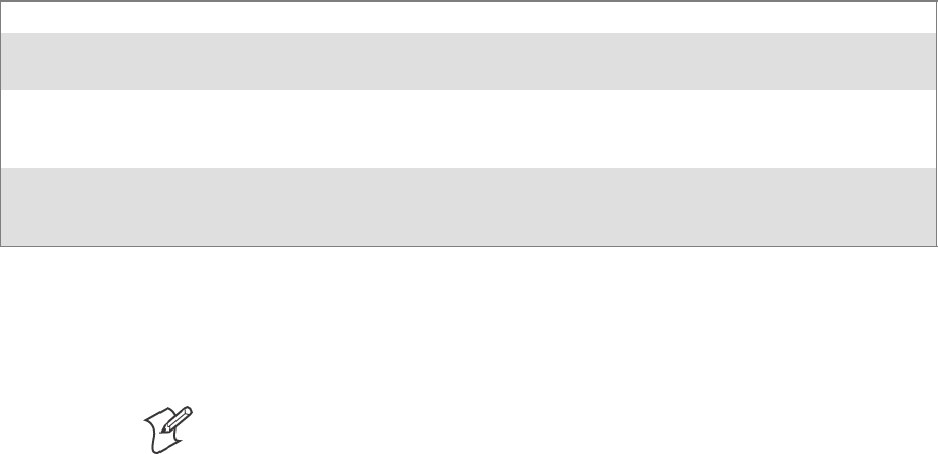
Programming—Chapter 7
201700 Series Color Mobile Computer User’s Manual
Creating CAB Files with CAB Wizard
After you create the .INF file and the optional SETUP.DLL file, use the
CAB Wizard to create the .CAB file. Below is the command-line syntax:
cabwiz.exe “inf_file” [/dest dest_directory] [/err error_file] [/cpu cpu_type
[cpu_type]]
A batch file in <program> directory, with these commands, works well:
cabwiz.exe c:\appsoft\<program>\<inf_file_name>
cd \appsoft\<program>
“inf_file” The SETUP.INF file path.
dest_directory The destination directory for the .CAB files. If no directory is specified, the .CAB files are created
in the “inf_file” directory.
error_file File name for a log file that contains all warnings and errors that are encountered when the .CAB
files are compiled. If no file name is specified, errors are displayed in message boxes. If a file name
is used, the CAB Wizard runs without the user interface (UI); this is useful for automated builds.
cpu_type Creates a .CAB file for each specified microprocessor tag, which is a label used in the Win32 SE-
TUP.INF file to differentiate between different microprocessor types. The /cpu parameter, fol-
lowed by multiple cpu_type values, must be the last qualifier in the command line.
Example
This example creates .CAB files for the ARM and MIPS microprocessors,
assuming the Win32 SETUP.INF file contains the ARM and MIPS tags:
cabwiz.exe “c:\myfile.inf” /err myfile.err /cpu arm mips
Note: CABWIZ.EXE, MAKECAB.EXE, and CABWIZ.DDF (Windows
CE files available on the Windows CE Toolkit) must be installed in the
same directory on the desktop computer. Call CABWIZ.EXE using its full
path for the CAB Wizard application to run correctly.
Troubleshooting the CAB Wizard
To identify and avoid problems that might occur when using the CAB
Wizard, follow these guidelines:
SUse %% for a percent sign (%) character when using this character in
an .INF file string, as specified in Win32 documentation. This will not
work under the [Strings] section.
SDo not use .INF or .CAB files created for Windows CE to install ap-
plications on Windows-based desktop platforms.
SEnsure the MAKECAB.EXE and CABWIZ.DDF files, included with
Windows CE, are in the same directory as CABWIZ.EXE.
SUse the full path to call CABWIZ.EXE.
SDo not create a .CAB file with the MAKECAB.EXE file included with
Windows CE. You must use CABWIZ.EXE, which uses
MAKECAB.EXE to generate the .CAB files for Windows CE.
SDo not set the read-only attribute for .CAB files.
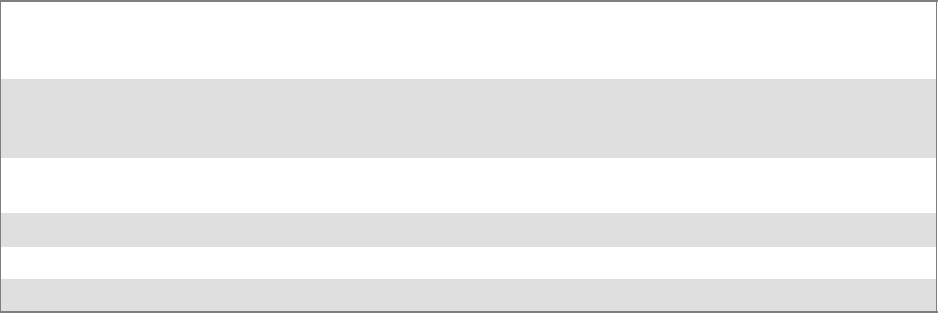
ProgrammingChapter —7
202 700 Series Color Mobile Computer User’s Manual
Customization and Lockdown
Pocket PC (Windows Mobile) is a hardware specification created by
Microsoft Corporation. Devices that wish to carry the Pocket PC logo
must meet the minimum hardware requirements set in the Pocket PC spe-
cification. Manufacturers are free to add extra hardware functionality.
Pocket PC devices also use a specialized version of the CE operating sys-
tem. This operating system is built from Windows CE 4.2 but contains
customizations, most notably the lack of a desktop and the addition of the
Today Screen.
To carry the Pocket PC logo, all devices must be tested at an Independent
Test Laboratory. The ITL testing is done based on Microsoft require-
ments. The test lab then reports the findings back to Microsoft Corpora-
tion and Intermec. If the 700 Color Computer passed all tests, Intermec is
allowed to ship the device with the Pocket PC logo. Each time the operat-
ing system is modified, Intermec must resubmit to ITL testing.
This means we cannot change the operating system much and still be a
Pocket PC device. For example, if we remove Word from the Start menu,
thedevicewouldfailITLtestingandwewouldnotbeabletoshipdevices
with the Pocket PC logo.
Although many customers want a Pocket PC device, some customers
would prefer that their users not have access to all of the Pocket PC featu-
res. Intermec cannot customize the operating system in any way but a cus-
tom application can:
Delete items from the Start menu, and Programs folder. These items are just shortcuts in the file system so the ap-
plication is not really being deleted. Cold booting the device will bring these items back so the application will need
toberunoneverycoldboot.
Use the RegFlushKey() API to save a copy of the registry to a storage device. See the 700 Color Management Tools
portion for more information on how to do this. Saving a copy of the registry restores most system settings in a cold
boot situation.
Use the SHFullScreen() API in conjunction with other APIs to make the application take up the entire display and
prevent the start menu from being available.
Remap keys and disable keys on the keypad.
Create a custom SIP.
Make changes to the registry to configure the device.
Should you want your 700 Color Computer to display a full screen, keep
in mind that your computer is Pocket-PC certified by Microsoft Corpora-
tion. Check out resources on programming for the Pocket PC, using the
following links. These give full instructions on how to display full screen.
SInstructions on how to create a full screen application for eVC++ ap-
plications using an SHFullScreen() API:
support.microsoft.com/support/kb/articles/Q266/2/44.ASP
SInstructions on how to create a full screen application for eVB applica-
tions also using the SHFullScreen() API:
support.microsoft.com/support/kb/articles/Q265/4/51.ASP

Programming—Chapter 7
203700 Series Color Mobile Computer User’s Manual
FTP Server
FTP support is provided through the FTP Server application
FTPDCE.EXE (MS Windows CE Versions) which is provided as part the
base system.
FTPDCE is the Internet File Transfer Protocol (FTP) server process. The
server can be invoked from an application or command line. Besides ser-
vicing FTP client requests the FTP Server also send a “network announce-
ment” to notify prospective clients of server availability.
Note: You should consult the RFC959 specification for proper use of
some of these commands at the following URL:
Swww.ietf.org/rfc/rfc959.txt for the text version, or
Swww.w3.org/Protocols/rfc959/ for an html version
Do the following to send commands:
1Start an FTP client and connect to the device FTP server.
2Log in with “intermec” as the user name and “cr52401” - the password.
3From the FTP client, send the command.
4Wait for a response.
Synopsis
ftpdce [options ]
Options
–Aaddr (where addr is in the form of a.b.c.d) Sets the single target address to which to send the network an-
nouncement. Default is broadcast.
–Bbyte Sets the FTP data block size. Smaller sizes may be useful over slower links. Default is 65536.
–Cname Sets the device name. Used by Intermec management software.
–Fvalue Disables the default Intermec account. A value of “0” disables the account. Default is “1”.
Note that disabling the default account without providing a working access control list on the server
will result in a device that will not accept any FTP connections.
–Hsec Sets the interval between network announcements in seconds.A value of “0” turns the network an-
nouncement off. Default is 30 seconds.
–Iaddr (where addr is in the form of a.b.c.d) Sets the preferred 6920 Communications Server (optional).
–Llog (where log is either “0” or “1”) Sets the state of logging. Default is 0 (disabled).
–Nsec Specifies the number of seconds to wait before initially starting FTP server services.
–Pport Sets the UDP port on which the network announcement will be sent. Default port is 52401.
–Qport Sets the port on which the FTP Server will listen for connections. Defaultportis21.
–Rdir Sets the FTP mount point to this directory. Default is the root folder of the object store.
–Tscrip Sets the script name for the 6920 Communications Server to process.
–Uurl Sets the default URL for this device.
–Z“parms” Sets extended parameters to be included in the network announcement.

ProgrammingChapter —7
204 700 Series Color Mobile Computer User’s Manual
Configurable Parameters Via the Registry Editor
These parameters receive default values during the Intermec FTP Server
component installation. Few of the parameters are visible in the registry by
default, but most must be created to modify the FTP server behavior.
BlockSize
Setting this parameter configures the Intermec FTP Server to transmit and
receive Ethernet packets using the specified data block size. By default, the
FTP server transmits and receives data using a 64K data block size. Adjust-
ing this value may be useful in certain wireless TCP/IP installations.
Key HKLM\Software\Intermec\IFTP
Value Type REG_DWORD - data block size, in bytes.
Valid Range 0x100-0x10000 (256-65536 decimal).
Default 65536
DeviceName
This configures the Intermec FTP Server to include the specified device
name in the Intermec Device Network Announcement (IDNA). Adjusting
this value may assign a symbolic name to this device for asset tracking.
Key HKLM\Software\Intermec\IFTP
Value Type REG_SZ
Valid Range None.
Default None.
DeviceURL
This parameter configures the Intermec FTP Server to transmit the speci-
fied URL in the IDNA. This can be used by Intermec management soft-
ware for asset management.
Key HKLM\Software\Intermec\IFTP
Value Type REG_SZ
Valid Range None.
Default None.
IDNATarget
This parameter configures the Intermec FTP Server to transmit the IDNA
to a specific destination instead of a general UDP broadcast. This parame-
ter is useful on networks that do not allow UDP broadcasts to be routed
between subnets. The use of this parameter restricts the reception of the
IDNA to the target destination only.
Key HKLM\Software\Intermec\IFTP
Value Type REG_SZ
Valid Range None.
Default None.

Programming—Chapter 7
205700 Series Color Mobile Computer User’s Manual
ManifestName
This parameter configures the Intermec FTP Server to transmit the speci-
fied manifest name in the IDNA. This parameter is used by the Intermec
6920 Communications Server for communication transactions. See the
6920 Server documentation for proper use of this parameter.
Key HKLM\Software\Intermec\IFTP
Value Type REG_SZ
Valid Range None.
Default iftp.ini
PauseAtStartup
This configures the Intermec FTP Server to sleep for the specified number
of seconds before making the FTP service available on the device.
Key HKLM\Software\Intermec\IFTP
Value Type REG_DWORD - stored in seconds.
Valid Range None.
Default 0
Root
This parameter configures the Intermec FTP Server to set the root of the
FTP mount point to the specified value. Note that this must map to an ex-
isting directory or you will not be able to log into the FTP Server.
Key HKLM\Software\Intermec\IFTP
Value Type REG_SZ
Valid Range None.
Default \
Transferring Files Over TCP/IP Networks
The File Transfer Protocol (FTP) server transfers files over TCP/IP net-
works. The FTPDCE.EXE program is a version that does not display a
window, but can run in the background.
FTPDCE is the Internet File Transfer Protocol (FTP) server process. The
server can be invoked from an application or command line. Besides ser-
vicing FTP client requests, the FTP Server also sends a “network an-
nouncement” to notify prospective clients of server availability.
Remarks
The FTP Server currently supports the following FTP requests:
CDUP Changes to the parent directory of the current working directory.
CWD Changes working directory.

ProgrammingChapter —7
206 700 Series Color Mobile Computer User’s Manual
DELE Deletes a file.
HELP Gives help information.
LIST (This FTP request is the same as the ls -lgA command). Gives list files in a directory.
MKD Makes a directory.
MODE (AlwaysUsesBinary).Specifies data transfer mode.
NLST (Not supported) Givesanamelistoffilesindirectory(thisFTPrequestisthesameasthels command).
NOOP Does nothing.
PASS Specifies a password.
PWD Prints the current working directory.
QUIT Terminates session.
RETR Retrieves a file.
RMD Removes a directory.
RNFR Specifies rename-from file name.
RNTO Specifies rename-to file name.
STOR Stores a file.
SYST Shows the operating system type of server system.
TYPE (Binary transfers only.) Specifies the data transfer type with the Type parameter.
USER Specifies user name.
XCUP (Not Normally Used) Changes the parent directory of the current working directory.
XCWD (Not Normally Used) Changes the current directory.
XMKD (Not Normally Used) Creates a directory.
XPWD (Not Normally Used) Prints the current working directory.
XRMD (Not Normally Used) Removes a directory.
SITE The following extended OEM commands are supported by the SITE request. For Microsoft FTP cli-
ents, you can send site commands by preceding the command with “quote” such as “quote site status.”
ATTRIB Gets or sets the attributes of a given file. (SITE ATTRIB)
Usage QUOTE SITE ATTRIB [+R |-R][+A |-A ][+S |-S][+H |-H][[path]
filename]
+Sets an attribute.
–Clears an attribute.
RRead-only file attribute.
AArchive file attribute.
SSystem file attribute.
HHidden file attribute.
To retrieve the attributes of a file, only specify the file. The server response will be:
200-AD SHRCEIX filename

Programming—Chapter 7
207700 Series Color Mobile Computer User’s Manual
If the flag exists in its position shown previously, it is set. Also, in addition to the
values defined above, there is also defined:
CCompressed file attribute.
EEncrypted file attribute.
IINROM file attribute.
XXIPfileattribute(executeinROM,notshadowedinRAM).
BOOT Reboots the server OS. This will cause the system on which the server is executing to
reboot. The FTP Server will shut down cleanly before reboot. All client connections
will be terminated. Cold boot is default except for the PocketPC build in which the
default is warm boot. (SITE BOOT)
Usage: QUOTE SITE BOOT [WARM |COLD]
COPY Copies a file from one location to another. (SITE COPY)
Usage: QUOTE SITE COPY [source][destination]
Example: QUOTE SITE COPY ‘\Storage Card\one.dat’ ‘\Stor-
age Card\two.dat’
EXIT Exits the FTP Server. This command will shut down the FTP Server thus termina-
ting all client connections. (SITE EXIT)
Usage: QUOTE SITE EXIT
HELP Gives site command help information. (SITE HELP)
Usage: QUOTE SITE HELP [command]
KILL Terminates a running program. (SITE KILL)
Usage: QUOTE SITE KILL [program |pid]
LOG Opens or closes the program log. (SITE LOG)
Usage: QUOTE SITE LOG [open [filename]| close]
PLIST Lists the running processes (SITE PLIST)
Usage: QUOTE SITE PLIST
RUN Starts a program running. If the program to run has spaces in path or filename,
wrappingthenamewithsinglequotesisrequired.
Usage: QUOTE SITE RUN [program]
Example: QUOTE SITE RUN ‘\Storage Card\app.exe’
STATUS Returns the current settings of the FTP Server. MAC, serial number, model, IP ad-
dress, network announcement information as well as OS memory usage are returned.
(SITE STATUS)
Usage: QUOTE SITE STATUS
TIMEOUT Toggles idle timeout between 120 to 1200 seconds (2 to 20 minutes). If this timer
expires with no activity between the client and the server, the client connection will
be disconnected. If the optional seconds argument is supplied, the server will set the
connection timeout to the number of seconds specified. Default is 120 seconds or 2
minutes. (SITE TIMEOUT)
Usage: QUOTE SITE TIMEOUT [seconds]
EKEY Gives site command electronic key information. (SITE HELP)
Usage: QUOTE SITE EKEY [command]
EVAL Gives site command electronic value information. (SITE HELP)
Usage: QUOTE SITE EVAL [command]

ProgrammingChapter —7
208 700 Series Color Mobile Computer User’s Manual
GVAL Gives site command general value information. (SITE HELP)
Usage: QUOTE SITE GVAL [command]
PVAL Gives site command value information. (SITE HELP)
Usage: QUOTE SITE PVAL [command]
The remaining FTP requests specified in RFC 959 are recognized, but not
implemented.
The banner returned in the parenthetical portion of its greeting shows the
version number of the FTP Server as well as the MAC address, serial num-
ber and operating system of the machine hosting the server.
The FTP Server supports browsing from the latest Netscape and Microsoft
web browsers. Drag-and-drop capability is available using this environ-
ment.
The FTPDCMDS subdirectory contains commands to use from the web
browser.
SClick EXITME.BIN to execute a SITE EXIT command.
SClick REBOOTME.BIN to execute SITE BOOT command.
SUse the GET command on these files to have the FTP Server execute
these commands.
SSecurity:
A customer configurable access control list may be installed on the
700 Color Computer. This list will allow customers to restrict access
via the FTP Server to users they wish and is in addition to default
Intermec accounts that are disabled using the -F0 option at runtime.
The access control list is named FTPDCE.TXT and is placed in the
same directory on the 700 Color Computer as the FTPDCE.EXE
server. The FTP Server encrypts this file to keep the information safe
from unauthorized users. This file is encrypted when the FTP Server
is started so a file that is placed onto the 700 Color Computer after
the FTP Server starts will require a restart of the FTP Server to take
effect.
The format of the FTPDCE.TXT is as follows:
FTPDCE:user1!passwd1<cr><lf>user2!passwd2<cr><lf>user3
!passwd3<cr><lf>...
Note: The user accounts and passwords are case sensitive.
Once the access control list is encrypted on the 700 Color Computer,
the FTP Server hides this file from users. Once an access control list
is installed on the 700 Color Computer, a new one is not accepted by
the FTP Server until the previous one is removed. Encrypted access
control lists are not portable between 700 Color Computers.
Stopping the FTP Server from Your Application
To allow application programmers the ability to programmatically shut
down the FTP Server, the FTP Server periodically tests to see if a named
event is signaled. ITC_IFTP_STOP is the name of this event.
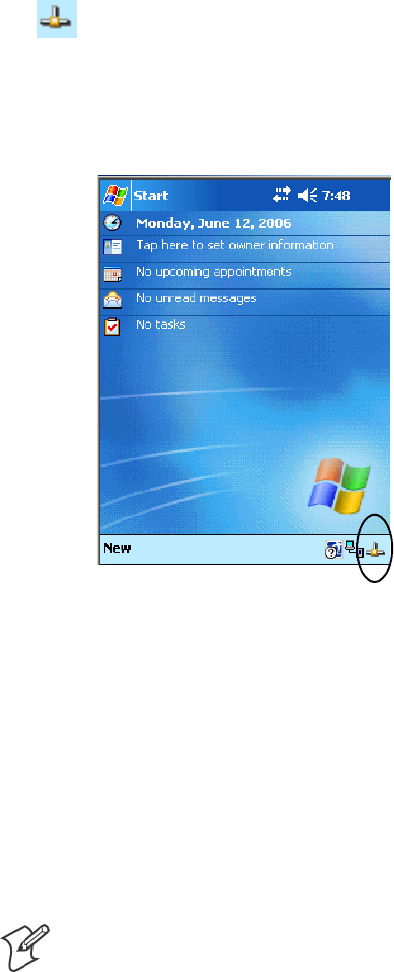
Programming—Chapter 7
209700 Series Color Mobile Computer User’s Manual
For examples on how to use events, consult the Microsoft Developer Net-
work Library at www.msdn.com. The MSDN Library is an essential re-
source for developers using Microsoft tools, products, and technologies. It
contains a bounty of technical programming information, including sam-
ple code, documentation, technical articles, and reference guides.
Autostart FTP
This automatically starts the FTP Server (FTPDCE.EXE) when the 700
Color Computer is powered on. This is provided with the NDISTRAY
program (the Network Driver Interface Specification tray application),
which displays the popup menu that currently allows you to load and un-
load the network drivers. Tap the antenna icon in the System Tray of the
Today screen (a sample antenna icon is circled below) for this pop-up menu.
The default is to start the FTP Server at boot time, unless the following
registry entry is defined and set to “0” which disables AutoFTP. “1” en-
ables the AutoFTP. The entry can be set from the NDISTRAY pop-up
menu by selecting either AutoFTP On or AutoFTP Off.
HKEY_LOCAL_MACHINE\Software\Intermec\Ndistray\StartupIFTP
These new entries are located below the selections to load the network
drivers. If the StartupIFTP registry key is not defined, the FTP Server is
loaded by default, to provide “out-of-the-box” capability for customers
who want to begin loading files to the 700 Color Computer without any
prior configuration.
Note: If a network driver is unloaded using the NDISTRAY popup menu,
and the FTP Server is running, the FTP Server is stopped.
On a resume, if AutoFTP is enabled and the FTP Server is running, it is
stopped and restarted. NDISTRAY uses a helper application named
RESETIFTP to implement the restart on resume feature.
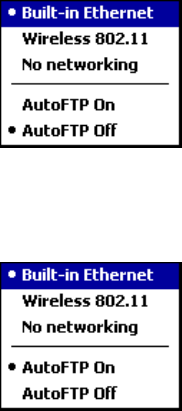
ProgrammingChapter —7
210 700 Series Color Mobile Computer User’s Manual
To do an AutoFTP Installation Check:
1Ensure the FTP Server is running “out-of-the-box” the first time.
2Tap Start >Today to access the Today screen, then tap the antenna
icon in the System Tray to bring up the NDISTRAY pop-up menu.
Select AutoFTP Off to disable AutoFTP. Do a warm boot and confirm
the FTP Server is not running.
3Tap Start >Today to access the Today screen, then tap the antenna
icon in the System Tray to bring up the NDISTRAY pop-up menu.
Select AutoFTP On to enable AutoFTP, reboot, confirm it is running.
4Unload the network driver when the FTP Server is running and con-
firm that it is not running any more.
5Load the FTP Server, establish a connection, then suspend and resume.
The server should still run, but the FTP connection to the client should
be dropped.
Kernel I/O Controls
This describes the KernelIoControl() functions available to application
programmers. Most C++ applications will need to prototype the function
as the following to avoid link and compile errors.
extern “C” BOOL KernelIoControl(DWORD dwIoControlCode, LPVOID lpInBuf, DWORD
nInBufSize, LPVOID lpOutBuf, DWORD nOutBufSize, LPDWORD lpBytesReturned);
You can also see the Device Resource Kit in the Intermec Developer Li-
brary (IDL) for information about these functions. The IDL is available as
a download from the Intermec web site at www.intermec.com/idl. Contact
your Intermec representative for more information.
IOCTL_HAL_GET_DEVICE_INFO
This IOCTL returns either the platform type or the OEMPLATFORM
namebasedonaninputvalue.
Syntax
BOOL KernelIoControl( IOCTL_HAL_GET_DEVICE_INFO, LPVOID lpInBuf, DWORD
nInBufSize, LPVOID lpOutBuf, DWORD nOutBufSize, LPDWORD lpBytesReturned );

Programming—Chapter 7
211700 Series Color Mobile Computer User’s Manual
Parameters
lpInBuf Points to a DWORD containing either the
SPI_GETPLATFORMTYPE or SPI_GETOEMINFO value.
lpInBufSize Must be set to sizeof(DWORD).
lpOutBuf Must point to a buffer large enough to hold the return data of the
function. If SPI_GETPLATFORMTYPE is specified in lpInBuf,
then the “PocketPC\0” Unicode string is returned. If SPI_GE-
TOEMINFO is specified in lpInBuf, then the “Intermec 700\0”
Unicode string is returned.
nOutBufSize ThesizeoflpOutBuf in bytes. Must be large enough to hold the
string returned.
lpBytesReturned The actual number of bytes returned by the function for the data
requested.
Return Values
Returns TRUE if function succeeds. Returns FALSE if the function fails.
GetLastError() may be used to get the extended error value.
IOCTL_HAL_ITC_READ_PARM
Usage
#include “oemioctl.h”
Syntax
BOOL KernelIoControl( IOCTL_HAL_ITC_READ_PARM,LPVOID lpInBuf,DWORD
nInBufSize,LPVOID lpOutBuf,DWORD nOutBufSize,LPDWORD lpBytesReturned );
Parameters
lpInBuf Points to this structure. See “ID Field Values”below.
struct PARMS {
BYTE id;
BYTE ClassId;
};
nInBufSize Must be set to the size of the PARMS structure.
lpOutBuf Must point to a buffer large enough to hold the return data of the
function. If this field is set to NULL and nOutBufSize is set to zero
when the function is called the function will return the number
bytes required by the buffer.
nOutBufSize ThesizeoflpOutBuf in bytes.
lpBytesReturned Number of bytes returned by the function for the data requested.
Return Values
Returns TRUE if function succeeds. Returns FALSE if the function fails.
GetLastError() may be used to get the error value. Either
ERROR_INVALID_PARAMETER or
ERROR_INSUFFICIENT_BUFFER may be returned when this function
is used to get the error.

ProgrammingChapter —7
212 700 Series Color Mobile Computer User’s Manual
ID Field Values
The id field of the PARMS structure may be one of the following values:
ID Field Values
ITC_NVPARM_ETHERNET_ID
Returns Ethernet 802.11b or 802.11b/g MAC Address. Six bytes returned in buffer pointed to by lpOutBuffer
ITC_NVPARM_SERIAL_NUM
Returns serial number of device in BCD format. Six bytes returned in buffer pointed to by lpOutBuffer
ITC_NVPARM_MANF_DATE
Returns device manufacture date in BCD YYYY/MM/DD format. 4 bytes sent in buffer pointed to by lpOutBuffer
ITC_NVPARM_SERVICE_DATE
Returns last device service date in BCD YYYY/MM/DD format. Four bytes sent in buffer pointed to by lpOutBuffer
ITC_NVPARM_DISPLAY_TYPE
Returns device display type. One byte returned in buffer pointed to by lpOutBuffer
ITC_NVPARM_EDG_IP
Returns device Ethernet debug IP address. Four bytes returned in buffer pointed to by lpOutBuffer
ITC_NVPARM_EDBG_SUBNET
Returns device Ethernet debug subnet mask. Four bytes returned in buffer pointed to by lpOutBuffer
ITC_NVPARM_ECN
Returns ECNs applied to device in bit array format. Four bytes returned in buffer pointed to by lpOutBuffer
ITC_NVPARM_CONTRAST
Returns device default contrast setting. Two bytes returned in buffer pointed to by lpOutBuffer
ITC_NVPARM_MCODE
Returns manufacturing configuration code for device. Sixteen bytes returned in buffer pointed to by lpOutBuffer
ITC_NVPARM_VERSION_NUMBER
Returns firmware version for various system components. These values for ClassId field of PARMS structure are
allowed when ITC_NVPARM_VERSION_NUMBER used in id field:
SVN_CLASS_KBD Returns five-byte string, including null terminator, with ASCII value representing keypad
microprocessor version in system. String format is x.xx with terminating null character.
SVN_CLASS_ASIC Returns five-byte string, including null terminator, with ASCII value representing version of
FPGA firmware in system. String format is x.xx with terminating null character.
SVN_CLASS_BOOTSTRAP Returns five-byte string, including null terminator, with ASCII value representing
version of Bootstrap Loader firmware in system. String format is x.xx with terminating null character.
ITC_NVPARM_INTERMEC_SOFTWARE_CONTENT
Reads manufacturing flag bits from non-volatile data store dictating certain software parameters. BOOLEAN
DWORD returned in buffer pointed to by lpOutBuffer indicating whether Intermec Content enabled in XIP
regions. TRUE indicates enabled. FALSE is not enabled.
ITC_NVPARM_ANTENNA_DIVERSITY
Reads state of antenna diversity flag. BOOLEAN DWORD returned in buffer pointed to by lpOutBuffer indicating
whether diversity antenna is installed. TRUE indicates installed. FALSE is not installed.
ITC_NVPARM_WAN_RI
Reads state of WAN ring indicator flag. BOOLEAN DWORD returned in buffer pointed to by lpOutBuffer
indicating polarity of WAN RI signal. TRUE indicates active high. FALSE is active low.
ITC_NVPARM_RTC_RESTORE
Reads state of real-time clock restore flag. BOOLEAN DWORD returned in buffer pointed to by lpOutBuffer.
TRUE indicates RTC is restored on cold-boot. FALSE is RTC is not restored.
ITC_NVPARM_INTERMEC_DATACOLLECTION_SW
Reads state of data collection software enabled flag. BOOLEAN DWORD returned in buffer pointed to by
lpOutBuffer indicating data collection software installs at boot time. FALSE is do not install data collection software

Programming—Chapter 7
213700 Series Color Mobile Computer User’s Manual
ID Field Values (continued)
ITC_NVPARM_INTERMEC_DATACOLLECTION_HW
Reads data collection hardware flags. BYTE returned in buffer pointer to by lpOutBuffer indicating type of data
collection hardware installed. Maximum value returned is ITC_DEVID_SCANHW_MAX:
SITC_DEVID_SCANHW_NONE No scanner hardware installed.
SITC_DEVID_OEM2D_IMAGER OEM 2D imager installed.
SITC_DEVID_INTERMEC2D_IMAGER Intermec 2D imager installed.
SITC_DEVID_SE900_LASER SE900 laser installed.
SITC_DEVID_SE900HS_LASER SE900HS laser installed.
SITC_DEVID_INTERMEC_EVIO EVIO linear imager installed.
High bit non-zero value indicates S6 scanning engine is installed. Bit mask is ITC_DEVID_S6ENGINE_MASK.
ITC_NVPARM_WAN_INSTALLED
Reads state of WAN radio installed flag. BOOLEAN DWORD is returned in buffer: TRUE = WAN radio installed.
ITC_NVPARM_WAN_FREQUENCY
Reads state of WAN radio frequency flag. BOOLEAN DWORD is returned in buffer: TRUE indicates WAN radio
frequency is United States. FALSE is a European WAN radio frequency.
ITC_NVPARM_WAN_RADIOTYPE
Reads WAN radio ID installed by manufacturing. BYTE returned in buffer pointer to by lpOutBuffer indicating type
of WAN radio hardware installed. Maximum value returned is ITC_DEVID_WANRADIO_MAX:
SITC_DEVID_WANRADIO_NONE No WAN radio installed
SITC_DEVID_WANRADIO_SIERRA_SB555 CDMA Sierra Wireless radio
SITC_DEVID_WANRADIO_XIRCOM_GEM3503 GSM/GPRS Intel (Xircom) radio
SITC_DEVID_WANRADIO_SIEMENS_MC45 GSM/GPRS Siemens radio
SITC_DEVID_WANRADIO_SIEMENS_MC46 GSM/GPRS Siemens radio
ITC_NVPARM_80211_INSTALLED
Reads state of 802.11b or b/g radio installed flag. BOOLEAN DWORD returned in buffer: TRUE = radio installed.
ITC_NVPARM_80211_RADIOTYPE
Reads 802.11b or b/g radio ID installed by manufacturing. BYTE returned in buffer pointer to by lpOutBuffer
indicates type of radio hardware installed. ITC_DEVID_80211RADIO_MAX is maximum value returned:
SITC_DEVID_80211RADIO_NONE No 802.11b or 802.11b/g radio installed.
SITC_DEVID_80211RADIO_INTEL_2011B Intel 2011B radio installed.
ITC_NVPARM_BLUETOOTH_INSTALLED
Reads state of Bluetooth radio installed flag. BOOLEAN DWORD returned in buffer pointed to by lpOutBuffer.
TRUE indicates Bluetooth radio installed. FALSE is no Bluetooth radio installed.
ITC_NVPARM_SERIAL2_INSTALLED
Reads state of serial 2 (COM2) device installed flag. BOOLEAN DWORD returned in buffer pointed to by
lpOutBuffer. TRUE indicates serial 2 device is installed. FALSE is no serial 2 device is installed.
ITC_NVPARM_VIBRATE_INSTALLED
Reads state of vibrate device installed flag. BOOLEAN DWORD is returned in buffer pointed to by lpOutBuffer.
TRUE indicates vibrate device is installed. FALSE is no vibrate device is installed.
ITC_NVPARM_LAN9000_INSTALLED
Reads state of Ethernet device installed flag. BOOLEAN DWORD is returned in buffer pointed to by lpOutBuffer.
TRUE indicates Ethernet device is installed. FALSE is no Ethernet device is installed.
ITC_NVPARM_SIM_PROTECT_HW_INSTALLED
Reads state of SIM card protection hardware installed flag. BOOLEAN DWORD returned in buffer pointed to by
lpOutBuffer. TRUE indicates SIM card protection hardware installed. FALSE is no such hardware installed.
ITC_NVPARM_SIM_PROTECT_SW_INSTALLED
Reads state of SIM card protection software installed flag. BOOLEAN DWORD returned in buffer pointed to by
lpOutBuffer. TRUE indicates SIM card protection software is installed. FALSE is no such software installed.

ProgrammingChapter —7
214 700 Series Color Mobile Computer User’s Manual
IOCTL_HAL_ITC_WRITE_SYSPARM
Describes and enables the registry save location.
Usage
#include “oemioctl.h”
Syntax
BOOL KernelIoControl( IOCTL_HAL_ITC_WRITE_SYSPARM,LPVOID lpInBuf,DWORD
nInBufSize, LPVOID lpOutBuf, DWORD nOutBufSize, LPDWORD lpBytesReturned );
Parameters
lpInBuf Asinglebytethatmaybeoneoftheid values. See “ID Field Values”
on the next page.
nInBufSize Must be set to the size of the lpInBuf in bytes.
lpOutBuf Must point to a buffer large enough to hold the data to be written
to the non-volatile data store.
nOutBufSize ThesizeoflpOutBuf in bytes.
lpBytesReturned The number of bytes returned by the function.
Return Values
Returns TRUE if function succeeds. Returns FALSE if the function fails.
GetLastError() may be used to get the error value. Either
ERROR_INVALID_PARAMETER or
ERROR_INSUFFICIENT_BUFFER may be returned when this function
is used to get the error.
ID Field Values
The id field of lpInBuf may be one of the following values:
ID Field Values
ITC_REGISTRY_SAVE_ENABLE
Enables or disables the save registry to non-volatile media feature of the RegFlushKey() function. lpOutBuf must be
set to zero (FALSE) if the feature is to be disabled or one (TRUE) if the feature is to be enabled.
ITC_ DOCK_SWITCH
This IOCTL sets a position of the dock switch. The dock switch may be set to either “modem” or “serial” positions.
lpOutBuf must point to a buffer that contains a byte value of either DOCK_MODEM or DOCK_SERIAL as
defined in OEMIOCTL.H; the value specifies the position the switch is to be set. The call appears as follows:
// port = DOCK_MODEM or DOCK_SERIAL as defined in oemioctl.h
BOOL SetDockSwitch( BYTE port)
{
DWORD cmd = ITC_DOCK_SWITCH;
DWORD cbRet;
return KernelIoControl(IOCTL_HAL_ITC_WRITE_SYSPARM,&cmd, sizeof(cmd),
&port,sizeof(port),&cbRet)
}

Programming—Chapter 7
215700 Series Color Mobile Computer User’s Manual
ID Field Values (continued)
ITC_ WAKEUP_MASK
This IOCTL sets a bit mask that represents the mask for the five programmable wakeup keys. The I/O key is not a
programmable wakeup key. By default it is always the system resume key and all other keys are set to disable key
wakeup. A zero in a bit position masks the wakeup for that key. A one in a bit position enables wakeup for that key.
lpOutBuf must point to a buffer that contains a byte value of a wakeup mask consisting of the OR’ed constants as
definedinOEMIOCTL.H.Onlythefollowingkeysareprogrammableaswakeupevents.
#define SCANNER_TRIGGER 1
#define SCANNER_LEFT 2
#define SCANNER_RIGHT 4
#define GOLD_A1 8
#define GOLD_A2 0x10
ITC_AMBIENT_KEYBOARD (does not apply to the 730 Computer)
This IOCTL sets the threshold for the keypad ambient sensor. This can be a value from 0 (always off) to 255 (always
on). lpOutBuf must point to a buffer that contains a byte value of the desired setting.
ITC_AMBIENT_FRONTLIGHT (does not apply to the 730 Computer)
This IOCTL sets the threshold for the frontlight ambient sensor. This can be a value from 0 (always off) to 255.
lpOutBuf must point to a buffer that contains a byte value of the desired setting.
IOCTL_HAL_GET_DEVICEID
This returns the device ID. There are two types of device IDs supported,
which are differentiated based on the size of the output buffer. The UUID
is returned if the buffer size is set to sizeof(UNIQUE_DEVICEID),other-
wisetheoldstyledeviceIDisreturned.
Usage
#include “pkfuncs.h”
#include “deviceid.h”
Syntax
BOOL KernelIoControl( IOCTL_HAL_GET_DEVICEID,LPVOID lpInBuf,DWORD
nInBufSize,LPVOID lpOutBuf,DWORD nOutBufSize,LPDWORD lpBytesReturned );
Parameters
lpInBuf Should be set to NULL. STRICT_ID settings are not supported.
lpInBufSize Should be set to zero.
lpOutBuf Must point to a UNIQUE_DEVICEID structure as defined by
DEVICEID.H if the UUID is to be returned
nOutBufSize The size of the UNIQUE_DEVICEID in bytes if the UUID is to
be returned. A DEVICE_ID as defined by PKFUNCS.H is re-
turned if the size in bytes is greater than or equal to sizeof(DE-
VICE_ID).
lpBytesReturned The number of bytes returned by the function.
Return Values
Returns TRUE if function succeeds. Returns FALSE if the function fails.
GetLastError() may be used to get the extended error value.

ProgrammingChapter —7
216 700 Series Color Mobile Computer User’s Manual
IOCTL_HAL_GET_OAL_VERINFO
Returns the HAL version information of the Pocket PC image.
Usage
#include “oemioctl.h”
Syntax
BOOL KernelIoControl( IOCTL_HAL_GET_OAL_VERINFO,LPVOID lpInBuf,DWORD
nInBufSize,LPVOID lpOutBuf,DWORD nOutBufSize,LPDWORD lpBytesReturned );
Parameters
lpInBuf Should be set to NULL.
lpInBufSize Should be set to zero.
lpOutBuf Must point to a VERSIONINFO structure as defined by
OEMIOCTL.H. The fields should have these values:
Scboemverinfo sizeof (tagOemVerInfo);
Sverinfover 1
Ssig; “ITC\0”
Sid; ‘N’
Stgtcustomer “”
Stgtplat SeaRay
Stgtplatversion Current build version number
Stgtcputype[8]; “Intel\0”
Stgtcpu “PXA255\0”;
Stgtcoreversion “”
Sdate Build time
Stime Build date
nOutBufSize ThesizeofVERSIONINFOinbytes.
lpBytesReturned Returns sizeof(PVERSIONINFO).
Return Values
Returns TRUE if function succeeds. Returns FALSE if the function fails.
GetLastError() may be used to get the extended error value.
IOCTL_HAL_GET_BOOTLOADER_VERINFO
Returns the HAL version information of the Pocket PC image.
Usage
#include “oemioctl.h”
Syntax
BOOL KernelIoControl( IOCTL_HAL_GET_OAL_VERINFO,LPVOID lpInBuf, DWORD
nInBufSize,LPVOID lpOutBuf,DWORD nOutBufSize,LPDWORD lpBytesReturned );
Parameters
lpInBuf Should be set to NULL.
nInBufSize Should be set to zero.

Programming—Chapter 7
217700 Series Color Mobile Computer User’s Manual
lpOutBuf Must point to a VERSIONINFO structure as defined by
OEMIOCTL.H. The fields should have these values:
Scboemverinfo Sizeof (tagOemVerInfo);
Sverinfover 1
Ssig; “ITC\0”
Sid; ‘B’
Stgtcustomer “”
Stgtplat SeaRay
Stgtplatversion Current build version number of the
bootstrap loader
Stgtcputype[8]; “Intel\0”;
Stgtcpu “PXA255\0”
Stgtcoreversion “”
Sdate Build time
Stime Build date
nOutBufSize ThesizeofVERSIONINFOinbytes.
lpBytesReturned The number of bytes returned to lpOutBuf.
Return Values
Returns TRUE if function succeeds. Returns FALSE if the function fails.
GetLastError() may be used to get the extended error value.
IOCTL_HAL_WARMBOOT
Causes the system to perform a warm-boot. The object store is retained.
Usage
#include “oemioctl.h”
Syntax
BOOL KernelIoControl( IOCTL_HAL_WARMBOOT,LPVOID lpInBuf,DWORD
nInBufSize,LPVOID lpOutBuf,DWORD nOutBufSize,LPDWORD lpBytesReturned );
Parameters
lpInBuf Should be set to NULL.
lpInBufSize Should be set to zero.
lpOutBuf Should be NULL.
nOutBufSize Should be zero.
Return Values
None.
IOCTL_HAL_COLDBOOT
Causes the system to perform a cold-boot. The object store is cleared.
Usage
#include “oemioctl.h”
Syntax
BOOL KernelIoControl( IOCTL_HAL_COLDBOOT,LPVOID lpInBuf,DWORD
nInBufSize,LPVOID lpOutBuf,DWORD nOutBufSize,LPDWORD lpBytesReturned );

ProgrammingChapter —7
218 700 Series Color Mobile Computer User’s Manual
Parameters
lpInBuf Should be set to NULL.
lpInBufSize Should be set to zero.
lpOutBuf Should be NULL.
nOutBufSize Should be zero.
Return Values
None.
IOCTL_HAL_GET_RESET_INFO
This code allows software to check the type of the most recent reset.
Usage
#include “oemioctl.h”
Syntax
BOOL KernelIoControl( IOCTL_HAL_GET_RESET_INFO,LPVOID lpInBuf,DWORD
nInBufSize,LPVOID lpOutBuf,DWORD nOutBufSize,LPDWORD lpBytesReturned );
Parameters
lpInBuf Should be set to NULL.
lpInBufSize Should be set to zero.
lpOutBuf Must point to a HAL_RESET_INFO structure. See sample below.
nOutBufSize The size of HAL_RESET_INFO in bytes.
lpBytesReturned The number of bytes returned by the function.
Return Values
Returns TRUE if function succeeds. Returns FALSE if the function fails.
GetLastError() may be used to get the extended error value.
Sample
typedef struct {
DWORD ResetReason; // most recent reset type
DWORD ObjectStoreState; // state of object store
} HAL_RESET_INFO, * PHAL_RESET_INFO;
// Reset reason types
#define HAL_RESET_TYPE_UNKNOWN 0
#define HAL_RESET_REASON_HARDWARE 1 // cold
#define HAL_RESET_REASON_SOFTWARE 2 // suspend
#define HAL_RESET_REASON_WATCHDOG 4
#define HAL_RESET_BATT_FAULT 8 // power fail
#define HAL_RESET_VDD_FAULT 16 // warm boot
// Object store state flags
#define HAL_OBJECT_STORE_STATE_UNKNOWN 0
#define HAL_OBJECT_STORE_STATE_CLEAR 1

Programming—Chapter 7
219700 Series Color Mobile Computer User’s Manual
IOCTL_HAL_GET_BOOT_DEVICE
This IOCTL code allows software to check which device CE booted from.
Usage
#include “oemioctl.h”
Syntax
BOOL KernelIoControl( IOCTL_HAL_GET_BOOT_DEVICE,LPVOID lpInBuf,DWORD
nInBufSize,LPVOID lpOutBuf,DWORD nOutBufSize,LPDWORD lpBytesReturned );
Parameters
lpInBuf Should be set to NULL.
lpInBufSize Should be set to zero.
lpOutBuf Must point to a buffer large enough to hold a DWORD (4 bytes)
with the boot device. The following boot devices are supported:
#define HAL_BOOT_DEVICE_UNKNOWN 0
#define HAL_BOOT_DEVICE_ROM_XIP 1
#define HAL_BOOT_DEVICE_ROM 2
#define HAL_BOOT_DEVICE_PCMCIA_ATA 3
#define HAL_BOOT_DEVICE_PCMCIA_LINEAR 4
#define HAL_BOOT_DEVICE_IDE_ATA 5
#define HAL_BOOT_DEVICE_IDE_ATAPI 6
nOutBufSize ThesizeoflpOutBuf in bytes (4).
lpBytesReturned The number of bytes returned by the function.
Return Values
Returns TRUE if function succeeds. Returns FALSE if the function fails.
GetLastError() may be used to get the extended error value.
IOCTL_HAL_REBOOT
Note: Using this is no longer recommended, use IOCTL_HAL_WARM-
BOOT (page 217) or IOCTL_HAL_COLDBOOT (page 217). This is
supported for backward-compatibility but its use can lead to difficulties.
Causes the system to perform a warm-boot. The object store is retained.
Usage
#include “oemioctl.h”
Syntax
BOOL KernelIoControl( IOCTL_HAL_REBOOT,LPVOID lpInBuf,DWORD nInBufSize,LPVOID
lpOutBuf,DWORD nOutBufSize,LPDWORD lpBytesReturned );
Parameters
lpInBuf Should be set to NULL. lpOutBuf Should be NULL.
lpInBufSize Should be set to zero. nOutBufSize Should be zero.
Return Values
None.

ProgrammingChapter —7
220 700 Series Color Mobile Computer User’s Manual
IOCTL_PROCESSOR_INFORMATION
Returns processor information.
Usage
#include “pkfuncs.h”
Syntax
BOOL KernelIoControl( IOCTL_PROCESSOR_INFORMATION,LPVOID lpInBuf,DWORD
nInBufSize,LPVOID lpOutBuf,DWORD nOutBufSize,LPDWORD lpBytesReturned );
Parameters
lpInBuf Should be set to NULL.
nInBufSize Should be set to zero.
lpOutBuf Should be a pointer to the PROCESSOR_INFO structure. Its
structure stores information describing the CPU more descriptively.
typedef __PROCESSOR_INFO {
WORD wVersion; // Set to value 1
WCHAR szProcessorCore[40]; // “ARM\0”
WORD wCoreRevision; // 4
WCHAR szProcessorName[40]; // “PXA255\0”
WORD wProcessorRevision; // 0
WCHAR szCatalogNumber[100]; // 0
WCHAR szVendor[100]; // “Intel Corporation\0”
DWORD dwInstructionSet; // 0
DWORD dwClockSpeed; // 400
}
nOutBufSize Should be set to sizeof(PROCESSOR_INFO) in bytes.
lpBytesReturned Returns sizeof(PROCESSOR_INFO);
Return Values
Returns TRUE if function succeeds. Returns FALSE if the function fails.
GetLastError() may be used to get the extended error value.
IOCTL_GET_CPU_ID
Returns Xscale processor ID.
Usage
#include “oemioctl.h”
Syntax
BOOL KernelIoControl( IOCTL_GET_CPU_ID,LPVOID lpInBuf, DWORD nInBufSize,LPVOID
lpOutBuf,DWORD nOutBufSize,LPDWORD lpBytesReturned );
Parameters
lpInBuf ShouldpointtoaCPUIdInfostructuredefinedinOEMIOCTL.H.
lpInBufSize Should be sizeof(CPUIdInfo).

Programming—Chapter 7
221700 Series Color Mobile Computer User’s Manual
lpOutBuf Should be NULL.
nOutBufSize Should be set to 0.
lpBytesReturned Returns sizeof(PROCESSOR_INFO);
Return Values
Returns TRUE if function succeeds. Returns FALSE if the function fails.
GetLastError() may be used to get the extended error value.
Network Selection APIs
Network Selection APIs change the network adapter configuration pro-
grammatically. See the Communications Resource Kit in the IDL for in-
formation about these APIs. The IDL is available as a download from the
Intermec web site at www.intermec.com/idl. Contact your Intermec repre-
sentative for more information.
Notifications
Use the following information to programmatically control the vibrator, to
write an application to turn on the vibrator when a message is received via
the WLAN radio link, and turn it off when the user hits a key.
Vibrator support is in the NLED driver as a false LED. The vibrator is
LED 5 and identified with an CycleAdjust of –1. The vibrate option is
available in the notifications panel when the vibrator is in the system.
Regarding an applications interface to NLED.DLL, LEDs must be avail-
able for applications to use through the COREDLL.DLL file. To use the
LED functions, declare these as extern ”C” as follows:
extern ”C” BOOL WINAPI NLEDGetDeviceInfo(UINT nInfoId, void *pOutput);
extern ”C” BOOL WINAPI NLEDSetDevice( UINT nDeviceId, void *pInput);
The LEDs are enumerated for access through the data structures associated
with these APIs:
SNotification LED 0
SRadio On LED 1 (does not apply to the 730 Computer)
SAlpha Lock LED 2
SScanner LED 3
SLow Battery 4
SVibrator 5 (does not apply to the 730 Computer)
NLEDGetDeviceInfo
Usage
#include “nled.h”
Syntax
BOOL NLEDGetDeviceInfo ( UINT nInfoId, void *pOutput );

ProgrammingChapter —7
222 700 Series Color Mobile Computer User’s Manual
Parameters
nInfoId Integer specifying the information to return. These values are defined:
NLED_COUNT_INFO pOutput buffer specifies the number of LEDs on the device.
NLED_SUPPORTS_INFO_ID pOutput buffer specifies information about the capabilities
supported by the LED.
NLED_SETTINGS_INFO_ID pOutput buffer has information about LED current settings.
pOutput Pointer to the buffer to which the information is returned. The buffer points to various structure
types defined in “nled.h”, depending on the value of nId, as detailed in the following table:
Value of nID Structure in pOutput
LED_COUNT_INFO NLED_COUNT_INFO
NLED_SUPPORTS_INFO NLED_SUPPORTS_INFO
NLED_SETTINGS_INFO NLED_SETTINGS_INFO
NLEDSetDevice
Usage
#include “nled.h”
Syntax
BOOL NLEDSetDevice ( UINT nDeviceId, void *pInput );
Parameters
nDeviceId Integer specifying the device identification. The following is defined:
NLED_SETTINGS_INFO_ID Contains information about the desired LED settings.
pInput Pointer to the buffer that contains the NLED_SETTINGS_INFO structure.
Reboot Functions
There are several methods, via Kernel I/O Control functions, that an ap-
plication program can use to force the 700 Color Computer to reboot.
You can also see the Device Resource Kit in the IDL for information
about these functions. The IDL is available as a download from the Inter-
mec web site at www.intermec.com/idl. Contact your Intermec representa-
tive for information.
SIOCTL_HAL_REBOOT
This performs a warm-boot (page 219). See note below.
SIOCTL_HAL_COLDBOOT
Forces a cold reboot. This resets the 700 Color Computer, reloads Win-
dows CE as if a power-up was performed, and discards the contents of
the Windows CE RAM-based object store (page 217).
SIOCTL_HAL_WARMBOOT
Performs a system warm-boot, preserving the object store (page 217).
Note: Using IOCTL_HAL_REBOOT is no longer recommended, use
either IOCTL_HAL_WARMBOOT or IOCTL_HAL_COLDBOOT.
IOCTL_HAL_REBOOT is still supported for backward-compatibility
but its use can lead to difficulties.

Programming—Chapter 7
223700 Series Color Mobile Computer User’s Manual
Remapping the Keypad
Note: Use caution when remapping the keypad. Improper remapping may
render the keypad unusable. Data within the 700 Color Computer could
also be lost, should any problems occur.
Applications have the ability to remap keys on the 700 Color Numeric
Keypad and 700 Color Alphanumeric Keypad. This will allow applications
to enable keys that would otherwise not be available, such as the [F1]
function key. Also, to disable keys that should not be available, such as the
alpha key because no alpha entry is required. Care should be exercised
when attempting to remap the keypad because improper remapping may
cause the keypad to become unusable. This can be corrected by cold boot-
ing the device which loads the default keymap again.
Note that remapping the keys in this way affects the key mapping for the
entire system, not just for the application that does the remapping.
There are three “planes” supported for the 700 Color Numeric Keypad
and Alphanumeric Keypad. Keys that are to be used in more than one shift
plane must be described in each plane.
Unshifted Plane
The unshifted plane contains values from the keypad when not pressed
with other keys, such as the following:
Press the Keys
Numeric Keypad Alphanumeric Keypad To Enter This
1M1
5T5
9Y9
Gold Plane
The gold plane contains values from the keypad when a key is simulta-
neously pressed with the [Gold] bkey on the numeric keypad or the
[Gold/White] ckey on the alphanumeric keypad, such as the following:
Press the Keys
Numeric Keypad Alphanumeric Keypad To Enter This
[Gold] b1[Gold/White] ce Send
[Gold] b5[Gold/White] cC A3
[Gold] b9[Gold/White] cP PgDn

ProgrammingChapter —7
224 700 Series Color Mobile Computer User’s Manual
Alpha (Blue) Plane
The alpha plane contains values from the keypad when the keypad has
been placed in alpha mode by pressing the blue alpha key, such as:
Press the Keys
Numeric Keypad Alphanumeric Keypad To Enter This
[Alpha] F1[Alpha] dg Caps
[Alpha] F5[Alpha] dJ j
[Alpha] F9[Alpha] dW w
Key Values
Key values are stored in the registry. All units ship with a default key
mapping in its registry. Applications to change the default mapping need
to read the appropriate key from the registry into an array of Words,
modify the values required and then write the updated values back into the
registry. The registry access can be done with standard Microsoft API calls,
such as RegOpenKeyEx(), RegQueryValueEx(), and RegSetValueEx().
Numeric Keypad
The following registry keys contain the plane mappings:
SThe unshifted plane mapping can be found in the registry at:
HKEY_LOCAL_MACHINE\HARDWARE\DEVICEMAP\KEYBD\Vkey
SThe gold plane mapping can be found in the registry at:
HKEY_LOCAL_MACHINE\HARDWARE\DEVICEMAP\KEYBD\VkeyGold
SThe alpha plane mapping can be found in the registry at:
HKEY_LOCAL_MACHINE\HARDWARE\DEVICEMAP\KEYBD\VkeyAlpha
Alphanumeric Keypad
The following registry keys contain the plane mappings:
SThe unshifted plane mapping can be found in the registry at:
HKEY_LOCAL_MACHINE\HARDWARE\DEVICEMAP\KEYBD\ALPHA\Vkey
SThe gold plane mapping can be found in the registry at:
HKEY_LOCAL_MACHINE\HARDWARE\DEVICEMAP\KEYBD\ALPHA\VkeyGold
SThe alpha plane mapping can be found in the registry at:
HKEY_LOCAL_MACHINE\HARDWARE\DEVICEMAP\KEYBD\ALPHA\VkeyAlpha
How Key Values Are Stored in Registry
To know which fields to update in the registry, you must know what Scan
Codes are assigned to each physical key (see the “Keypad Scan Codes and
Meanings” table on the next page). The Scan Code is used at the lowest
level of the system to let the keypad driver know which physical key has
been pressed. The keypad driver takes that scan code and looks it up in a
table (a copy of the one stored in the registry) to determine which values
to pass on to the operating system.

Programming—Chapter 7
225700 Series Color Mobile Computer User’s Manual
Each registry key is just an array that describes to the keypad driver what
value needs to be passed for each physical key. The key values are indexed
by the scan code, this is a zero-based index. For example in the unshifted
plane, the [4] key has a scan code of 0x06. This means that the seventh
word under the “Vkey” registry key will have the value for the [4] key.
Taking a sample of the “Vkey” registry key shows the following values:
00,00,0B,05,02,03,C1,07,04,03,BE,00,34,00,00,00,. . .
The value is 34,00. The values are in reverse byte order as that is the way
the processor handles data. When writing an application, nothing needs to
be done to swap the bytes, as this will happen automatically when the data
is read into a byte value. This is something you just need to be aware of
when looking at the registry. Knowing this, we can see that the value that
the keypad driver will pass to the system is a hex 34. Looking that up on
an UNICODE character chart, we see that it maps to a “4”. If you wanted
the key, labeled “4”, to output the letter “A” instead, you would need to
change the seventh word to “41” (the hexadecimal representation of “A”
from the UNICODE chart), then put the key back into the registry.
If you wish to disable a certain key, remap its scan code to 0x00.
Note: Do not remap scan codes 0x01, 0x41, 0x42, 0x43, 0x44. Doing so
could make your 700 Color Computer unusable until you do a cold-boot.
Change Notification
Changing registry keys does not immediately change key mappings. To
notify the keypad driver the registry is updated, use the CreateEvent() API
to signal the “ITC_KEYBOARD_CHANGE” named event.
Advanced Keypad Remapping
It is also possible to map multiple key presses to one button and to map
named system events to a button. The multiple key press option could be
useful to cut down on the number of keys needed to press in a given situa-
tion or to remap which key behaves like the action key. Mapping events to
a button could be useful to change which buttons will fire the scanner,
control volume, and allow for suspending and resuming the device. Con-
tact Intermec Technical Support for more information.
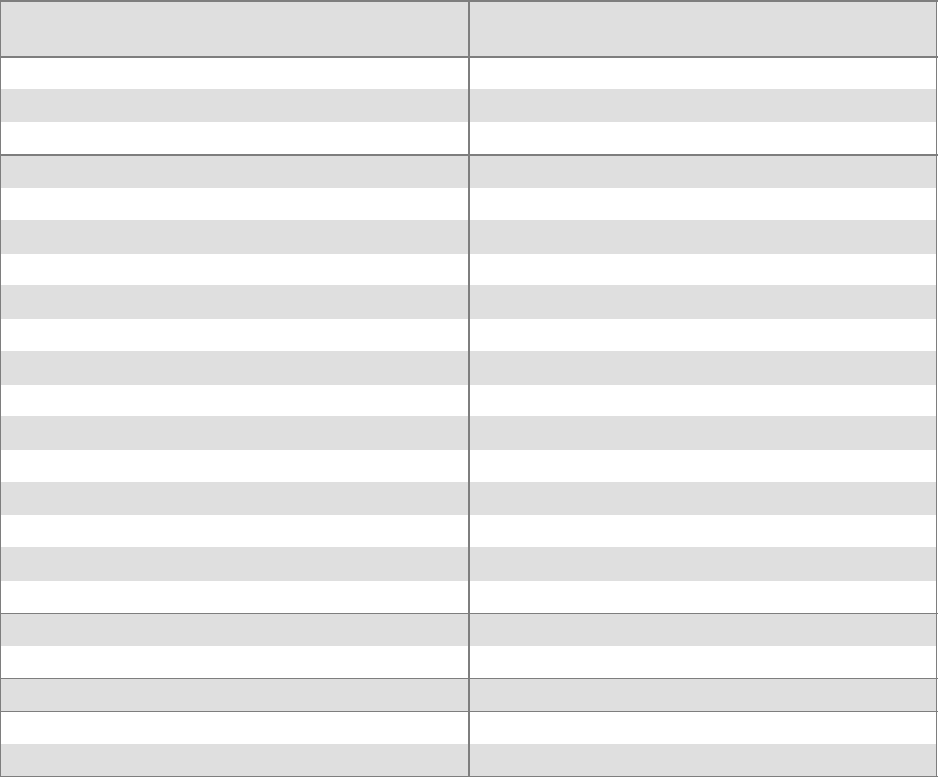
ProgrammingChapter —7
226 700 Series Color Mobile Computer User’s Manual
Scan Codes
At the lowest driver level, the 700 Color Numeric and Alphanumeric Key-
pads identify keys as scan codes. The keypad microcontroller sends the
codes and only the keypad firmware changes the codes.
Numeric Keypad Scan Codes and Meanings
Press
this Key Meaning ScanCode
Press
this Key Meaning ScanCode
Reserved 0x00 Scanner Left 0x03
II/O button 0x01 Scanner Right 0x04
Scanner Handle Trigger 0x02
44/GHI/A2 0x06 RRight arrow/Tab 0x14
None 0x07 2 2/ABC/End 0x15
LLeft arrow/Back Tab 0x08 88/TUV/* (asterisk) 0x16
None 0x09 0 0/Win 0x17
KBkSp// (forward slash) 0x0A 55/JKL/A3 0x18
b[Gold] key 0x0B None 0x19
None 0x0C AAction/+ (plus symbol) 0x1A
EEsc/– (minus sign) 0x0D 3 3/DEF/backlight 0x1B
DDown arrow/Volume decrease 0x0E 99/WXYZ/PgDn 0x1C
11/Caps/Send 0x0F e Enter/@ (at symbol) 0x1D
77/PQRS/PgUp 0x10 66/MNO/A4 0x1E
F[Alpha] key 0x11 None 0x1F-0x40
None 0x12 BCharge Detect 0x41
UUp arrow/Volume increase 0x13
CLCD frontlight 0x42 Threshold crossed 0x42
bAmbient light 0x42
Headset detected 0x43
Keypad Backlight 0x44 Threshold Crossed 0x44
bAmbient Light 0x44

Programming—Chapter 7
227700 Series Color Mobile Computer User’s Manual
Alphanumeric Keypad Scan Codes and Meanings
Press
this Key Meaning ScanCode
Press
this Key Meaning ScanCode
Reserved 0x00 N N/2 0x17
iI/O button 0x01 II/backlight 0x18
Scanner Handle Trigger 0x02 P P/PgDn 0x19
Scanner Left 0x03 QQ/, (comma) 0x1A
Scanner Right 0x04 R R/+ (plus sign) 0x1B
AA/A1 key 0x05 SS/4 0x1C
BB/A2 key 0x06 T T/5 0x1D
eEscape/Send 0x07 OO/3 0x1E
jLeft arrow/Back Tab 0x08 g Caps/Lock 0x1F
kUp arrow/Volume increase 0x09 hBkSp 0x20
mDown arrow/Volume decrease 0x0A V V/. (period) 0x21
lRight arrow/Tab 0x0B WW/7 0x22
aAction/End 0x0C X X/8 0x23
EE/Win 0x0D UU/6 0x24
FF/= (equal sign) 0x0E c Gold/White 0x25
GG/* (asterisk) 0x0F bNumLock 0x26
CC/A3 0x10 Space 0x27
HH// (forward slash) 0x11 ZZ/0 0x28
DD/A4 0x12 f Enter 0x29
JJ/PgUp 0x13 YY/9 0x2A
KK/@ (as symbol) 0x14 None 0x2B–0x40
LL/– (minus sign) 0x15 BCharge Detect 0x41
MM/1 0x16
CLCD frontlight 0x42 Threshold Crossed 0x42
bAmbient light 0x42
Headset detected 0x43
Keypad Backlight 0x44 Threshold Crossed 0x44
bAmbient Light 0x44
ProgrammingChapter —7
228 700 Series Color Mobile Computer User’s Manual
Sample View of Registry Keys
Below is a sample of the current default key mapping for the 700 Color
Numeric Keypad. See your device registry for the latest key mappings.
[HKEY_LOCAL_MACHINE\HARDWARE\DEVICEMAP\KEYBD]
”ResumeMask”=dword:7
”Vkey”=hex: 00,00,0B,05,02,03,C1,07,04,03,BE,00,34,00,00,00,\
25,00,00,00,08,00,03,02,00,00,1B,00,28,00,31,00,\
37,00,01,02,00,00,26,00,27,00,32,00,38,00,30,00,\
35,00,00,00,01,03,33,00,39,00,0D,00,36,00,00,00,\
00,00,00,00,00,00,00,00,00,00,00,00,00,00,00,00,\
00,00,00,00,00,00,00,00,00,00,00,00,00,00,00,00,\
00,00,00,00,00,00,00,00,00,00,00,00,00,00,00,00,\
00,00,00,00,00,00,00,00,00,00,00,00,00,00,00,00,\
00,00,07,05,01,05,03,05,02,05
”VkeyGold”=hex: 00,00,0B,05,02,03,C1,07,04,03,BE,00,34,00,00,00,\
09,01,00,00,BF,00,03,02,00,00,BD,00,75,00,72,00,\
21,00,01,02,00,00,76,00,09,00,73,00,38,01,5B,00,\
35,00,00,00,BB,01,09,05,22,00,32,01,36,00,00,00,\
00,00,00,00,00,00,00,00,00,00,00,00,00,00,00,00,\
00,00,00,00,00,00,00,00,00,00,00,00,00,00,00,00,\
00,00,00,00,00,00,00,00,00,00,00,00,00,00,00,00,\
00,00,00,00,00,00,00,00,00,00,00,00,00,00,00,00,\
00,00,07,05,01,05,03,05,02,05
”VkeyAlpha”=hex: 00,00,0B,05,02,03,C1,07,04,03,BE,00,47,00,00,00,\
25,00,00,00,08,00,03,02,00,00,1B,00,28,00,02,02,\
50,00,01,02,00,00,26,00,27,00,41,00,54,00,20,00,\
4A,00,00,00,01,03,44,00,57,00,0D,00,4D,00,00,00,\
00,00,00,00,00,00,00,00,00,00,00,00,00,00,00,00,\
00,00,00,00,00,00,00,00,00,00,00,00,00,00,00,00,\
00,00,00,00,00,00,00,00,00,00,00,00,00,00,00,00,\
00,00,00,00,00,00,00,00,00,00,00,00,00,00,00,00,\
00,00,07,05,01,05,03,05,02,05

229700 Series Color Mobile Computer User’s Manual
Configurable Settings
A
This appendix contains information about the Intermec Settings, Utilities,
and Wireless Network applets on the 700 Color Mobile Computer.
Note: “700 Color” pertains to 740, 741, 750, 751, 760, and 761 Com-
puters unless otherwise noted.
The contents of the Intermec Settings applet are dependent on what hard-
ware configuration is done for each 700 Color Computer at the time of
shipment. These settings currently only appear if a scanner or an imager
option is present.
Likewise, other applets that are specifically related to the 802.11b or
802.11b/g radio module appear when a 802.11b or 802.11b/g radio mod-
ule is installed in a 700 Color Computer. Applets that are specific for
Bluetooth, CDMA/1xRTT, and GSM/GPRS radio modules only appear
when each respective hardware configuration is done on the 700 Color
Computer. See Chapter 4, “Network Support,” for more information about
the radio modules or Bluetooth.
Information about using reader commands and configuration bar codes to
configure some of your settings is also in this appendix.
Note: Information about the settings you can configure with the Intermec
Settings applet is described in the Intermec Computer Command Reference
Manual (P/N: 073529). The online manual is available from the Intermec
web site at www.intermec.com.
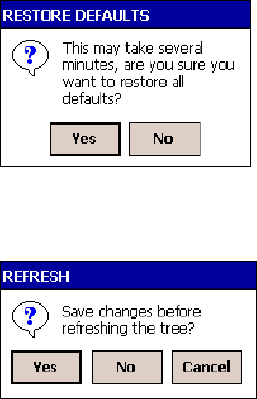
Configurable SettingsAppendix —A
230 700 Series Color Mobile Computer User’s Manual
Configuration Parameters
A configuration parameter changes the way the 700 Color Computer op-
erates, such as configuring a parameter to have the 700 Color Computer
emit a very loud beep in a noisy environment.
To execute configuration parameters, scan EasySet bar codes. You can use
the EasySet bar code creation software from Intermec to print configura-
tion labels. Scan the labels to change the scanner configuration and data
transfer settings.
For more information, see the EasySet online help. EasySet is available
from the Intermec Data Capture web site.
Menus of available parameters for each group are listed. Use the scroll bars
to go through the list. Expand each menu (+) to view its parameter set-
tings. Tap a parameter to select, or expand a parameter (+) to view its sub-
parameters.
Note that each parameter or subparameter is shown with its default setting
or current setting in (< >) brackets. Tap a parameter or subparameter to
select that parameter, then do any of the following to change its setting:
STyping a new value in an entry field.
SChoosing a new value from the drop-down list.
SSelecting a different option. The selected option contains a bullet.
STap Edit >Restore Item Defaults to restore factory-default settings.
Tap Yes when you are prompted to verify this action.
STap View >Refresh to discard changes and start again. Tap Yes to save
changes when you are prompted to verify this action.
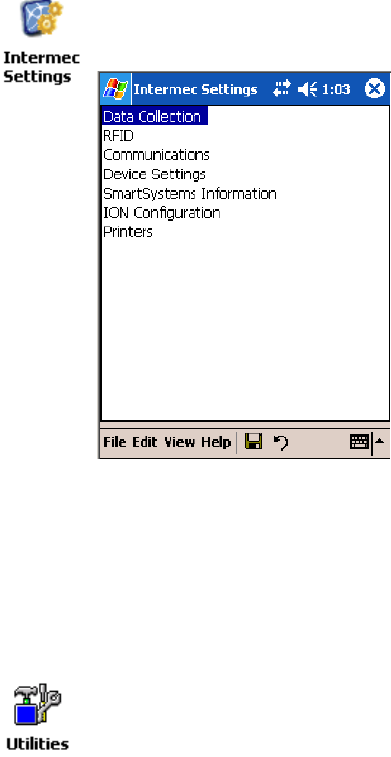
Configurable SettingsAppendix —A
231700 Series Color Mobile Computer User’s Manual
Intermec Settings Applet
Information about the settings you can configure with this applet is
described in the Intermec Computer Command Reference Manual.The
online manual is available from the Intermec web site at
www.intermec.com.
See the Data Collection Resource Kit in the Intermec Developer Library
(IDL) for information about data collection functions. The IDL is avail-
able as a download from the Intermec web site at www.intermec.com/idl.
Contact your Intermec representative for more information.
To access the settings from the 700 Color Computer, tap Start >Settings
>theSystem tab > Intermec Settings to access its applet.
Utilities Applet
The Utilities applet examines and modifies settings and operational modes
of specific hardware and software on the 700 Color Computer: the dock
switch, registry storage, wakeup mask, and application launch keys.
To access the settings from the 700 Color Computer, tap Start >Settings
>theSystem tab > Utilities to access its applet.
Use the left and right arrows to scroll through the tabs along the bottom of
the applet, then tap a tab to access its menus. These tabs represent the fol-
lowing groups of settings or parameters:
SDock Switch (next page)
SRegistry Save (page 232)
SWakeup Mask (page 233)
SApp Launch (page 234)
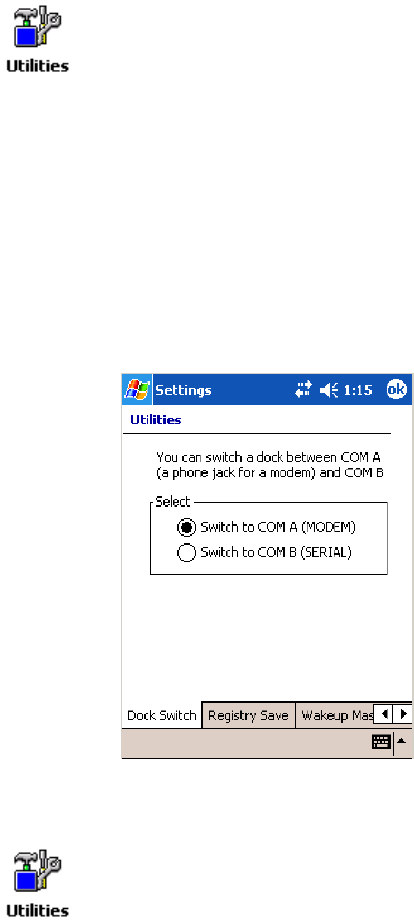
Configurable SettingsAppendix —A
232 700 Series Color Mobile Computer User’s Manual
Dock Switch
From the 700 Color Computer, tap Start >Settings >theSystem tab >
Utilities >theDock Switch tab to access the Dock Switch applet.
Use this applet to control the position of the dock switch. This can be set
either to a COM A (phone jack for a modem) position or to a COM B
(serial) position.
If switched to COM B and suspended, the terminal has the following be-
havior:
SIf the 700 Color Computer is on charge, the dock switch remains
switched to COM B.
SIf the 700 Color Computer is off charge, the dock switch switches to
COM A and remain in this position until the 700 Color Computer re-
sumes charge.
Registry Save
From the 700 Color Computer, tap Start >Settings >theSystem tab >
Utilities >theRegistry Save tab to access the Registry Save applet.
For Windows Mobile 2003, the only medium available for saving the reg-
istry is the Flash File System (PSM). Registry data is stored in the
“\Flash_File_Store\Registry” path. Check Enable Registry Storage to en-
able this function.
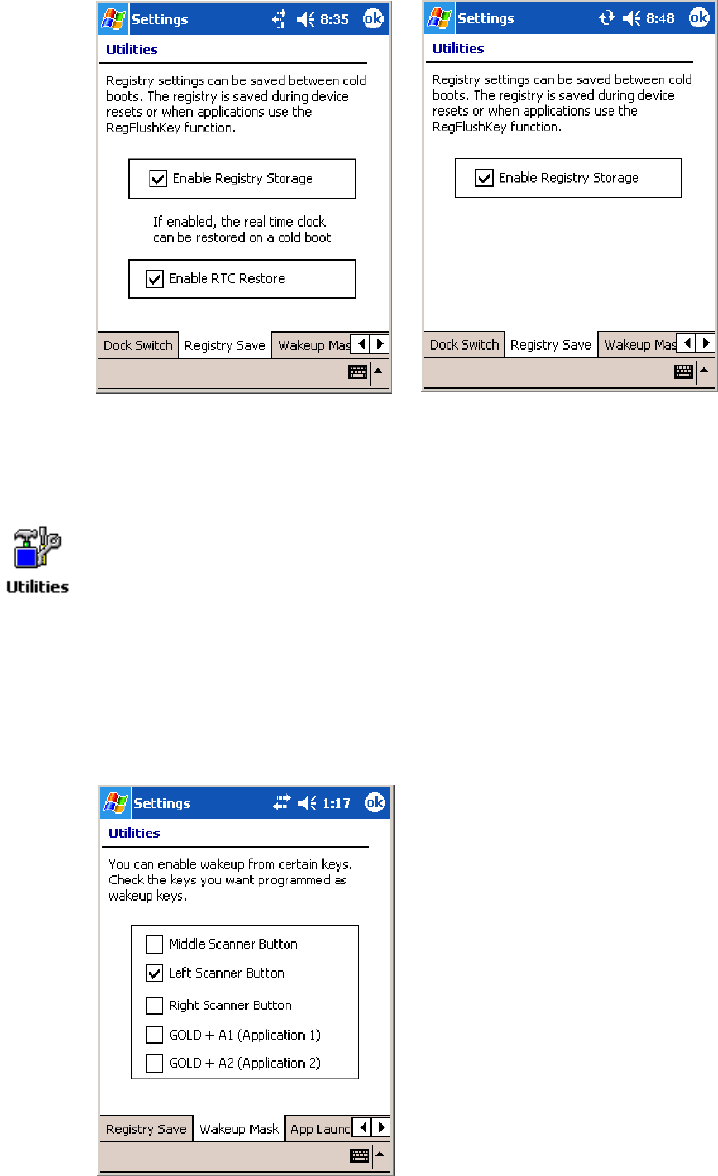
Configurable SettingsAppendix —A
233700 Series Color Mobile Computer User’s Manual
To ensure that the 700 Color Computer restores the real-time clock after a
cold-boot, check the Enable RTC Restore option. Note that this does not
apply to the 730 Computer.
700 Color Screen 730 Screen
Wakeup Mask
From the 700 Color Computer, tap Start >Settings >theSystem tab >
Utilities >theWakeup Mask tab to access the Wakeup Mask applet.
This applet programs three scanner buttons and the A1 and A2 application
keys to be “wakeup” or resume keys. That is, to prompt the 700 Color
Computer to “wake up” or resume activity after going to “sleep” as a result
of being inactive after a length of time. This information will remain be-
tween warm and cold boots.
Check the appropriate box, then tap ok to apply your settings.
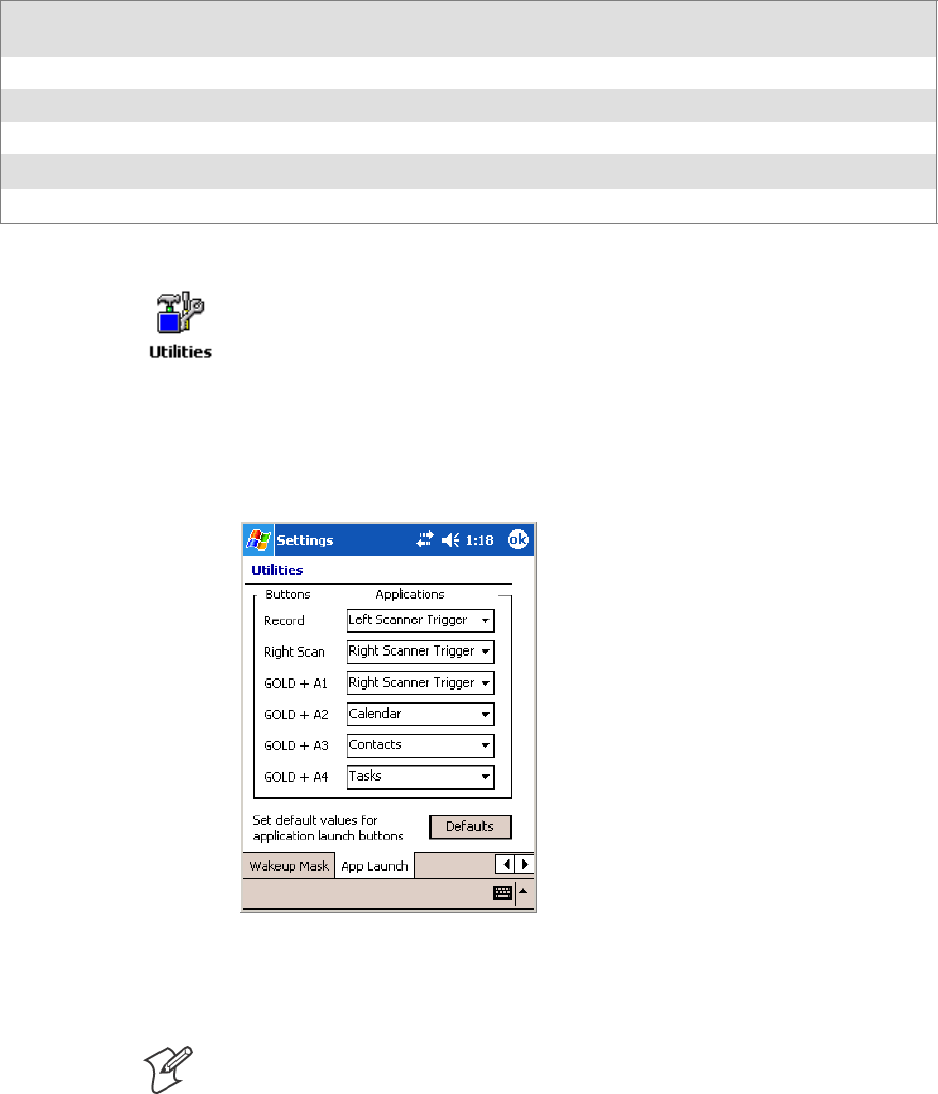
Configurable SettingsAppendix —A
234 700 Series Color Mobile Computer User’s Manual
Based on your setting, do the following to “wake up” the 700 Computer:
If you select:
Then do this on
Numeric Keyboard
Then do this on
Alphanumeric Keyboard
Middle Scanner Button Squeeze the button on the Scan Handle Squeeze the button on the Scan Handle
Left Scanner Button Squeeze the left scanner button Squeeze the left scanner button
Right Scanner Button Squeeze the right scanner button Squeeze the right scanner button
GOLD+A1(Application1) Press [Gold] ba Press [Gold/White] cA
GOLD+A2(Application2) Press [Gold] b4 Press [Gold/White] cB
App Launch
From the 700 Color Computer, tap Start >Settings >theSystem tab >
Utilities , then scroll to the right to tap the App Launch tab to access the
Application Launch applet.
This applet programs or maps two scanner buttons and four application
keys to start up to six applications. Note the left scanner button also acts as
the record button.
For 700 Color Computers with either a laser scanner or an imager,
default mappings are shown in the following illustration.
For 700 Color Computers without either a laser scanner or an imager,
the default maps the Record, Calendar, Contacts, and Tasks applications
the top four and the A3 and A4 buttons are “unassigned” or available for
two more applications.
Note: Record, Calendar, Contacts, and Tasks are Pocket PC applications.
See Chapter 2, “Windows Mobile 2003,” for more information.
STo assign an application to a button, select an application from the ap-
plicable drop-down list box.
STo assign a new application, select the “Add new application” option,
which brings up an Open File dialog and browse Secure Digital or
CompactFlash storage cards for new applications.

Configurable SettingsAppendix —A
235700 Series Color Mobile Computer User’s Manual
STo disable or unmap a currently mapped application from a correspon-
ding button, select “unassigned” from the applicable drop-down list.
STo restore these buttons to their defaults, tap Defaults in the lower
right corner.
Note; You cannot map an application to more than one button. Should
you assign the same application to two buttons, a verification prompt will
appear after the second button to confirm whether you want to remap the
application. If you tap Yes, the applet changes the first button to “unas-
signed” and map the application to the second button.
Note: All changes are activated immediately upon selection.
Wireless Network Applet
Note: See Chapter 4, “Network Support,” for information about the
802.11b or 802.11b/g radio module.
About the Wireless Network
Your wireless adapter (network interface card) connects to wireless net-
works of two types: infrastructure networks and ad-hoc networks.
SInfrastructure networks get you onto your corporate network and the
internet. Your 700 Color Computer establishes a wireless connection to
an access point, which links you to the rest of the network. When you
connect to a network via an access point, you are using the 802.11b or
802.11b/g infrastructure mode.
SAd-hoc networks are private networks shared between two or more cli-
ents, even with no access point.
Each wireless network is assigned a name (or Service Set Identifier —
SSID) to allow multiple networks to coexist in the same area without in-
fringement.
Intermec recommends using security measures with wireless networks to
prevent unauthorized access to your network and to ensure your privacy of
transmitted data. The following are required elements for secure networks:
SAuthentication by both the network and the user
SAuthentication is cryptographically protected
STransmitted data
There are many schemes available for implementing these features.
Terminology
Below and on the next page are terms you may encounter as you configure
your wireless network:
SCKIP (Cisco Key Integrity Protocol)
This is Cisco’s version of the TKIP protocol, compatible with Cisco
Airnet products.

Configurable SettingsAppendix —A
236 700 Series Color Mobile Computer User’s Manual
SEAP (Extensible Authentication Protocol)
802.11b or 802.11b/g uses this protocol to perform authentication.
This is not necessarily an authentication mechanism, but is a common
framework for transporting actual authentication protocols. Intermec
provides a number of EAP protocols to choose for your network.
STKIP (Temporal Key Integrity Protocol)
This protocol is part of the IEEE 802.11i encryption standard for wire-
less LANs., which provides per-packet key mixing, a message integrity
check and a re-keying mechanism, thus overcoming most of the weak
points of WEP. This encryption is more difficult to crack than the stan-
dard WEP. Weak points of WEP include:
SNo Installation Vector (IV) reuse protection
SWeak keys
SNo protection against message replay
SNo detection of message tampering
SNo key updates
SWEP (Wired Equivalent Privacy) encryption
With preconfigured WEP, both the client 700 Color Computer and
access point are assigned the same key, which can encrypt all data be-
tween the two devices. WEP keys also authenticate the 700 Color Com-
puter to the access point — unless the 700 Color Computer can prove
it knows the WEP key, it is not allowed onto the network.
WEP keys are only needed if they are expected by your clients. There
are two types available: 64-bit (5-character strings, 12345) (default) and
128-bit (13-character strings, 1234567890123). Enter these as either
ASCII (12345) or Hex (0x3132333435).
SWPA (Wi-Fi Protected Access)
This is an enhanced version of WEP that does not rely on a static,
shared key. It encompasses a number of security enhancements over
WEP, including improved data encryption via TKIP and 802.11b or
802.11b/g authentication with EAP.
WiFi Alliance security standard is designed to work with existing
802.11 products and to offer forward compatibility with 802.11i.
Configuring Your Wireless Network
To start 802.11b or 802.11b/g communications on the 700 Color
Computer, tap Start >Settings >theSystem tab > Wireless Network to
access the Profile Wizard for the 802.11b or 802.11b/g radio module.
A profile contains all the information necessary to authenticate you to the
network, such as login name, password or certificate, and protocols by
which you are authenticated.
You can have up to four profiles for different networks. For example, you
may have different login names or passwords on different networks, or you
may use a password on one network, and a certificate on another.
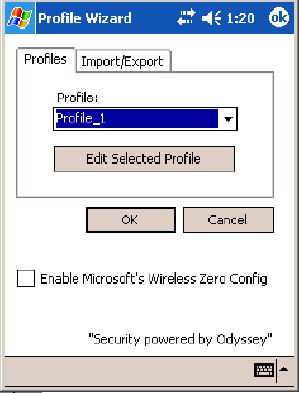
Configurable SettingsAppendix —A
237700 Series Color Mobile Computer User’s Manual
Use the Profiles page to select and configure between the networking envi-
ronments assigned to this 802.11b or 802.11b/g radio.
SProfile:
Tap the drop-down list to choose between four different profiles as-
signed to this unit, then tap Edit Select Profile, make the changes need-
ed for this profile (starting on the next page),thentapOK to return to
the Profiles page.
SEnable Microsoft’s Wireless Zero Config
Check this box to enable Microsoft’s Wireless Zero Config application.
This effectively disables the Intermec software solution for 802.11b or
802.11b/g, including configuration via the Wireless Network applet.
Basic
Use the Basic page to set the network type, name, and manage battery
power for this profile. Tap ok to return to the Profiles page.
SProfile Label:
Enter a unique name for your profile.
SNetwork type:
Tap the drop-down list to select either “Infrastructure” if your network
uses access points to provide connectivity to the corporate network or
internet; or “Ad-Hoc” to set up a private network with one or more par-
ticipants.
SChannel:
If you selected “Ad-Hoc” for the network type, select the channel on
which you are communicating with others in your network. There are
up to 11 channels available.
SSSID (Network Name):
This assumes the profile name unless another name is entered in this field.
If you want to connect to the next available network or are not familiar
with the network name, enter “ANY” in this field. Consult your LAN
administrator for network names.

Configurable SettingsAppendix —A
238 700 Series Color Mobile Computer User’s Manual
SEnable Power Management:
Check this box to conserve battery power (default), or clear this box to
disable this feature.
Security
The following are available from the 8021x Security drop-down list. Note
the last four methods are available if you have purchased the security package.
Contact your Intermec representative for information.
SNone (below) STTLS (page 244)
SPEAP (page 240) SLEAP (page 247)
STLS (page 242) SEAP-FAST (page 249)
None
Use “None” to disable 802.11b or 802.11b/g Security and enable either
WEP or WPA-PSK encryption.
To Disable 802.1x Security
Set 8021x Security and Encryption as “None” and Association to “Open.”

Configurable SettingsAppendix —A
239700 Series Color Mobile Computer User’s Manual
To Enable WEP Encryption
1Set 8021x Security as “None.”
2Set Association to either “Open” if WEP keys are not required; or
“Shared” when WEP keys are required for association.
3Set Encryption to “WEP” (see page 236).
4If you had set Association to “Shared,” then select a data transmission
key from the Data TX Key drop-down list near the bottom of this
screen, then enter the encryption key for that data transmission in the
appropriate Key # field.
To Enable WPA Encryption Using a Preshared Key
1Set 8021x Security as “None.”
2Set Association to “WPA” (see page 236).
3Enter the temporal key as ASCII (12345) in the Pre-Shared Key field.
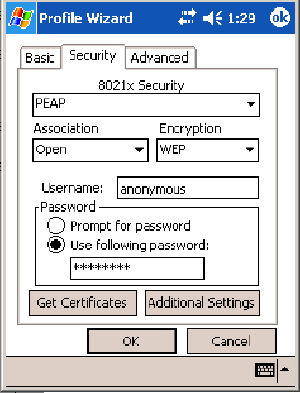
Configurable SettingsAppendix —A
240 700 Series Color Mobile Computer User’s Manual
PEAP (Protected EAP)
This protocol is suitable for performing secure authentication against Win-
dows domains and directory services. It is comparable to EAP-TTLS (see
page 244), both in its method of operation and its security, though not as
flexible. This does not support the range of inside-the-tunnel authentica-
tion methods supported by EAP-TTLS. Microsoft and Cisco both support
this protocol.
Use “PEAP” to configure the use of PEAP as an authentication protocol
and to select “Open,” “WPA,” or “Network EAP” as an association mode.
To Enable PEAP with an Open Association
1Set 8021x Security as “PEAP.”
2Set Association to “Open.”
3Enter your unique user name and password to use this protocol. Select
Prompt for password to have the user enter this password each time to
access the protocol; or leave Use following password as selected to auto-
matically use the protocol without entering a password.
4Tap Get Certificates to obtain or import server certificates (page 247).
5Tap Additional Settings to assign an inner PEAP authentication and set
options for server certificate validation and trust (see page 242).
To Enable PEAP with WPA Encryption
1Set 8021x Security as “PEAP.”
2Set Association to “WPA” (see page 236).
3Enter your unique user name and password to use this protocol. Select
Prompt for password to have the user enter this password each time to
access the protocol, or leave Use following password as selected to auto-
matically use the protocol without entering a password.
4Tap Get Certificates to obtain or import server certificates (page 247).

Configurable SettingsAppendix —A
241700 Series Color Mobile Computer User’s Manual
5Tap Additional Settings to assign an inner PEAP authentication and set
options for server certificate validation and trust (see page 242).
To Enable PEAP with Network EAP
1Set 8021x Security as “PEAP.”
2Set Association to “Network EAP” (see page 236).
3Set Encryption to either “WEP” (page 236) or “CKIP” (page 235).
4Enter your unique user name and password to use this protocol. Select
Prompt for password to have the user enter this password each time to
access the protocol, or leave Use following password as selected to auto-
matically use the protocol without entering a password.
5Tap Get Certificates to obtain or import server certificates (page 247).
6Tap Additional Settings to assign an inner PEAP authentication and set
options for server certificate validation (see page 242).
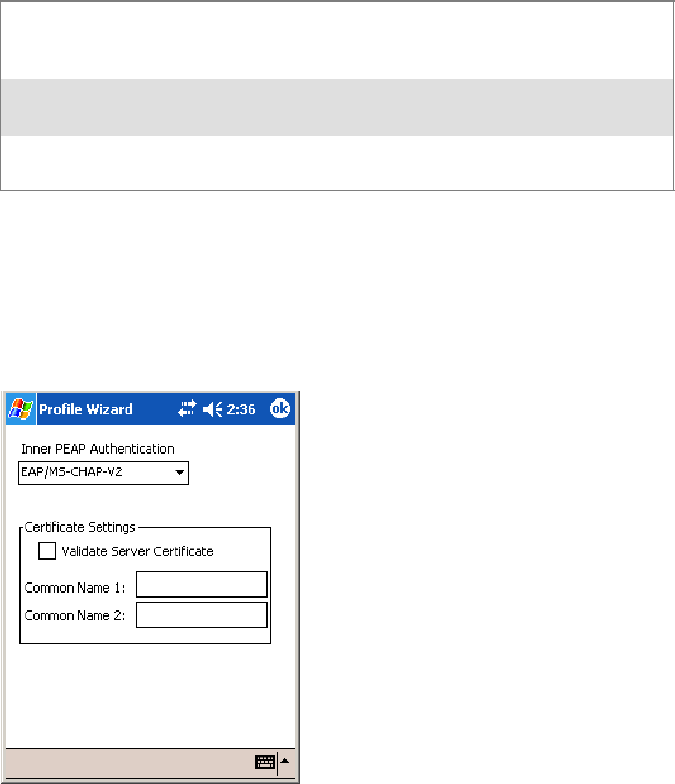
Configurable SettingsAppendix —A
242 700 Series Color Mobile Computer User’s Manual
Additional Settings
1Select an authentication method from the Inner PEAP Authentication
drop-down list.
EAP/MS-CHAP-V2 Authenticates against a Windows Domain Controller and
other non-Windows user databases. This is Microsoft’s
implementation of PEAP.
EAP/Token Card Use with token cards. The password value entered is never
cached. This is Cisco’s implementation of PEAP.
EAP/MD5-Challenge Message Digest 5. A secure hashing authentication algo-
rithm.
2Check Validate Server Certificate to verify the identity of the authenti-
cation server based on its certificate when using TTLS or PEAP.
3Enter the Common Names of trusted servers. Note if these fields are left
blank, the server certificate trust validation is not performed or required.
4Click ok to return to the Security page.
TLS (EAP-TLS)
EAP-TLS is a protocol that is based on the TLS (Transport Layer Security)
protocol widely used to secure web sites. This requires both the user and
authentication server have certificates for mutual authentication. While
cryptically strong, this requires corporations that deploy this to maintain a
certificate infrastructure for all their users.
Use “TLS” to configure the use of EAP-TLS as an authentication protocol,
and select either “Open” or “WPA” as an association mode.
ToEnableTLSwithanOpenAssociation
1Set 8021x Security as “TLS.”
2Set Association to “Open.”
3EnteryouruniqueSubject Name and User Name to use this protocol.

Configurable SettingsAppendix —A
243700 Series Color Mobile Computer User’s Manual
4Tap Get Certificates to obtain or import server certificates (page 247).
5Tap Additional Settings to set server certificate validation (page 244).
To Enable TLS with WPA Encryption
1Set 8021x Security as “TLS.”
2Set Association to “WPA” (see page 236).
3Enter unique Subject Name and User Name credentials for this profile.
4Tap Get Certificates to obtain or import server certificates (page 247).
5Tap Additional Settings to set server certificate validation (page 244).
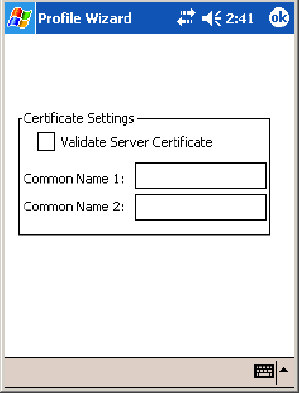
Configurable SettingsAppendix —A
244 700 Series Color Mobile Computer User’s Manual
Additional Settings
1Check Validate Server Certificate to verify the identity of the authenti-
cation server based on its certificate when using PEAP or TLS.
2Enter the Common Names of trusted servers. Note that if these fields are
left blank, the server certificate trust validation is not performed or required.
3Click ok to return to the Security page.
TTLS (EAP-Tunneled TLS)
This protocol provides authentication like EAP-TLS (see page 242) but
does not require certificates for every user. Instead, authentication servers
are issued certificates. User authentication is done using a password or oth-
er credentials that are transported in a securely encrypted “tunnel” estab-
lished using server certificates.
EAP-TTLS works by creating a secure, encrypted tunnel through which
you present your credentials to the authentication server. Thus, inside
EAP-TTLS there is another inner authentication protocol that you must
configure via Additional Settings.
Use “TTLS” to configure the use of EAP-TTLS as an authentication pro-
tocol, and select either “Open” or “WPA” as an association mode.
ToEnableTTLSwithanOpenAssociation(default configuration)
1Set 8021x Security as “TTLS.”
2Set Association to “Open.”
3Enter your unique user name and password to use this protocol. Select
Prompt for password to have the user enter this password each time to
access the protocol, or leave Use following password as selected to auto-
matically use the protocol without entering a password.
4Tap Get Certificates to obtain or import server certificates (page 247).
5Tap Additional Settings to assign an inner TTLS authentication and an
inner EAP, and set server certificate validation and trust (page 246).

Configurable SettingsAppendix —A
245700 Series Color Mobile Computer User’s Manual
To Enable TTLS with WPA Encryption
1Set 8021x Security as “TTLS.”
2Set Association to “WPA” (see page 236).
3Enter your unique user name and password to use this protocol. Select
Prompt for password to have the user enter this password each time to
access the protocol, or leave Use following password as selected to auto-
matically use the protocol without entering a password.
4Tap Get Certificates to obtain or import server certificates (page 247).
5Tap Additional Settings to assign an inner TTLS authentication and an
inner EAP, and set server certificate validation and trust (see page 246).
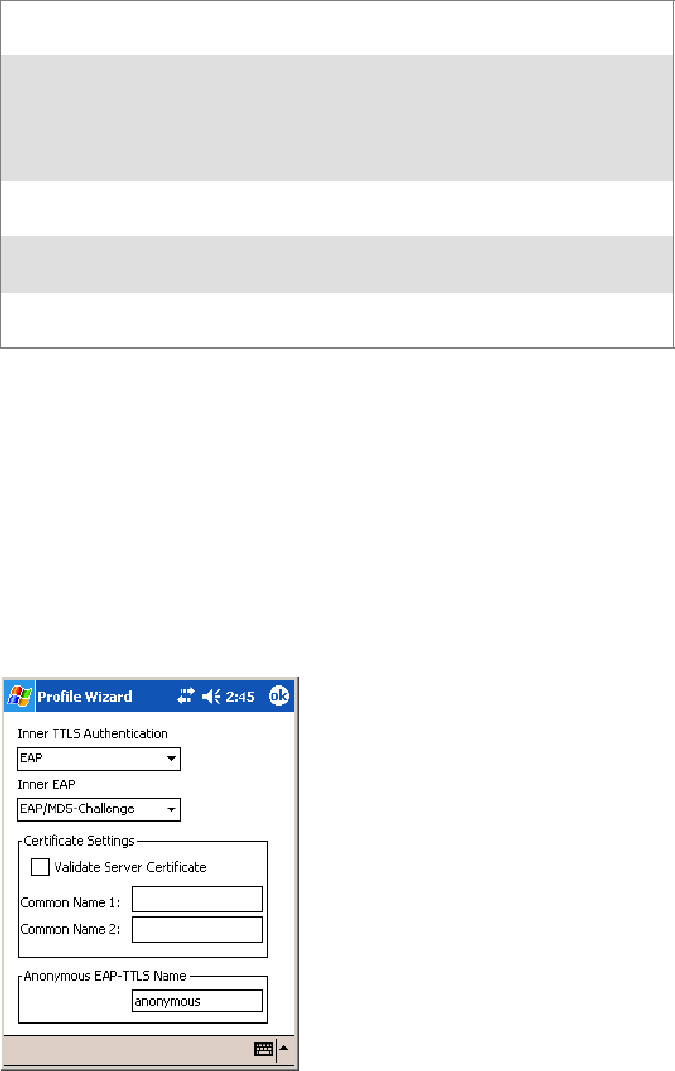
Configurable SettingsAppendix —A
246 700 Series Color Mobile Computer User’s Manual
Additional Settings
1Select an authentication protocol from the Inner TTLS Authentication
drop-down list:
PAP Password Authentication Protocol. A simple authentication
protocol that sends security information in the clear.
CHAP Challenge Handshake Authentication Protocol. Use of Radius
to authenticate a terminal without sending security data in the
clear. Authenticates against non-Windows user databases. You
cannot use this if authenticating against a Windows NT Domain
or Active Directory.
MS-CHAP;
MS-CHAP-V2
Authenticates against a Windows Domain Controller and other
non-Windows user databases.
PAP/Token Card Use with token cards. The password value entered is never
cached.
EAP Extensible Authentication Protocol. See page 236 for informa-
tion about EAP.
2If you select “EAP” for the inner authentication protocol, then select an
inner EAP protocol from the Inner EAP drop-down list.
3Enter the Common Names of trusted servers. Note that if these fields are
left blank, the server certificate trust validation is not performed or required.
4Check Validate Server Certificate to verify the identity of the authenti-
cation server based on its certificate when using TTLS, PEAP, and TLS.
5Enter the Anonymous EAP-TTLS Name as assigned for public usage.
Use of this outer identity protects your login name or identity.
6Click ok to return to the Security page.
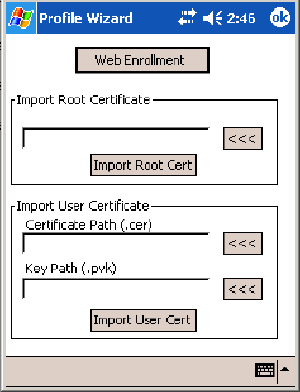
Configurable SettingsAppendix —A
247700 Series Color Mobile Computer User’s Manual
To Get Certificates
Certificates are pieces of cryptographic data that guarantee a public key is
associated with a private key. They contain a public key and the entity
name that owns the key. Each certificate is issued by a certificate authority.
Use this page to import a certificate onto the 700 Color Computer.
Root Certificates
1Tap the <<< button next to the Import Root Certificate field to select
the root certificate (DER-encoded .CER file) to import.
2Click Import Root Cert to install the selected certificate.
User Certificate
1Tap the <<< button next to the Certificate Path field to select the user
certificate (DER-encoded .CER file without the private key) to import.
2Tap the <<< button next to the Key Path field to select the private key
(.PVK file) which corresponds to the user certificate chosen in step 1.
3Tap Import User Cert to install the selected certificate.
Web Enrollment
Tap Web Enrollment to obtain a user certificate over the network from an
IAS Server. Tap ok to return to the Security page.
LEAP (Cisco Lightweight EAP)
LEAP is the Cisco Lightweight version of EAP. See page 236 for informa-
tion about EAP.
Use “LEAP” to configure the use of LEAP as an authentication protocol,
select “Open,” “WPA,” or “Network EAP” as an association mode. Note
this defaults to the Network EAP.
To Enable LEAP with an Open Association
1Set 8021x Security as “LEAP” and Association to “Open.”
2EnteryouruniqueUser Name to use this protocol.

Configurable SettingsAppendix —A
248 700 Series Color Mobile Computer User’s Manual
3Select Prompt for password to have the user enter this password each
time to access the protocol, or leave Use following password as selected
to automatically use the protocol without entering a password.
To Enable LEAP with WPA Encryption
1Set 8021x Security as “LEAP” and Association to “WPA” (see page
236).
2EnteryouruniqueUser Name to use this protocol.
3Select Prompt for password to have the user enter this password each
time to access the protocol, or leave Use following password as selected
to automatically use the protocol without entering a password.
To Enable LEAP with Network EAP
1Set 8021x Security as “LEAP,” Association to “Network EAP” (see page
236), and Encryption to either “WEP” (page 236) or “CKIP” (page
235).
2EnteryouruniqueUser Name to use this protocol.
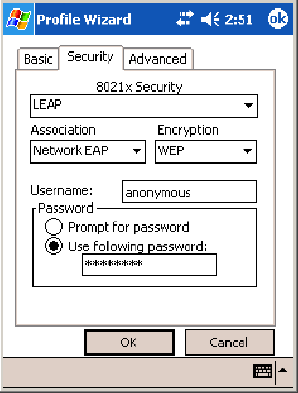
Configurable SettingsAppendix —A
249700 Series Color Mobile Computer User’s Manual
3Select Prompt for password to have the user enter this password each
time to access the protocol, or leave Use following password as selected
to automatically use the protocol without entering a password.
EAP-FAST (EAP -Flexible Authentication via Secured Tunnel)
The EAP-FAST protocol is a client-server security architecture that en-
crypts EAP transactions with a TLS tunnel. While similar to PEAP, it dif-
fers significantly as EAP-FAST tunnel establishment is based on strong se-
crets unique to users. These secrets are called Protected Access Credentials
(PACs), which CiscoSecure ACS generates using a master key known only
to CiscoSecure ACS. Because handshakes based upon shared secrets are
intrinsically faster than handshakes based upon PKI, EAP-FAST is the sig-
nificantly faster of the two solutions that provide encrypted EAP transac-
tions. No certificate management is required to implement EAP-FAST.
Use “EAP-FAST” to configure the use of EAP-FAST as an authentication
protocol, select “Open,” “WPA,” or “Network EAP” as an association
mode. Note this defaults to the Network EAP.
To Enable EAP-FAST with an Open Association
1Set 8021x Security as “EAP-FAST” and Association to “Open.”
2EnteryouruniqueUsername to use this protocol.
3Select Prompt for password to have the user enter this password each
time to access the protocol, or leave Use following password as selected
to automatically use the protocol without entering a password.

Configurable SettingsAppendix —A
250 700 Series Color Mobile Computer User’s Manual
4Tap Additional Settings to set options for PAC management and assign
an anonymous EAP-FAST name (see page 251).
To Enable EAP-FAST with WPA Encryption
1Set 8021x Security as “EAP-FAST” and Association to “WPA” (see
page 236).
2EnteryouruniqueUsername to use this protocol.
3Select Prompt for password to have the user enter this password each
time to access the protocol, or leave Use following password as selected
to automatically use the protocol without entering a password.
4Tap Additional Settings to set options for PAC management and assign
an anonymous EAP-FAST name (see page 251).
To Enable EAP-FAST with Network EAP
1Set 8021x Security as “EAP-FAST,” Association to “Network EAP”
(page 236), and Encryption to either “WEP”(page 236) or “CKIP”
(page 235).
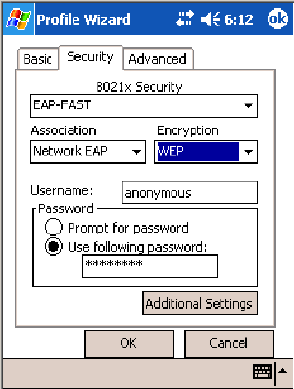
Configurable SettingsAppendix —A
251700 Series Color Mobile Computer User’s Manual
2EnteryouruniqueUsername to use this protocol.
3Select Prompt for password to have the user enter this password each
time to access the protocol, or leave Use following password as selected
to automatically use the protocol without entering a password.
4Tap Additional Settings to set options for PAC management and assign
an anonymous EAP-FAST name. See below for more information.
Additional Settings
1Tap PAC Manager to view the PAC files currently installed on your
700 Color Computer. Tap ok to return to the Additional Settings
screen.
2If you already have a PAC on your 700 Color Computer, clear Allow
Automatic PAC provisioning to avoid receiving additional PACs from
the server.
3If Allow Automatic PAC provisioning is checked, you can check:
SPrompt before acquiring a new PAC for notification of any incom-
ing PACs.
SPrompt before replacing a PAC for notification whether to replace a
current PAC with an incoming PAC.
4Enter the Anonymous EAP-FAST Name as assigned for public usage.
This outer identity protects your login name or identity.
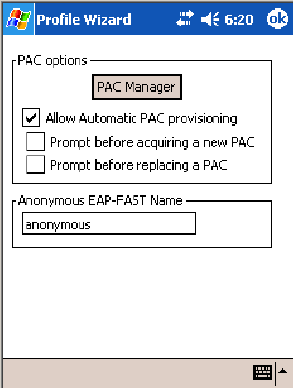
Configurable SettingsAppendix —A
252 700 Series Color Mobile Computer User’s Manual
5Check ok to return to the Security page.
Advanced
Use this page to configure additional settings for this profile. Tap ok or
OK to return to the Profiles page.
SDetect Rogue APs:
Wireless NICs and APs associate based on the SSID configured for the
NIC. Given an SSID, the BSSID with the strongest signal is often cho-
sen for association. After association, 802.1x authentication may occur
and during authentication credentials to uniquely identify a user —
these are passed between the NIC and the AP.
The base 802.1x technology does not protect the network from “rogue
APs.” These can mimic a legitimate AP to authentication protocols and
user credentials. This provides illegal users ways to mimic legitimate us-
ers and steal network resources and compromise security.
Check this box to detect and report client behavior suspected of being
rogue APs. Once a rouge AP is detected, your 700 Series Computer no
longer associates with that AP until you perform a warm boot.
Clear this box to solve AP connection problems that result when an AP
gets put on the rogue AP list due to inadvertent failed authentications
and not because it is a real rouge.
SEnable mixed cell:
Mixed cell is a profile-dependent setting. If enabled, you can connect to
mixed cell without using WEP, then you can query the cell to deter-
mine whether you can use encryption.
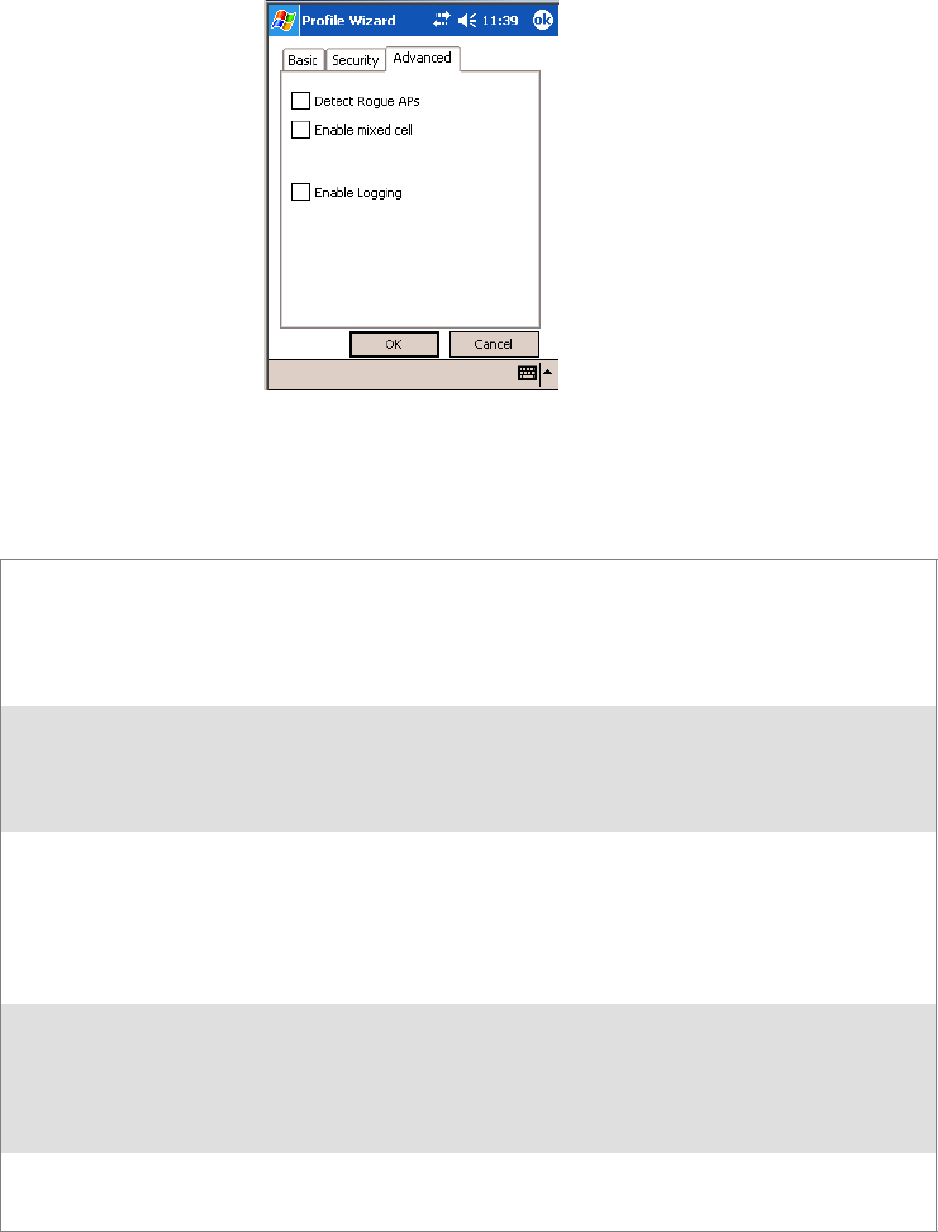
Configurable SettingsAppendix —A
253700 Series Color Mobile Computer User’s Manual
SEnable Logging:
Check this box to log what activity incurs for this profile.
Other Configurable Parameters
These can be configured by sending reader commands (next page) through
the network or from an application.
Audio Volume Changes the volume of all audio signals. 0Off
1 Very quiet
2Quiet
3Normal(default)
4Loud
5Veryloud
Automatic Shutoff Setsthelengthoftimethe700ColorComputerre-
mains on when there is no activity. When you turn on
the 700 Color Computer, it either resumes exactly
where it was when you turned it off or boots and restarts
your application.
11minute
22minutes
3 3 minutes (default)
44minutes
55minutes
Backlight Timeout Sets the length of time that the display backlight re-
mains on. If you set a longer timeout value, you use the
battery power at a faster rate.
10 10 seconds
30 30 seconds
60 1 minute (default)
120 2 minutes
180 3 minutes
240 4 minutes
300 5 minutes
Date/Time Sets the current date and time. Date Year 0000–9999 (1999)
Month 1–12 (6)
Day 1–31 (1)
Time Hour 0–23 (0)
Minute 0–59 (00)
Second 0–59 (00)
Key Clicks Enables or disables the keypad clicks. The 700 Color
Computer emits a click each time you press a key or
decode a row of a two-dimensional symbology.
0 Disable clicks
1Enablesoftkeyclicks
2 Enable loud key clicks (default)
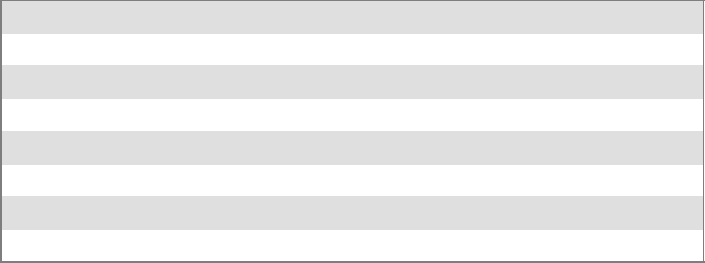
Configurable SettingsAppendix —A
254 700 Series Color Mobile Computer User’s Manual
Using Reader Commands
After the 700 Color Computer is connected to your network, you can
send the 700 Color Computer a reader command from an application to
perform a task, such as changing the time and date. Some reader com-
mands temporarily override the configuration settings and some change
the configuration settings.
Change Configuration
The Change Configuration command must precede any configuration
command. If you enter a valid string, the 700 Color Computer configura-
tion is modified and the computer emits a high beep. To send the Change
Configuration command through the network, use the $+ [command]
syntax where command is the two-letter command syntax for the configu-
ration command followed by the value to be set for that command.
You can also make changes to several different commands by using the
$+ [command]...[command n] syntax. There are seven configuration
command settings that can be changed in this way. See each command for
information on respective acceptable “data” values.
Command Syntax
Audio Volume BVdata
Automatic Shutoff EZdata
Backlight Timeout DFdata
Key Clicks KCdata
Virtual Wedge Grid AFdata
Virtual Wedge Postamble AEdata
Virtual Wedge Preamble ADdata
Example 1
To change the Beep Volume to Off, you can send this string to the 700
Color Computer through the network: $+BV0
where:
$+ Indicates Change Configuration.
BV Specifies the Audio Volume parameter.
0Specifies a value of Off.
Example 2
To change the Beep Volume to Very Quiet and the Virtual Wedge Grid
to 123: $+BV1AF123
where:
$+ Indicates Change Configuration
BV1 Specifies Audio Volume, set to Very Quiet (1)
AF123 Specifies Virtual Wedge Grid, set to a value of 123.
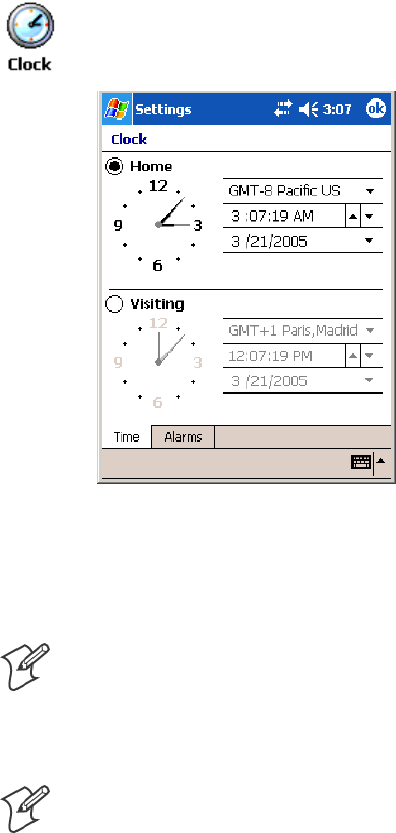
Configurable SettingsAppendix —A
255700 Series Color Mobile Computer User’s Manual
Set Time and Date
This command sets the date and time on the 700 Color Computer. The
default date and time is June 1, 1999 at 12:00 AM.
From the network, send the following:
/+ yyyymmddhhmmss
whereacceptablevaluesforthedateare:
yyyy 0000–9999 Year
mm 01–12 Month of the year
dd 01–31 Day of the month
hh 00–23 Hour
mm 00–59 Minutes
ss 00–59 Seconds
You can also set the time and date by using Configuration Management in
Unit Manager, or by using the Clock applet in the Settings menu. To
access this applet, tap Start >Settings >theSystem tab>theClock icon.
Configuration Bar Codes
You can change some settings on your 700 Color Computer by scanning
the following Code 39 bar code labels.
Note: When you use a bar code creation utility to make a scannable bar
code label, the utility probably adds opening and closing asterisks automat-
ically. Asterisks are included here for translation purposes.
Audio Volume
Note: The Audio Volume parameter information is on page 253.
Turn Audio Off
*$+BV0*
*$+BV0*

Configurable SettingsAppendix —A
256 700 Series Color Mobile Computer User’s Manual
Set Audio Volume to very quiet
*$+BV1*
*$+VB1*
Set Audio Volume to quiet
*$+BV2*
*$+BV2*
Set Audio Volume to normal (default)
*$+BV3*
*$+BV3*
Set Audio Volume to loud
*$+BV4*
*$+BV4*
Set Audio Volume to very loud
*$+BV5*
*$+BV5*
Automatic Shutoff
Note: The Automatic Shutoff parameter information is on page 253.
Set Automatic Shutoff to 1 minute
*$+EZ1*
*$+EZ1*
Set Automatic Shutoff to 2 minutes
*$+EZ2*
*$+EZ2*
Set Automatic Shutoff to 3 minutes (default)
*$+EZ3*
*$+EZ3*
Set Automatic Shutoff to 4 minutes
*$+EZ4*
*$+EZ4*
Set Automatic Shutoff to 5 minutes
*$+EZ5*
*$+EZ5*
Backlight Timeout
Note: The Backlight Timeout parameter information is on page 253.
Backlight Timeout 10 seconds
*$+DF10*
*$+DF10*

Configurable SettingsAppendix —A
257700 Series Color Mobile Computer User’s Manual
Backlight Timeout 30 seconds
*$+DF30*
*$+DF30*
Backlight Timeout 1 minute (default)
*$+DF60*
*$+DF60*
Backlight Timeout 2 minutes
*$+DF120*
*$+DF120*
Backlight Timeout 3 minutes
*$+DF180*
*$+DF180*
Backlight Timeout 4 minutes
*$+DF240*
*$+DF240*
Backlight Timeout 5 minutes
*$+DF300*
*$+DF300*
Key Clicks
Note: The Key Clicks parameter information is on page 253.
Disable key clicks
*$+KC0*
*$+KC0*
Enable soft key clicks
*$+KC1*
*$+KC1*
Enable loud key clicks (default)
*$+KC2*
*$+KC2*
Virtual Wedge Grid, Preamble, Postamble
The following parameters are user-configurable strings. Refer to a full
ASCII chart for more information.
Grid
For Virtual Wedge Grid, the first part of the bar code is the following,
which can include a string of up to 240 characters.
*$+AF
*$+AF
Configurable SettingsAppendix —A
258 700 Series Color Mobile Computer User’s Manual
Preamble
For Virtual Wedge Preamble, the first part of the bar code is below, fol-
lowed by a string of up to 31 characters (no <NUL>) and an asterisk. De-
fault is no characters.
*$+AD
*$+AD
Postamble
For Virtual Wedge Postamble, the first part of the bar code is below, fol-
lowed by a string of up to 31 characters (no <NUL>) and an asterisk. De-
fault is no characters.
*$+AE
*$+AE

259700 Series Color Mobile Computer User’s Manual
Troubleshooting
B
This appendix contains a brief explanation of what you can do to trouble-
shoot your 700 Color Mobile Computer.

TroubleshootingAppendix —B
260 700 Series Color Mobile Computer User’s Manual
Problem Solutions
The 700 Color Computer does not respond when con-
nected to a power supply.
Make sure your ac adapter or dock is plugged in and is
making good contact with your mobile computer.
The 700 Color Computer will not turn on when the I/O
key is pressed.
The AB10 battery may be low and need recharging.
The Power status LED starts blinking. The Power status LED provides the status of your bat-
tery pack when it is connected to a charging device. See
Chapter 1, “Introduction,” for LED descriptions.
The 700 Color Computer will not turn on and the
screen is blank.
The battery may be critically low. Put your mobile com-
puterinanAD15orAD18chargerforatleastfivemin-
utes, remove it from the dock, then press the I/O button.
The screen should turn on.
Put your mobile computer back in the charger and con-
tinue to charge your mobile computer for at least four
hours to make sure the battery is fully charged.
The 700 Color Computer will not turn on when placed
in a dock.
Make sure the dock is plugged in and your mobile com-
puter is securely seated in the dock.
The700ColorComputershutsdownduringoperation. You may have a very low battery. Put the battery in an
AC15 or AC16 charger.
The 700 Color Computer does not turn off. The 700 Color Computer does not turn off while it is
processing data. If this situation continues for a long
period of time, it does run down the battery unless you
have it connected to an external power, or in a charging
dock.
Should the 700 Color Computer lock up, perform a
warm-boot. If the mobile computer stays locked up, then
perform a cold-boot. See Chapter 1, “Introduction,” for
information on performing warm-boots and cold-boots.
The 700 Color Computer takes a long time to boot up
after a warm- or cold-boot is performed.
Normal recovery time is 30 to 45 seconds. If the recovery
takes longer, then contact support personnel.

261700 Series Color Mobile Computer User’s Manual
Index
I
The Classes and Functions Index covers 700 Color classes and functions.
The General Index covers all topics. Those in italics are figures, those in bold are
tables.
The Files Index is to assist you in locating descriptions for device drivers, applica-
tions, utilities, batch files, or other files within this publication.
Index
262 700 Series Color Mobile Computer User’s Manual
Classes and Functions
A
add_registry_section, [AddReg]
flags, 194
registry_root_string, 194
value_name, 194
AddReg, [DefaultInstall], 191
[AddReg], add_registry_section
flags, 194
registry_root_string, 194
value_name, 194
AppName, [CEStrings], 189
Asset management, DeviceURL parameter, 204
B
BlockSize, FTP Server, 204
BuildMax, [CEDevice], 190
BuildMin, [CEDevice], 190
C
[CEDevice]
BuildMax, 190
BuildMin, 190
ProcessorType, 189
UnsupportedPlatforms, 189
VersionMax, 190
VersionMin, 190
CESelfRegister, [DefaultInstall], 191
CESetupDLL, [DefaultInstall], 191
CEShortcuts, [DefaultInstall], 191
[CEShortcuts], shortcut_list_section
shortcut_filename, 194
shortcut_type_flag, 194
target_file/path, 195
target_file_path, 195
CESignature
[SourceDiskNames], 191
[Version], 188
[CEStrings]
AppName, 189
InstallDir, 189
ClassID field values
VN_CLASS_ASIC, 212
VN_CLASS_BOOTSTRAP, 212
VN_CLASS_KBD, 212
CloseHandle()
DTR printing, 167, 168
IrDA printing, 162
NPCP printing, 163, 164
Cold boot, IOCTL_HAL_COLDBOOT, 217
Copyfiles, [DefaultInstall], 191
[CopyFiles], file_list_section
destination_filename, 193
flags, 193
source_filename, 193
CreateEvent(), 225
CreateFile()
DTR printing, 167
IrDA printing, 162
NPCP printing, 163, 164
D
[DefaultInstall]
AddReg, 191
CESelfRegister, 191
CESetupDLL, 191
CEShortcuts, 191
Copyfiles, 191
DeregisterDevice(), 163
DTR printing, 167
[DestinationDirs], file_list_section, 192
DeviceIOControl()
DTR printing, 167
NPCP printing, 163
DeviceIoControl(), NPCP printing, 164
DeviceName,FTPServer,204
DeviceURL, FTP Server, 204
disk_ordinal, [SourceDiskNames], 191
DllRegisterServer, 191
DllUnregisterServer, 191
E
ERROR_INSUFFICIENT_BUFFER
IOCTL_HAL_ITC_READ_PARM, 211
IOCTL_HAL_ITC_WRITE_SYSPARM, 214
ERROR_INVALID_PARAMETER
IOCTL_HAL_ITC_READ_PARM, 211
IOCTL_HAL_ITC_WRITE_SYSPARM, 214
F
File Transfer Protocol. See FTP
file_list_section
[CopyFiles]
destination_filename, 193
flags, 193
source_filename, 193
[DestinationDirs], 192
filename, [SourceDiskFiles], 192
FTP
client, 205
configurable parameters, 204
BlockSize, 204
DeviceName, 204
DeviceURL, 204
PauseAtStartup, 205
FTPDCMDS subdirectory, 208
RTC 959, 208
server, 205
server requests
CDUP, 205
CWD, 205
DELE, 206
HELP, 206
LIST, 206
MKD, 206
MODE, 206
NLST, 206
NOOP, 206
PASS, 206
PWD, 206
Index
263700 Series Color Mobile Computer User’s Manual
QUIT, 206
RETR, 206
RMD, 206
RNFR, 206
RNTO, 206
SITE, 206
SITE ATTRIB, 206
SITE BOOT, 207
SITE COPY, 207
SITE EKEY, 207
SITE EVAL, 207
SITE EXIT, 207
SITE GVAL, 208
SITE HELP, 207
SITE KILL, 207
SITE LOG, 207
SITE PLIST, 207
SITE PVAL, 208
SITE RUN, 207
SITE STATUS, 207
SITE TIMEOUT, 207
STOR, 206
SYST, 206
TYPE, 206
USER, 206
XCUP, 206
XCWD, 206
XMKD, 206
XPWD, 206
XRMD, 206
stopping server from application, 208
support, 205
web browsers, 208
H
HAL, verion of Pocket PC
IOCTL_HAL_GET_BOOTLOADER_VERINFO,
216
IOCTL_HAL_GET_OAL_VERINFO, 216
I
ID field values
IOCTL_HAL_ITC_READ_PARM
ITC_NVPARM_80211_INSTALLED, 213
ITC_NVPARM_80211_RADIOTYPE, 213
ITC_NVPARM_ANTENNA_DIVERSITY, 212
ITC_NVPARM_BLUETOOTH_INSTALLED,
213
ITC_NVPARM_CONTRAST, 212
ITC_NVPARM_DISPLAY_TYPE, 212
ITC_NVPARM_ECN, 212
ITC_NVPARM_EDBG_SUBNET, 212
ITC_NVPARM_EDG_IP, 212
ITC_NVPARM_ETHERNET_ID, 212
ITC_NVPARM_INTERMEC_DATACOLLEC-
TION_HW, 213
ITC_NVPARM_INTERMEC_DATACOLLEC-
TION_SW, 212
ITC_NVPARM_INTERMEC_SOFT-
WARE_CONTENT, 212
ITC_NVPARM_LAN9000_INSTALLED, 213
ITC_NVPARM_MANF_DATE, 212
ITC_NVPARM_MCODE, 212
ITC_NVPARM_RTC_RESTORE, 212
ITC_NVPARM_SERIAL_NUM, 212
ITC_NVPARM_SERIAL2_INSTALLED, 213
ITC_NVPARM_SERVICE_DATE, 212
ITC_NVPARM_SIM_PRO-
TECT_HW_INSTALLED, 213
ITC_NVPARM_SIM_PRO-
TECT_SW_INSTALLED, 213
ITC_NVPARM_VERSION_NUMBER, 212
ITC_NVPARM_VIBRATE_INSTALLED, 213
ITC_NVPARM_WAN_FREQUENCY, 213
ITC_NVPARM_WAN_INSTALLED, 213
ITC_NVPARM_WAN_RADIOTYPE, 213
ITC_NVPARM_WAN_RI, 212
IOCTL_HAL_ITC_WRITE_SYSPARM
ITC_ DOCK_SWITCH, 214
ITC_ WAKEUP_MASK, 215
ITC_AMBIENT_FRONTLIGHT, 215
ITC_AMBIENT_KEYBOARD, 215
ITC_REGISTRY_SAVE_ENABLE, 214
IDNA
DeviceName, 204
DeviceURL, 204
IDNATarget, FTP Server, 204
InstallDir, [CEStrings], 189
Intermec Device Network Announcement. See IDNA
IOCTL_GET_CPU_ID, 220
IOCTL_HAL_COLDBOOT, 217, 222
IOCTL_HAL_GET_BOOT_DEVICE, 219
IOCTL_HAL_GET_BOOTLOADER_VERINFO, 216
IOCTL_HAL_GET_DEVICE_INFO, 210
IOCTL_HAL_GET_DEVICEID, 215
IOCTL_HAL_GET_OAL_VERINFO, 216
IOCTL_HAL_GET_RESET_INFO, 218
IOCTL_HAL_ITC_READ_PARM, 211
IOCTL_HAL_ITC_WRITE_SYSPARM, 214
IOCTL_HAL_REBOOT, 219, 222
IOCTL_HAL_WARMBOOT, 217, 222
IOCTL_PROCESSOR_INFORMATION, 220
ITC_ DOCK_SWITCH, 214
ITC_ WAKEUP_MASK, 215
ITC_AMBIENT_FRONTLIGHT, 215
ITC_AMBIENT_KEYBOARD, 215
ITC_DEVID_80211RADIO_INTEL_2011B, 213
ITC_DEVID_80211RADIO_MAX values
ITC_DEVID_80211RADIO_INTEL_2011B, 213
ITC_DEVID_80211RADIO_NONE, 213
ITC_DEVID_80211RADIO_NONE, 213
ITC_DEVID_INTERMEC_EVIO, 213
ITC_DEVID_INTERMEC2D_IMAGER, 213
ITC_DEVID_OEM2D_IMAGER, 213
Index
264 700 Series Color Mobile Computer User’s Manual
ITC_DEVID_SCANHW_MAX values
ITC_DEVID_INTERMEC_EVIO, 213
ITC_DEVID_INTERMEC2D_IMAGER, 213
ITC_DEVID_OEM2D_IMAGER, 213
ITC_DEVID_SCANHW_NONE, 213
ITC_DEVID_SE900_LASER, 213
ITC_DEVID_SE900HS_LASER, 213
ITC_DEVID_SCANHW_NONE, 213
ITC_DEVID_SE900_LASER, 213
ITC_DEVID_SE900HS_LASER, 213
ITC_DEVID_WANRADIO_NONE, 213
ITC_DEVID_WANRADIO_SIEMENS_MC45, 213
ITC_DEVID_WANRADIO_SIEMENS_MC46, 213
ITC_DEVID_WANRADIO_SIERRA_SB555, 213
ITC_DEVID_WANRADIO_XIRCOM_GEM3503, 213
ITC_IFTP_STOP, 208
ITC_NVPARM_80211_INSTALLED, 213
ITC_NVPARM_80211_RADIOTYPE, 213
ITC_NVPARM_ANTENNA_DIVERSITY, 212
ITC_NVPARM_BLUETOOTH_INSTALLED, 213
ITC_NVPARM_CONTRAST, 212
ITC_NVPARM_DISPLAY_TYPE, 212
ITC_NVPARM_ECN, 212
ITC_NVPARM_EDBG_SUBNET, 212
ITC_NVPARM_EDG_IP, 212
ITC_NVPARM_ETHERNET_ID, 212
ITC_NVPARM_INTERMEC_DATACOLLEC-
TION_HW, 213
ITC_NVPARM_INTERMEC_DATACOLLEC-
TION_SW, 212
ITC_NVPARM_INTERMEC_SOFTWARE_CON-
TENT, 212
ITC_NVPARM_LAN9000_INSTALLED, 213
ITC_NVPARM_MANF_DATE, 212
ITC_NVPARM_MCODE, 212
ITC_NVPARM_RTC_RESTORE, 212
ITC_NVPARM_SERIAL_NUM, 212
ITC_NVPARM_SERIAL2_INSTALLED, 213
ITC_NVPARM_SERVICE_DATE, 212
ITC_NVPARM_SIM_PROTECT_HW_INSTALLED,
213
ITC_NVPARM_SIM_PROTECT_SW_INSTALLED,
213
ITC_NVPARM_VERSION_NUMBER, 212
ITC_NVPARM_VIBRATE_INSTALLED, 213
ITC_NVPARM_WAN_FREQUENCY, 213
ITC_NVPARM_WAN_INSTALLED, 213
ITC_NVPARM_WAN_RADIOTYPE, 213
ITC_NVPARM_WAN_RI, 212
ITC_REGISTRY_SAVE_ENABLE, 214
K
KernelIoControl
IOCTL_GET_CPU_ID, 220
IOCTL_HAL_COLDBOOT, 217, 222
IOCTL_HAL_GET_BOOT_DEVICE, 219
IOCTL_HAL_GET_BOOTLOADER_VERINFO,
216
IOCTL_HAL_GET_DEVICE_INFO, 210
IOCTL_HAL_GET_DEVICEID, 215
IOCTL_HAL_GET_OAL_VERINFO, 216
IOCTL_HAL_GET_RESET_INFO, 218
IOCTL_HAL_ITC_READ_PARM, 211
IOCTL_HAL_ITC_WRITE_SYSPARM, 214
IOCTL_HAL_REBOOT, 219, 222
IOCTL_HAL_WARMBOOT, 217, 222
IOCTL_PROCESSOR_INFORMATION, 220
KernelIoControl(), 210
L
lpBytesReturned
IOCTL_GET_CPU_ID, 221
IOCTL_HAL_GET_BOOT_DEVICE, 219
IOCTL_HAL_GET_BOOTLOADER_VERINFO,
217
IOCTL_HAL_GET_DEVICE_INFO, 211
IOCTL_HAL_GET_DEVICEID, 215
IOCTL_HAL_GET_OAL_VERINFO, 216
IOCTL_HAL_GET_RESET_INFO, 218
IOCTL_HAL_ITC_READ_PARM, 211
IOCTL_HAL_ITC_WRITE_SYSPARM, 214
IOCTL_PROCESSOR_INFORMATION, 220
lpInBuf
IOCTL_GET_CPU_ID, 220
IOCTL_HAL_COLDBOOT, 218
IOCTL_HAL_GET_BOOT_DEVICE, 219
IOCTL_HAL_GET_BOOTLOADER_VERINFO,
216
IOCTL_HAL_GET_DEVICE_INFO, 211
IOCTL_HAL_GET_DEVICEID, 215
IOCTL_HAL_GET_OAL_VERINFO, 216
IOCTL_HAL_GET_RESET_INFO, 218
IOCTL_HAL_ITC_READ_PARM, 211
IOCTL_HAL_ITC_WRITE_SYSPARM, 214
IOCTL_HAL_REBOOT, 219
IOCTL_HAL_WARMBOOT, 217
IOCTL_PROCESSOR_INFORMATION, 220
lpInBufSize
IOCTL_GET_CPU_ID, 220
IOCTL_HAL_COLDBOOT, 218
IOCTL_HAL_GET_BOOT_DEVICE, 219
IOCTL_HAL_GET_DEVICE_INFO, 211
IOCTL_HAL_GET_DEVICEID, 215
IOCTL_HAL_GET_OAL_VERINFO, 216
IOCTL_HAL_GET_RESET_INFO, 218
IOCTL_HAL_REBOOT, 219
IOCTL_HAL_WARMBOOT, 217
lpOutBuf
IOCTL_GET_CPU_ID, 221
IOCTL_HAL_COLDBOOT, 218
IOCTL_HAL_GET_BOOT_DEVICE, 219
IOCTL_HAL_GET_BOOTLOADER_VERINFO,
217
IOCTL_HAL_GET_DEVICE_INFO, 211
IOCTL_HAL_GET_DEVICEID, 215
IOCTL_HAL_GET_OAL_VERINFO, 216
IOCTL_HAL_GET_RESET_INFO, 218
IOCTL_HAL_ITC_READ_PARM, 211
IOCTL_HAL_ITC_WRITE_SYSPARM, 214
IOCTL_HAL_REBOOT, 219
Index
265700 Series Color Mobile Computer User’s Manual
IOCTL_HAL_WARMBOOT, 217
IOCTL_PROCESSOR_INFORMATION, 220
M
ManifestName,FTPServer,205
N
nDeviceId, NLEDGetDeviceInfo, 222
nInBufSize
IOCTL_HAL_GET_BOOTLOADER_VERINFO,
216
IOCTL_HAL_ITC_READ_PARM, 211
IOCTL_HAL_ITC_WRITE_SYSPARM, 214
IOCTL_PROCESSOR_INFORMATION, 220
nInfoId, NLEDGetDeviceInfo, 222
NLED_COUNT_INFO, NLEDGetDeviceInfo, 222
NLED_SETTINGS_INFO_ID, NLEDGetDeviceInfo,
222
NLED_SUPPORTS_INFO_ID, NLEDGetDeviceInfo,
222
NLEDGetDeviceInfo, 221
NLEDSetDevice, 222
nOutBufSize
IOCTL_GET_CPU_ID, 221
IOCTL_HAL_COLDBOOT, 218
IOCTL_HAL_GET_BOOT_DEVICE, 219
IOCTL_HAL_GET_BOOTLOADER_VERINFO,
217
IOCTL_HAL_GET_DEVICE_INFO, 211
IOCTL_HAL_GET_DEVICEID, 215
IOCTL_HAL_GET_OAL_VERINFO, 216
IOCTL_HAL_GET_RESET_INFO, 218
IOCTL_HAL_ITC_READ_PARM, 211
IOCTL_HAL_ITC_WRITE_SYSPARM, 214
IOCTL_HAL_REBOOT, 219
IOCTL_HAL_WARMBOOT, 217
IOCTL_PROCESSOR_INFORMATION, 220
O
Object store
IOCTL_HAL_COLDBOOT, 217
IOCTL_HAL_REBOOT, 219
IOCTL_HAL_WARMBOOT, 217
Oldstyle device ID, 215
OSVERSIONINFO.dwBuildNumber, 190
OSVERSIONINFO.dwVersionMajor, 190
OSVERSIONINFO.dwVersionMinor, 190
P
PauseAtStartup, FTP Server, 205
pInput, NLEDSetDevice, 222
Pocket PC
IOCTL_HAL_GET_BOOTLOADER_VERINFO,
216
IOCTL_HAL_GET_OAL_VERINFO, 216
pOutput, NLEDGetDeviceInfo, 222
Processor information, IOCTL_PROCESSOR_IN-
FORMATION, 220
ProcessorType, [CEDevice], 189
Provider, [Version], 188
R
ReadFile(), NPCP printing, 163
Reboot methods
IOCTL_HAL_COLDBOOT, 222
IOCTL_HAL_REBOOT, 222
IOCTL_HAL_WARMBOOT, 222
RegFlushKey(), 202
RegisterDevice(), 163
DTR printing, 167
Registry
FTP Server parameters, 204
save location, IOCTL_HAL_ITC_WRITE_SYSPARM,
214
RegOpenKeyEx(), 224
RegQueryValueEx(), 224
RegSetValueEx(), 224
RFC 959, 208
Root, FTP Server, 205
S
SHFullScreen(), 202
shortcut_list_section, [CEShortcuts]
shortcut_filename, 194
shortcut_type_flag, 194
target_file/path, 195
target_file_path, 195
Signature, [Version], 188
SIM cards
protection hardware, 213
software installed, 213
[SourceDiskFiles], filename, 192
[SourceDiskNames]
CESignature, 191
disk_ordinal, 191
SourceDisksNames.MIPS, 192
SourceDisksNames.SH3, 192
string_key, [Strings], 189
[Strings], string_key, 189
SYSTEMINFO.dwProcessorType, 189
U
UDP, FTPDCE, 205
UDP broadcasts, IDNATarget parameter, 204
UnsupportedPlatforms, [CEDevice], 189
UUID, 215
V
[Version]
CESignature, 188
Provider, 188
Signature, 188
VersionMax, [CEDevice], 190
VersionMin, [CEDevice], 190
VN_CLASS_ASIC, 212
VN_CLASS_BOOTSTRAP, 212
VN_CLASS_KBD, 212
Index
266 700 Series Color Mobile Computer User’s Manual
W
WAN radio IDs
ITC_DEVID_WANRADIO_NONE, 213
ITC_DEVID_WANRADIO_SIEMENS_MC45, 213
ITC_DEVID_WANRADIO_SIEMENS_MC46, 213
ITC_DEVID_WANRADIO_SIERRA_SB555, 213
Warm boot
IOCTL_HAL_REBOOT, 219
IOCTL_HAL_WARMBOOT, 217
Wireless TCP/IP installations, BlockSize parameter, 204
WriteFile()
DTR printing, 167, 168
IrDA printing, 162
NPCP printing, 163, 164
X
Xscale processor ID, IOCTL_GET_CPU_ID, 220
Index
267700 Series Color Mobile Computer User’s Manual
General Index
Numbers
1551/1553 Tethered Scanner
configuring, 177
intermec settings, 177
reset to factory defaults, 180
troubleshooting, 179
1D area imager reading distances, 173
1D laser scanner, about, 169
2D area imager reading distances, 176
2D Imager, about, 169
4820 printer, NPCP driver, 163
6804DM printer, IrDA driver, 162
6804T printer, IrDA driver, 162
6805A printer, IrDA driver, 162
6806 printer, IrDA driver, 162
6808 printer
IrDA driver, 162
printer support, 161
6820 printer
IrDA driver, 162
NPCP driver, 163
printer support, 161
6920 Communications Server, ManifestName parameter,
205
740 Color Computer, 223
782T printer, printer support, 161
802.11
antenna color code, 98
channel, 237
communications setup, 108, 236
EAP-FAST
network EAP, 250
WPA encryption, 250
LEAP
network EAP, 248
WPA encryption, 248
network type, 237
PEAP
network EAP, 241
WPA encryption, 240
profile label, 237
profile security information, WEP encryption, 239
profiles, 237
advanced settings, 252
basic information, 237
security information, 238
SSID (network name), 237
TTLS, WPA encryption, 245
WPA authentication, Zero Configuration, 114
WPA authentication with pre-shared key, Zero Config-
uration, 114
WPA encryption, 239
zero configuration, WEP encryption, 113
A
AB10 battery
low battery conditions, 2
RAM maintenance, 3
status, 2
Abstract Syntax Notation.1. See ASN.1
Accessory list, 21
Accounts, via Inbox, 66
Activation wizard
Phone application, CDMA radios, 122
phone application, CDMA radios, 117, 119
ActiveSync
ActiveSync Help, 42
adding programs, 38
adding programs to Start menu, 40
Folder behavior connected to e-mail server, 64
installing applications, 87
Microsoft Reader, 77
Pocket Internet Explorer
favorite links, 80
mobile favorites, 80
Mobile Favorites folder, 80
replicating registry settings, 89
Start menu icon, 27
URL, 41
Windows Mobile, 41
Adding bookmarks, Microsoft Reader, 79
Adding drawings to text, Microsoft Reader, 79
Adding programs
ActiveSync, 38
Pocket Internet Explorer, 40
to the Start menu, 40
via ActiveSync, 40
via File Explorer, 40
Windows Mobile, 38
Adjusting settings, Windows Mobile, 38
Adobe Acrobat Reader, URL, 144
All-Day events, Calendar, 44
creating, 48
Alpha plane on keypad, 224
Alphanumeric keypad
alpha (blue) key sequences, 13
[gold/white] key sequences, 12
registry settings
alpha plane, 224
gold plane, 224
unshifted plane, 224
scan codes, 227
Ambient lighting, 4
Annotations index, Microsoft Reader, 79
Antenna, radio type, 98
APIs
AT command interface, 143
IrSock, 162
network selection, 221
App launch, utilities applet, 234
Index
268 700 Series Color Mobile Computer User’s Manual
Applets
Audio, 7
backlight, 4, 10
clock, 255
intermec settings, 9, 231
beeper volume, 8
internal scanners, 171
RFID, 184
scan buttons, 182
tethered scanners, 177
vibrator, 20
phone settings
CDMA radios, 123
GSM radios, 128
power
battery status, 2
RAM maintenance, 3
system, wireless network, 108, 236
utilities, 231
app launch, 234
dock switch, 232
registry save, 232
wakeup mask, 233
wireless network, 235
Application keys, utilities applet
app launch, 234
wakeup mask, 233
Appointments
Calendar
adding a note, 49
assigning to a category, 50
changing, 47
creating, 47
deleting, 53
finding, 52
making recurring, 50
setting a reminder, 48
viewing, 46
via Calendar, 42
APS linear imager, about, 169
ASCII
printing, 162
printing to a port, port print method, 162
raw text to printer, 162
ASN.1, 157
AT command interface, 143
testing, 144
Attaching notes to text, Microsoft Reader, 79
Audio applet, input mixing, 7
Audio files, Windows Media Player, 76
Audio system
external headset jack, 6
microphone, 5
speaker, 5
AutoCab, command line syntax, 95
AutoFTP, 209
AutoIP, 116
Automatic Private IP. See AutoIP
Automatic shutoff
bar code configuration, 253, 256
configuration parameter, 253
Autostart FTP, 209
AvantGo channels, Pocket Internet Explorer, 81
B
Backlight applet
ambient light sensor, 4
keypad, 10
Backlight timeout
bar code configuration, 253, 256
configuration parameter, 253
Bar code configuration
audio volume, 253
automatic shutoff, 253
backlight timeout, 253
key clicks, 253
Bar codes
configuration
audio volume, 255
automatic shutoff, 256
backlight timeout, 256
Code 39, 255
key clicks, 257
internal scanner supported symbologies, 172
scanning labels, 255
tethered scanner supported symbologies, 180
Battery
ambient lighting, 4
low battery conditions, 2
RAM maintenance, 3
specifications, 23
status, 2
Beeper
silencing the volume, 9
volume, turning it on, 7
Bell Mobility activation process, 143
Block recognizer, Windows Mobile input panel, 31
Bluetooth
accessing, 100, 103
activating, 100, 103
disable power, 183
WPport, 101
Bluetooth compatibility, network support, 99
Books, Microsoft Reader
adding bookmarks, 79
adding drawings, 79
annotations index, 79
attaching notes, 79
copying, 79
downloading, 77
highlighting, 79
reading, 78
removing, 79
searching, 79
Browsing the Internet, Pocket Internet Explorer, 83
Build information, software, 17
Index
269700 Series Color Mobile Computer User’s Manual
C
CAB files
after the extraction, 198
creating, 188
INF files, 188
with CAB Wizard, 201
installation functions, SETUP.DLL, 197
Cabinet Wizard
creating CAB files, 201
troubleshooting, 201
using the application, 188
Calendar
all day events, 44
creating, 48
appointments
adding a note, 49
assigning to a category, 50
changing, 47
creating, 47
deleting, 53
finding, 52
making recurring, 50
setting a reminder, 48
viewing, 46
categories, 43
meetings, sending a request, 51
options, changing, 53
Pocket Outlook, 42
recurrence pattern, 45
Start menu icon, 27
synchronizing, 43
Call Guard alert, enable while roaming, Phone application,
CDMA radios, 125
Call history, Phone application
CDMA radios, 122
GSM radios, 126
Capacitor, internal super, 2
Capturing thoughts and ideas, via Notes, 62
Card support
CompactFlash cards, 18
card slots, 19
MultiMediaCards, 18
radios, 21
Secure Digital cards, 18
card slots, 19
pull tabs, 19
SIM cards, 18
card slots, 19
Carrier, location of ESN, 133
Categories
calendar, 43
contacts, assigning to, 57
CDMA/1xRTT
activation with SB555 Watcher, 133
Bell Mobility, 143
Sprint, 137
Telus, 143
Verizon, 135
antenna color code, 98
AT command set, 144
copying files from web site, 131
via Microsoft ActiveSync, 131
via storage cards, 131
location of ESC, 133
phone activation, 117, 119
phone application, 117
setting up, 130
terminology, 130
Channel, 802.11 radio module, 237
Cisco compatible extension specifications, 21
Clock
restore real-time after cold-boot, 233
setting date and time, 255
Windows Mobile settings, 38
Closing drivers, NPCP, 164
Cold boot, performing, 16
COM A, modem position, 232
COM B, serial position, 232
COM1, NPCP parameter, 163
COM1 port, 162
Command line syntax, AutoCab, 95
Communications
DTR, 168
NPCP, 165
CompactFlash cards
card slots, 19
card support, 18
installing applications, 88
packaging an application, 86
specifications, 22
Computer shutdown, 2
Configuration parameters
automatic shutoff, 253
backlight timeout, 253
date/time, 253
key clicks, 253
volume, 253
Configuring service settings, Phone application, GSM ra-
dios, 128
Connecting to
an ISP, 148
work, 151
Connecting to a mail server, via Inbox, 65
Connections
See also Getting connected
ending, 156
to an ISP, 148
via modem, 148
to work, 151
via modem, 152
via VPN server, 154
via modem
to an ISP, 148
to work, 152
via VPN server, to work, 154
via wireless network, 111
Conserving battery power, 4
Index
270 700 Series Color Mobile Computer User’s Manual
Contacts
adding a note, 56
adding a telephone number
CDMA radios, 121
GSM radios, 127
adding to speed dial, 59
assigning to a category, 57
changing, 56
changing options, 59
copying, 57
creating, 54, 56
deleting, 59
finding, 58
MSN Messenger
managing, 75
sending messages, 76
working with, 75
Pocket Outlook, 53
sending a message, 58
Start menu icon, 27
synchronizing, 55
viewing, 55
Converting writing to text, 33
Copying, contacts, 57
Copying text, Microsoft Reader, 79
Creating
a modem connection
to an ISP, 148
to work, 152
a VPN server connection, to work, 154
a wireless network connection, 111
CAB files, 188
with CAB Wizard, 201
contacts via Contacts, 54
document via Pocket Word, 68
drawing via Notes, 35
INF files, 188
note via Notes, 62
task via Tasks, 61
workbook via Pocket Excel, 72
D
Data, Phone application, CDMA radios, 124
Date, setting, 255
Date/Time, configuration parameter, 253
DHCP, 116
replicating registry settings, 88
Display full screen, 202
Display specifications, 21
Dock switch, utilities applet, 232
Docks, modem support, 15
DRAM
low battery shutdown, 3
maintenance, 3
Drawing mode, Pocket Word, 70
Drawing on the screen
See also Notes
Pocket Word, 70
Drivers
DTR
communications, 168
installing, 167
opening, 167
removing, 167
writing to, 168
NPCP
closing, 164
communications, 165
I/O controls, 164
installing, 163
opening, 164
reading from, 164
removing, 163
writing to, 164
O’Neil. See DTR printing
DTR printing, 167
closing driver, 168
communications, 168
opening driver, 167
removing driver, 167
writing to driver, 168
E
EAP-FAST
802.11 radio module
network EAP, 250
WPA encryption, 250
profile security information, 249
WEP encryption, 249
Editing a profile, 237
EL10, about the laser scanner, 169
Emails, SMS messages via Phone application
CDMA radios, 123
GSM radios, 127
Ending a connection, 156
Environmental specifications, 22
Epson Escape Sequences, 162
ESN, location on computer, 133
Ethernet, communications setup, 109
ETSI GSM 07.05 interface specifications, 143
ETSI GSM 07.07 interface specifications, 143
Expansion slot specifications, 22
F
Favorite links, Pocket Internet Explorer, 80
File Explorer
adding programs to Start menu, 40
removing programs, 40
Windows Mobile, 37
Find feature, Windows Mobile, 37
Flash File Store, packaging an application, 86
Flash file system, utilities applet, registry save, 232
Folder behavior connected to e-mail server
ActiveSync, 64
IMAP4, 65
POP3, 65
SMS, 65
Index
271700 Series Color Mobile Computer User’s Manual
FRAME_NOT_ACKED, 165
FTP
configurable parameters
IDNATarget, 204
ManifestName, 205
Root, 205
heartbeat, 205
server, installing applications, 88
FTPDCMDS subdirectory, FTP support, 208
Full screen display, 202
G
GDI approach, 162
Getting connected
ISP, 148
to an ISP, 148
creating a modem connection, 148
to work, 151
creating a modem connection, 152
creating a VPN server connection, 154
creating a wireless network connection, 111
Windows Mobile, 103, 148
Gold plane on keypad, 223
GSM/GPRS
antenna color code, 98
AT command set
MC45, 144
MC46, 144
MC75, 144
phone application, 125
H
Headset jack, external, 6
Hex values, 236
Hiding your location from everyone except 911, CDMA
radios, 124
Highlighting text, Microsoft Reader, 79
I
I/O controls, NPCP driver, 164
IDLs
Bluetooth, 99
data collection, 9, 157, 170, 231
device, 210, 222
network selection APIs, 221
printing, 162
smartsystems foundation, 94
URL, 17
IDNA
IDNATarget, 204
ManifestName, 205
Imager, vibrator, enabling, 20
IMAP4, Folder behavior connected to e-mail server, 65
Inbox
accounts, 66
composing/sending messages, 66
connecting to a mail server, 65
downloading messages from server, 66
getting connected, 148
managing e-mail messages and folders, 64
Pocket Outlook, 63
Start menu icon, 28
synchronizing e-mail messages, 64
using My Text, 36
INF files, creating, 188
Input Mixing, audio applet, 7
Input panel
block recognizer, 31
keyboard, 30
letter recognizer, 32
Pocket Word, 69
selecting typed text, 32
transcriber, 32
Windows Mobile, 28
word suggestions, 30
Installation functions, SETUP.DLL, 197
Installing applications
using a storage card, 88
using storage cards, 88
with ActiveSync, 87
with FTP Server, 88
Installing drivers
DTR, 167
NPCP, 163
Instant messaging, 73
Integrated scanners. See Internal scanners
Interface specifications, ETSI GSM 07.0x, 143
Intermec Developer Library. See IDLs
Intermec part numbers, 21
Intermec Settings applet, 9, 231
beeper volume, 8
data collection
internal scanners, 171
tethered scanners, 177
device settings, scan buttons, 182
PB42 printers, 168
RFID, 184
vibrator, 20
Internal scanners
configuring, 171
intermec settings, 171
reading distances
2D area imager, 176
EA10, 173
EA11, 174
EL10, 175
EL11, 175
EV10, 176
specifications, 22
supported symbologies, 172
Internet Explorer, software build version, 17
Internet Service Provider. See ISP
IOCTL_NPCP_BIND, 165
IOCTL_NPCP_CANCEL, 165
IOCTL_NPCP_CLOSE, 165
IOCTL_NPCP_ERROR, 165
IOCTL_NPCP_FLUSH, 165
IP address, replicating registry settings, 89
IP4 readers, 181
configuring, 184
Index
272 700 Series Color Mobile Computer User’s Manual
IrDA printing, 162
ISP
connecting to via Windows Mobile, 148
creating, a modem connection, 148
Pocket Internet Explorer, 79
Windows Mobile, 148
ITC_KEYBOARD_CHANGE, CreateEvent(), 225
ITU-T interface specifications, 143
K
Keeping a to-do list, via Tasks, 60
Key clicks
bar code configuration, 253, 257
configuration parameter, 253
Key sequences
alpha (blue) keys
alphanumeric, 13
numeric, 12
[gold]keys,numeric,11
[gold/white] keys, alphanumeric, 12
Keyboard
See also Keypad
Windows Mobile input panel, 30
Keypad
advanced remapping, 225
alphanumeric
alpha (blue) key sequences, 13
[gold/white] key sequences, 12
scan codes, 227
backlight applet, 10
change notification, 225
driver registry settings, 224
numeric
alpha (blue) key sequences, 12
[gold] key sequences, 11
scan codes, 226
planes, 223
remapping, 223
sample registry keys, 228
specifications, 22
L
Laser scanner, configuration parameters, 230
LEAP
802.11 radio module
network EAP, 248
WPA encryption, 248
profile security information, 247
WEP encryption, 247
LED status, 14
battery, 14
scanning keypad/shift and notification, 15
Letter recognizer, Windows Mobile input panel, 32
Letting your location be visible, CDMA radios, 124
Library, Microsoft Reader, 78
Line printing, 162
Location, Phone application, CDMA radios, 124
LPT9 printer device, 163
M
Managing e-mail messages and folders, via Inbox, 64
MC75 radio radome, 99
Meetings
Calendar, sending a request, 51
via Calendar, 42
Memory and storage, specifications, 22
Menus, Windows Mobile settings, 38
Messages
sending to, contacts, 58
via Inbox
composing/sending, 66
downloading from server, 66
MIBs
ASN.1, 157
files, 157
object identifier, 158
Micro Electro Mechanical System (MEMS), 169
Microphone, 5
Microprocessor, specifications, 22
Microsoft Developer Network Library. See MSDN library
Microsoft Exchange e-mail account, 73
Microsoft Passport account, 73
Microsoft Reader
books
downloading, 77
reading, 78
removing, 79
features, 79
adding bookmarks, 79
adding drawings, 79
annotations index, 79
attaching notes, 79
copying text, 79
highlighting text, 79
searching for text, 79
using the library, 78
Windows Mobile, 77
Microsoft’s Wireless Zero Config, 237
Migrating to a 700 Color Computer, 95
Mobile Favorites, Pocket Internet Explorer, 80
Mobile Favorites folder, Pocket Internet Explorer, 80
Modem position, COM A, 232
Modems
creating a connection
to an ISP, 148
to work, 152
specifications, 22
MP3 files, Windows Media Player, 77
MSDN library, 209
MSDN Windows CE documentation, 116
Index
273700 Series Color Mobile Computer User’s Manual
MSN Messenger
accounts
Microsoft Exchange e-mail, 73
Microsoft Passport, 73
contacts
managing, 75
sending messages, 76
working with, 75
setting up an account, 74
using My Text, 36
MultiMediaCards, card support, 18
N
Network adapters
antenna color code, 98
Ethernet communications, 109
no networking, 110
wireless 802.11, 110
wireless printing, 99
Network EAP
EAP-FAST security method, 250
LEAP security method, 248
PEAP security method, 241
Network selection APIs, 221
Network settings, Phone application, GSM radios, 129
Network type, 802.11 radio module, 237
NLED driver, vibrator, 221
NLED_SETTINGS_INFO_ID, NLEDSetDevice, 222
Notes
adding to
appointments, 49
contacts, 56
creating a note, 62
drawing on the screen, 35
creating a drawing, 35
selecting a drawing, 35
Pocket Outlook, 62
recording a message, 36
Start menu icon, 28
synchronizing notes, 63
writing on the screen, 32
alternate writing, 34
converting writing to text, 33
selecting the writing, 33
tips for good recognition, 34
NPCP printing, 163
about, 163
closing driver, 164
COM1 parameters, 163
communications, 165
driver I/O controls, 164
installation, 163
LPT9, 163
opening driver, 164
reading from driver, 164
removal, 163
sample code, 166
writing to driver, 164
Numeric keypad
alpha (blue) key sequences, 12
[gold] key sequences, 11
registry settings
alpha plane, 224
gold plane, 224
unshifted plane, 224
scan codes, 226
O
O’Neil printing
See also DTR printer
installing driver, 167
Object Store, packaging an application, 86
Opening drivers
DTR, 167
NPCP, 164
Operating system, specifications, 23
Owner information, Windows Mobile settings, 38
P
Packaging an application
CompactFlash storage cards, 86
FlashFileStore,86
Object Store, 86
Persistent Storage Manager, 86
Secure Digital storage cards, 86
Page format printing, 162
Password
Pocket Excel, 72
Windows Mobile settings, 38
Patent information, xvii
PB20 printers, printer support, 161
PB42 printers
intermec settings applet, 168
printer support, 161
PDF417, about the laser scanner, 169
PEAP
802.11 radio module
network EAP, 241
WPA encryption, 240
profile security information, 240
WEP encryption, 240
Performing a cold boot, 16
Performing a warm boot, 16
Persistent Storage Manager. See PSM
Phone application
CDMA radios, 117
activation wizard, 117, 119, 122
adding contact to speed dial, 59, 121
call history, 122
customizing phone settings, 123
enable Call Guard alert while roaming, 125
hiding your location except from 911, 124
letting your location be visible for everyone, 124
reset connection settings for PCS Vision, 124
sending SMS messages, 123
toggle between automatic or Sprint roaming, 125
update your PCS Vision profile, 124
view current phone settings, 125
voice mail, 122
Index
274 700 Series Color Mobile Computer User’s Manual
GSM radios, 125
adding contact to speed dial, 127
call history, 126
customizing phone settings, 128
finding, setting, selecting networks, 129
sending SMS messages, 127
service settings, 128
view current phone settings, 130
Phone Info
Phone application, CDMA radios, 125
WAN info, GSM radios, 130
Phone jack position, utilities applet, dock switch, 232
Phone Settings applet
CDMA radios, 123
customizing via Phone application
CDMA radios, 123
GSM radios, 128
GSM radios, 128
network settings, GSM radios, 129
view current settings via Phone application, CDMA
radios, 125
view current settings via WAN info, GSM radios, 130
Physical dimensions, specifications, 23
Planes, keypad, 223
Pocket Excel
about, 71
creating a workbook, 72
Pocket Internet Explorer
about, 79
adding programs, 40
AvantGo channels, 81
browsing the Internet, 83
favorite links, 80
getting connected, 148
mobile favorites, 80
Mobile Favorites folder, 80
software build, 17
Start menu icon, 28
viewing mobile favorites and channels, 82
Pocket Outlook, Calendar, 42
Pocket Word
about, 68
creating a document, 68
drawing mode, 70
recording mode, 70
synchronizing, 71
tips, 72
typing mode, 69
writing mode, 70
POP3, Folder behavior connected to e-mail server, 65
Power, Windows Mobile settings, 38
Power applet
battery status, 2
RAM maintenance, 3
specifications, 23
Printer support, 162
IrDA printer driver, 162
NPCP printer driver, 163
O’Neil printer driver, 167
Profile label, 802.11 radio module, 237
Profiles
802.11 radio module, 237
advanced settings, 252
basic information, 237
security information, 238
editing, 237
Programs,addingorremoving,WindowsMobile,38
PSM
determining build version, 15
packaging an application, 86
R
Radios
See also Network adapters
card support, 21
Radome (761B computers), 99
Reader commands, 254
configuration change, 254
date and time settings, 255
Reading distances
2D area imager, 176
EA10, 173
EA11, 174
EL10, 175
EL11, 175
EV10, 176
Reading from drivers, NPCP, 164
Real-Time Clock, restore after cold-boot, 233
Record button, recording a message, 36
Recording, via Notes, 36
Recording a message, Pocket Word, 70
Recording mode, Pocket Word, 70
Recovery CD
AutoCab method, 95
RegFlushKey() API, 202
updating the system software, 92
Recurrence pattern, Calendar, 45
Registry
confirm the new regisry file, 90
copy the REGFLUSH.CAB file, 89
delete the old registry save, 89
keypad remapping, 224
load the application, 90
replicating settings, 88
sample view of key mapping, 228
update other computers, 91
Registry Save, utilities applet, 232
Registry settings
AutoCfg, 116
AutoFTP, 209
AutoInterval, 116
AutoIP/DHCP, 116
DhcpMaxRetry, 116
DhcpRetryDialogue, 116
EnableDHCP, 116
keypad driver, 224
keypad planes
alpha, 224
gold, 224
unshifted, 224
Index
275700 Series Color Mobile Computer User’s Manual
Regulatory approvals, specifications, 23
Removing drivers
DTR, 167
NPCP, 163
Removing programs, Windows Mobile, 38, 40
Replicating registry settings, 88
Reset button, 16
Reset connection settings for PCS Vision, Phone applica-
tion, CDMA radios, 124
Resource kits
Bluetooth, 99
data collection, 9, 157, 170, 231
device, 210, 222
printing, 162
smartsystems foundation, 94
URL, 17
RFID readers, 181
configuring, 184
intermec settings, 184
Roaming, toggle between automatic or Sprint, Phone ap-
plication, CDMA radios, 125
RTC. See Real-Time Clock
S
Sample code, NPCP printing, 166
SB555 Watcher
activation, 133
Bell Mobility, 143
Sprint, 137
Telus, 143
Verizon, 135
copying files to computer, 131
via Microsoft ActiveSync, 131
via storage cards, 131
location of ESN, 133
Scan codes
alphanumeric keypad, 227
numeric keypad, 226
SCANMute,audioapplet,7
Scanner
beeper volume
turning it off, 9
turning it on, 7
mute feature, turning it off, 7
specifications, 22
unit configuration parameters
automatic shutoff, 253
backlight timeout, 253
date/time, 253
key clicks, 253
volume, 253
utilities configuration, button wakeup mask, 233
Scheduling appointments and meetings, via Calendar, 42
Searching for text, Microsoft Reader, 79
Secure Digital cards
card slots, 19
card support, 18
installing applications, 88
packaging an application, 86
pull tabs, 19
specifications, 22
upgrading computer, 93
Selecting, drawing via Notes, 35
Sending and receiving messages, via Inbox, 63
Serial port, modem support, 15
Serial position, COM B, 232
Services, Phone application, GSM radios, 128
Setting date and time, 255
SETUP.DLL, installation functions, 197
SIM cards
card slots, 19
card support, 18
Simple Network Management Protocol. See SNMP
SmartSystems, upgrading computer, 94
SMS, Folder behavior connected to e-mail server, 65
SMS messages, Phone application
CDMA radios, 123
GSM radios, 127
Snap-on modems, 15
SNMP, 157
Software versions, 700 Series Computer, 17
Speaker, 5
Specifications, 21
Cisco compatible extensions, 21
display, 21
environmental, 22
expansion slots, 22
integrated scanner options, 22
integrated wireless, 22
keypad options, 22
memory and storage, 22
microprocessor, 22
modems, 22
operating system, 23
physical dimensions, 23
power, 23
regulatory approvals, 23
standard communications, 23
Speed dial, Phone application
CDMA radios, 121
GSM radios, 127
Sprint activation process, 137
SSID (network name), 802.11 radio module, 237
Standard communications, specifications, 23
Start Menu, adding programs, 40
via ActiveSync, 40
via File Explorer, 40
Static IP, replicating registry settings, 88
Status icons, Windows Mobile, 27
Storage media, 18
specifications, 22
Stream device driver
NPCPPORT.DLL, 163
ONEIL.DLL, 167
Symbologies
internal scanner supported symbologies, 172
scanning labels, 255
tethered scanner supported symbologies, 180
Index
276 700 Series Color Mobile Computer User’s Manual
Synchronizing
AvantGo channels, 81
Calendar, 43
contacts, 55
e-mail messages, 64
favorite links, 80
mobile favorites, 80
notes, 63
Pocket Word, 71
Tasks, 61
System, Phone application, CDMA radios, 125
T
Tasks
creating a task, 61
Pocket Outlook, 60
Start menu icon, 28
synchronizing, 61
TCP/IP client, DHCP server, 116
Telus activation process, 143
Testing AT commands, 144
Tethered scanner, supported symbologies, 180
Text messages, Windows Mobile, 36
Time, setting, 255
Tips for working, Pocket Excel, 72
TLS
802.11 profile
certificates, 247
WPA encryption, 243
profile security information
WEP encryption, 242
WPA encryption, 243
Today, Windows Mobile settings, 38
Today screen, Windows Mobile, 26
Tools CD
CAB files, 87
management tools installed on desktop, 87
MIB files, 158
sample NPCP code, 166
Tracking people, via Contacts, 53
Transcriber, Windows Mobile input panel, 32
Troubleshooting
1551/1553 Tethered Scanners, 179
CAB Wizard, 201
does not turn off, 260
I/O key, 260
power status LED, 260
power supply, 260
shuts down during operation, 260
slow recovery after a boot, 260
unit does not turn on, 260
unitdoesnotturnonindock,260
TTLS
802.11 radio module, WPA encryption, 245
profile security information, WEP encryption, 244
Typing mode, Pocket Word, 69
Typing on the screen, Pocket Word, 69
U
Unit, configuration parameters
automatic shutoff, 253
backlight timeout, 253
date/time, 253
key clicks, 253
volume, 253
Unit Manager, date/time, 253
Unshifted plane on keypad, regular keypad, 223
Update your PCS Vision profile, Phone application,
CDMA radios, 124
Updating,bootloader,87
URLs
ActiveSync, 41
Adobe Acrobat Reader, 144
AT command interface
CDMA/1xRTT SB555, 144
GPRS/GSM MC45, 144
GPRS/GSM MC46, 144
GPRS/GSM MC75, 144
full screen display, 202
MIBs, 158
Microsoft Exchange e-mail account, 73
Microsoft Passport account, 73
Microsoft support, 26
MSDN library, 209
MSDN Windows CE documentation, 116
Windows Mobile, 26
Windows Mobile support, 26
Utilities applet
app launch, 234
dock switch, 232
registry save, 232
wakeup mask, 233
V
Verizon activation process, 135
Vibrator
enabling, 20
programming, 221
Video files, Windows Media Player, 76
Viewing mobile favorites and channels, Pocket Internet
Explorer, 82
Virtual wedge
bar code configuration
grid, 257
postamble, 258
preamble, 258
intermec settings, 182
Voice mail, Phone application, CDMA radios, 122
Volume
bar code configuration, 253, 255
configuration parameter, 253
VPN server, creating a connection, to work, 154
W
Wakeup mask, utilities applet, 233
Index
277700 Series Color Mobile Computer User’s Manual
WAP pages, 79
connecting to an ISP, 148
Warm boot, performing, 16
Watcher applications
activating, Sprint, 137
downloading, Sprint, 137
using
Sprint, 139
Verizon, 135
Web browsers, FTP support, 208
Web pages, 79
connecting to an ISP, 148
WEP encryption
EAP-FAST security method, 249
LEAP security method, 247
PEAP security method, 240
profile security information, 238, 239
TLS security method, 242
TTLS security method, 244
zero configuration, 112, 113
WEP keys, hex values, 236
Wi-Fi Protected Access, 236
Windows CE documentation (MSDN), 116
Windows Media files, Windows Media Player, 77
Windows Media Player
Start menu icon, 28
Windows Mobile, 76
Windows Mobile
ActiveSync, 41
basic skills, 26
Calendar, 42
command bar, 28
Contacts, 53
getting connected, 103, 148
Inbox, 63
MSN Messenger, 73
navigation bar, 28
Notes, 62
notifications, 29
Pocket Excel, 71
Pocket Word, 68
pop-up menus, 28
programs, 27
status icons, 27
support URLs, 26
Tasks, 60
Today screen, 26
where to find information, 26
Windows Media Player, 76
writing on the screen, 32
Wired Equivalent Privacy, 236
Wireless network, 108, 236
creating a connection, 111
specifications, 22
Wireless printing, Bluetooth compatible module, 99
Wireless WAN
AT command interface
CDMA/1xRTT SB555, 144
GPRS/GSM MC45, 144
GPRS/GSM MC46, 144
GPRS/GSM MC75, 144
testing AT commands, 144
Work
creating
a modem connection, 152
a VPN server connection, 154
getting connected, 151
WPA, 236
WPA authentication
802.11 radio module, Zero Configuration, 114
with pre-shared key, Zero Configuration, 114
WPA encryption
802.11 radio module, 239
EAP-FAST security method, 250
LEAP security method, 248
PEAP security method, 240
TLS security method, 243
TTLS security method, 245
WPport, 101
Writing mode, Pocket Word, 70
Writing on the screen
See also Notes
Pocket Word, 70
Writing to drivers
DTR, 168
NPCP, 164
Index
278 700 Series Color Mobile Computer User’s Manual
Files Index
C
CABWIZ.DDF, 201
CABWIZ.EXE, 188, 201
COREDLL.DLL, 221
D
DEVICEID.H, 215
E
EXITME.BIN, 208
F
FTPDCE.EXE, 205, 208
AutoFTP, 210
FTP Server, 203
FTPDCE.TXT, 208
I
INTERMEC.MIB, 158
ITCADC.MIB, 158
ITCSNMP.MIB, 158
ITCTERMINAL.MIB, 158
M
MAKECAB.EXE, 201
N
NLED.H, 221, 222
NLEDGetDeviceInfo, 221
NLEDSetDevice, 222
NPCPPORT.DLL, 163
O
OEMIOCTL.H
IOCTL_GET_CPU_ID, 220
IOCTL_HAL_COLDBOOT, 217
IOCTL_HAL_GET_BOOT_DEVICE, 219
IOCTL_HAL_GET_BOOTLOADER_VERINFO,
216
IOCTL_HAL_GET_OAL_VERINFO, 216
IOCTL_HAL_GET_RESET_INFO, 218
IOCTL_HAL_ITC_READ_PARM, 211
IOCTL_HAL_ITC_WRITE_SYSPARM, 214
IOCTL_HAL_REBOOT, 219
IOCTL_HAL_WARMBOOT, 217
ONEIL.DLL, 167
P
PKFUNCS.H
IOCTL_HAL_GET_DEVICEID, 215
IOCTL_PROCESSOR_INFORMATION, 220
R
REBOOTME.BIN, 208
REGFLUSH.CAB, 89
__RESETMEPLEASE__.TXT, 198
RPM.EXE, 192
RPMCE212.INI, 192
S
SETUP.DLL, 191, 197
DllMain, 198
Sprint_Watcher_PPC_2002-03xxx.CAB, 138
T
TAHOMA.TTF, 192
W
WCESTART.INI, 192

Worldwide Headquarters
6001 36th Avenue West
Everett, Washington 98203
U.S.A.
tel 425.348.2600
fax 425.355.9551
www.intermec.com
700 Series Color Mobile Computer User's Manual
*961-054-031J*
P/N 961-054-031J